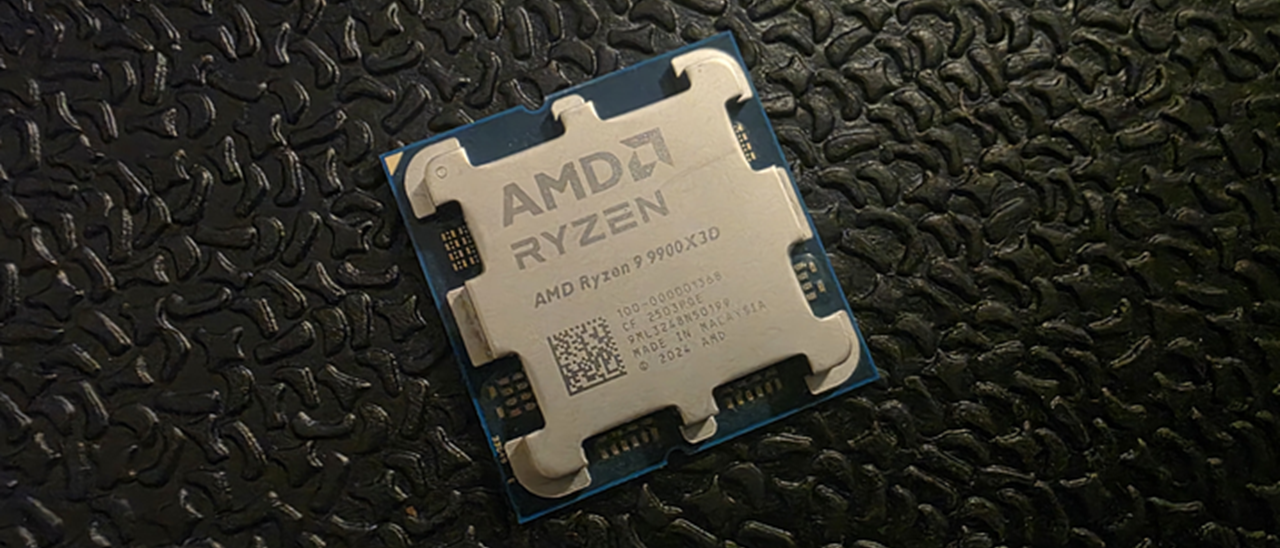Why you can trust Tom's Hardware
AMD Ryzen 9 9900X3D Productivity Benchmarks — The TLDR
This page covers a broad range of 'standard' desktop PC productivity applications, while the following page dives deeper into workstation-class workloads with SPECworkstation 4 benchmarks.
We boil down productivity application performance into two broad categories: single-threaded and multi-threaded. These slides show the geometric mean of performance in several of our most important tests in each of these categories, but be sure to look at the expanded results below for a more granular analysis.
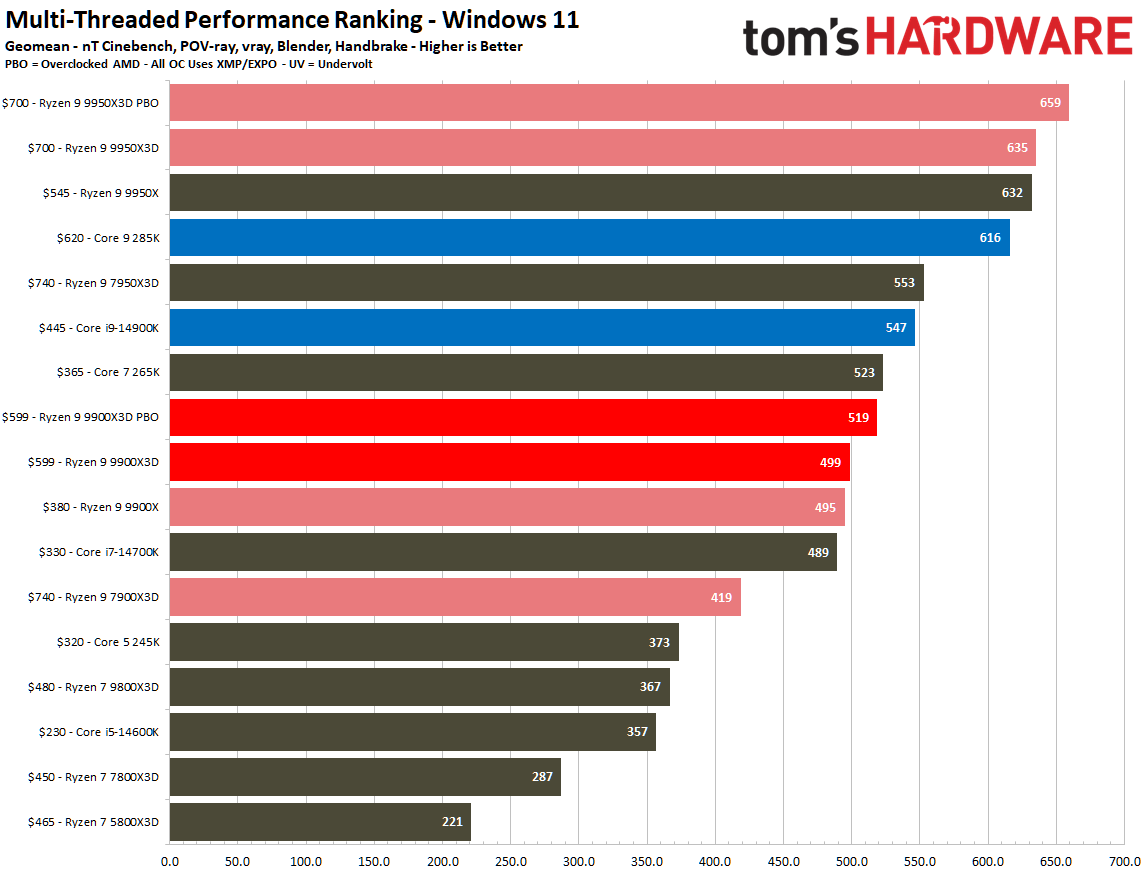

The $620 Core Ultra 9 285K is the $600 Ryzen 9 9900X3D's real competitor in productivity workloads; it delivers far more performance in threaded workloads than the Core i9-14900K. In our overall measurement, the Core Ultra 9 285K is 23% faster than the 9900X3D in threaded workloads, but the $445 Core i9-14900K is still an impressive 10% faster than the Ryzen 9 9900X3D.
In our cumulative single-thread performance measurement, the Core Ultra 9 285K is 7% faster than the 9900X3D, and the 14900K is 3.5% faster.
The $700 Ryzen 9 9950X3D remains the king of the productivity hill, delivering 27% more performance than the $600 Ryzen 9 9900X3D in heavily threaded apps, an advantage borne of the higher core count and 170W TDP. It also offers 3% more performance in lightly threaded applications due to its higher boost clock. This generally mirrors the performance deltas we saw between the last-gen Ryzen 9 models, too.
The 9950X3D's impressive amount of extra performance over the 9900X3D costs $100 more (17%). Again, spending an extra $100 when you're already considering the already expensive $600 Ryzen 9 9900X3D isn't much of a lift, and it delivers a tangible benefit. That's not to mention that the 9950X3D is much faster in gaming, too.
The Ryzen 9 9900X3D takes a slight lead in multi-threaded workloads over its counterpart, the Ryzen 9 9900X, which has the same number of cores but lacks 3D V-Cache tech, but the two chips jockey back and forth for the lead across our multi-threaded workloads, so the competition is close enough to call a tie. That makes the less expensive $380 Ryzen 9 9900X the obvious choice if you're only interested in productivity performance. Notably, the 9900X is ~2% faster in single-threaded work, perhaps due to better core residency in a few single-threaded workloads (the two chips have the same boost clock rates).
The Ryzen 9 9900X3D delivers a strong gen-on-gen improvement of 19% in heavily threaded applications and a 7% gain in lightly threaded workloads over the prior-gen Ryzen 9 7900X3D.
The 9900X3D can't quite keep pace with the 16-core Ryzen 9 7950X3D in threaded work, but it comes close — the 7950X3D is surprisingly only 7% faster in threaded workloads despite having 33% more cores. The 9900X3D is about 6% faster in single-threaded work than the 7950X3D, though, showing the benefits of the Zen 5 architecture's higher instruction per cycle (IPC) throughput.
Our simple PBO overclock yielded a 7% boost for the 9900X3D in threaded workloads with minimal fuss, and we also included those results in the albums below. We gained 5% when overclocking the Ryzen 9 9950X3D. Remember, the Intel processors would also benefit from overclocking, but this would require far more manual intervention.
As a side note, we have long included the y-cruncher benchmark in our cumulative measurement of threaded performance. However, this heavily-threaded AVX-512 benchmark recently received tuned optimizations that deliver explosive gains for the Ryzen 9000 processors, but the massive deltas don't generally align with what we see in actual AVX-512-enabled applications. As such, we've removed the benchmark from our overall calculation, but you can still see the individual results below.
Rendering Benchmarks
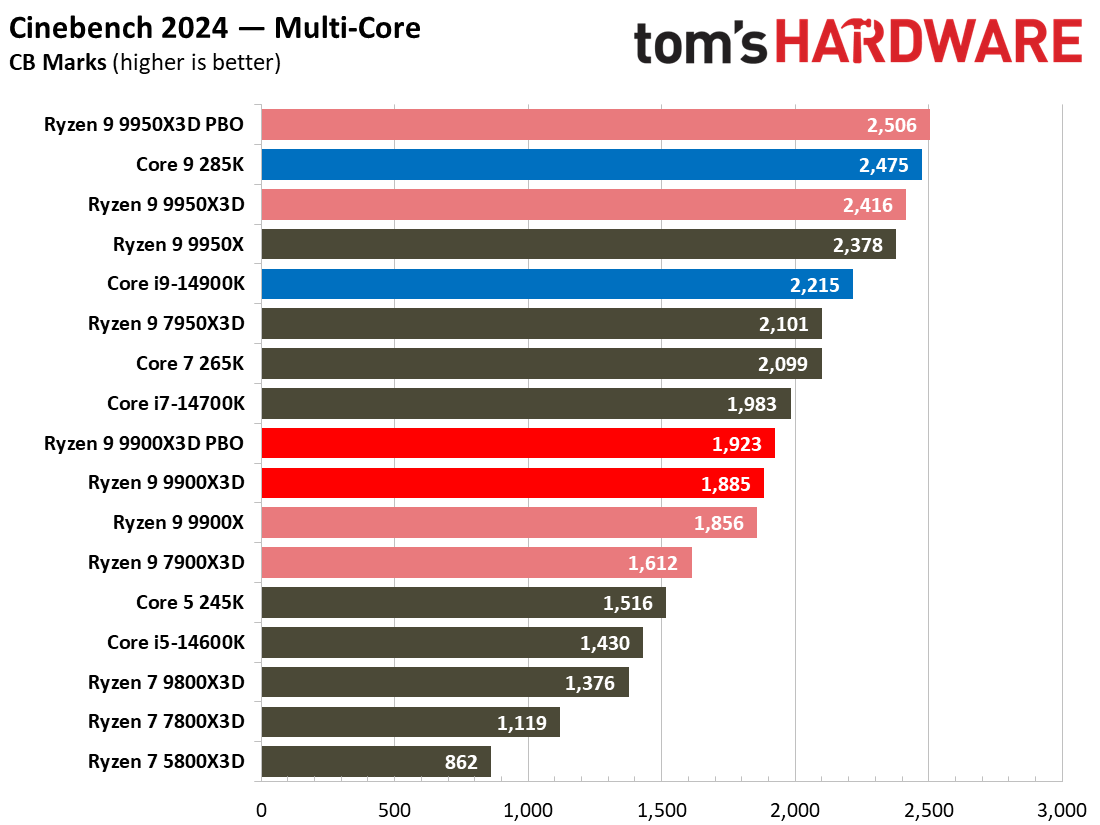
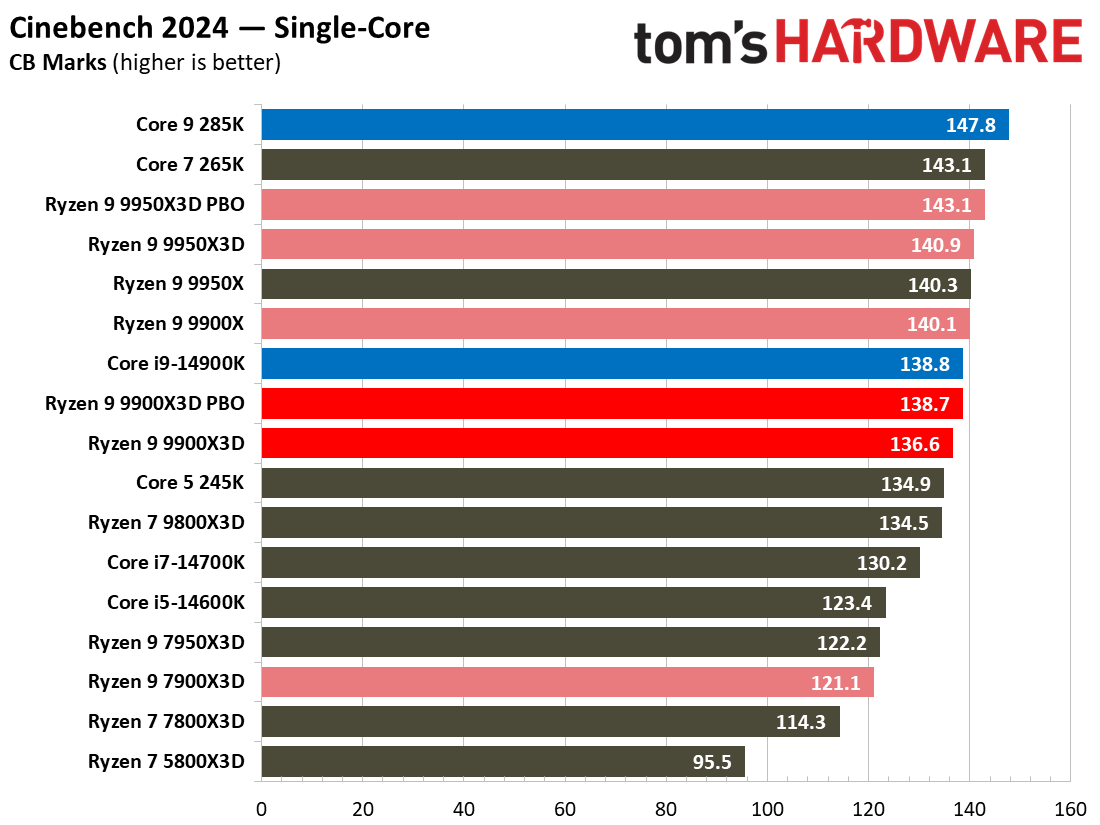
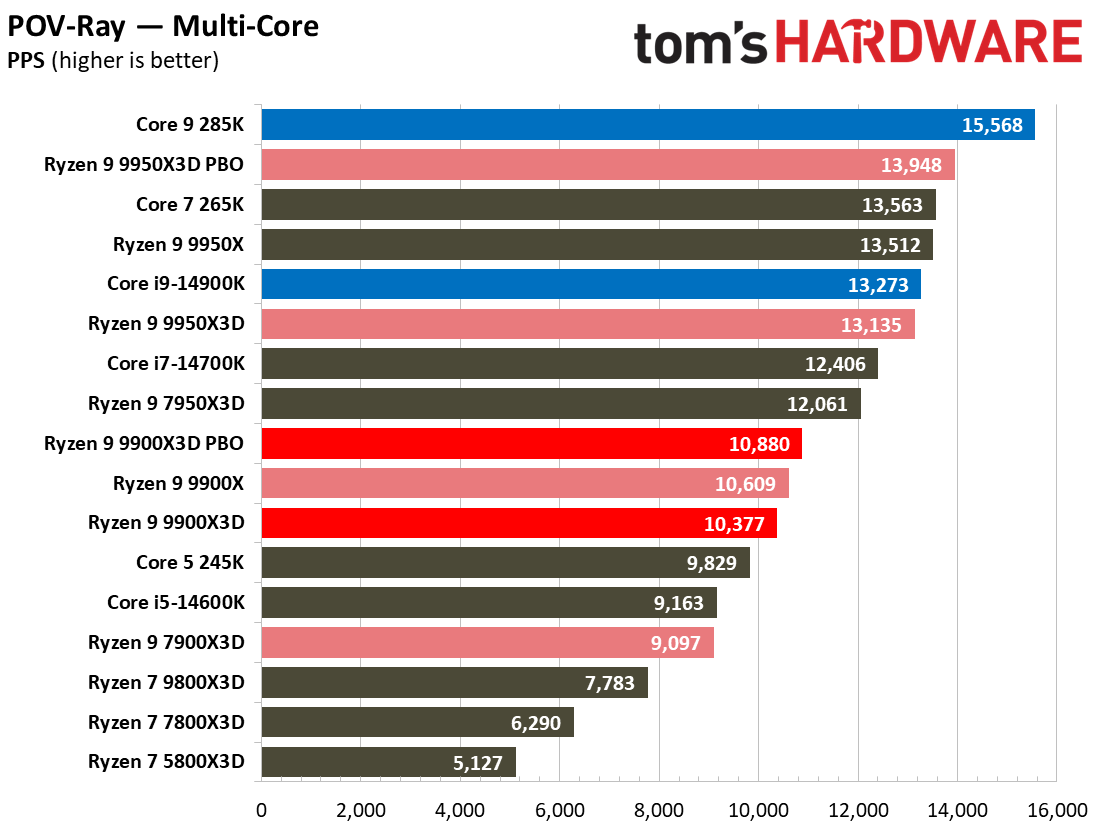
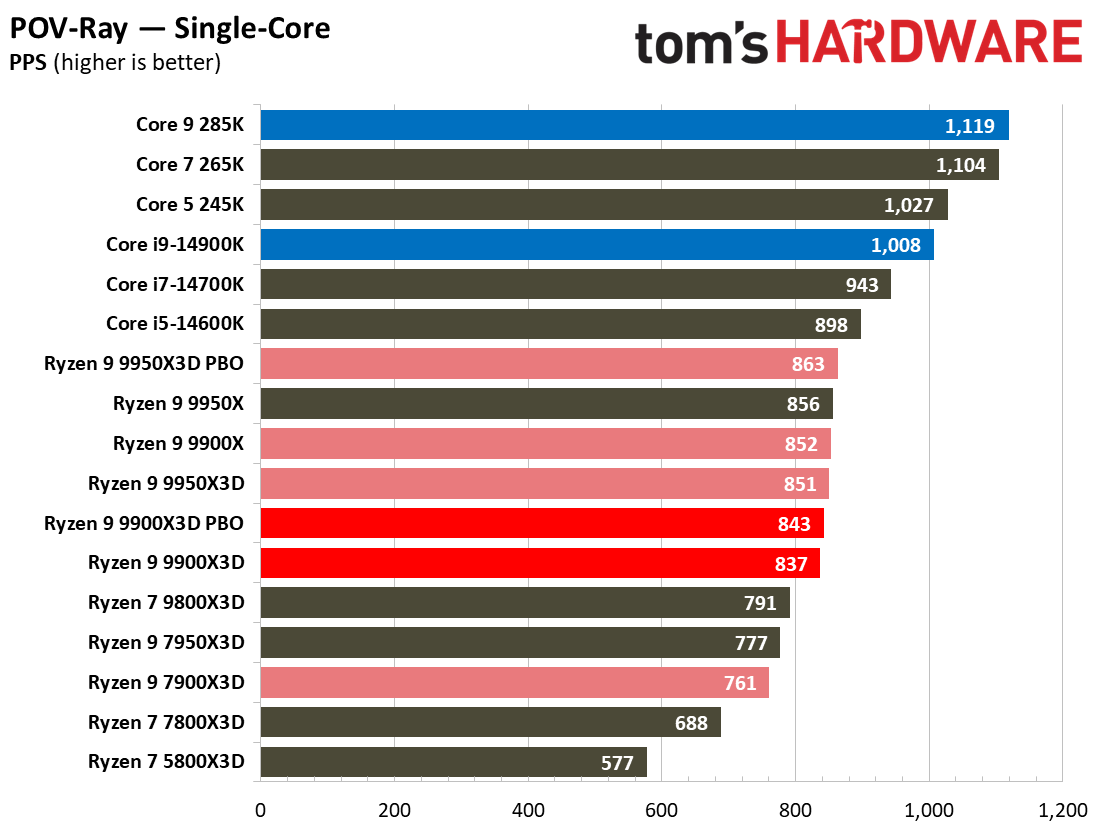
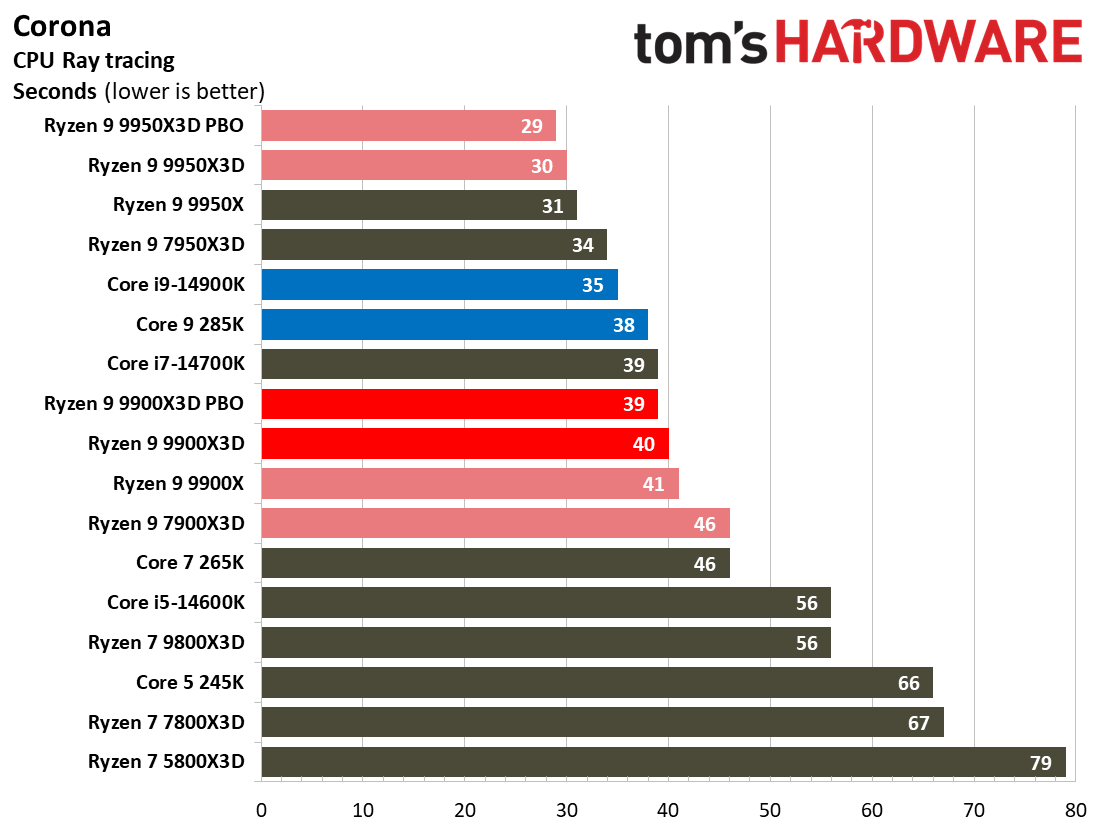
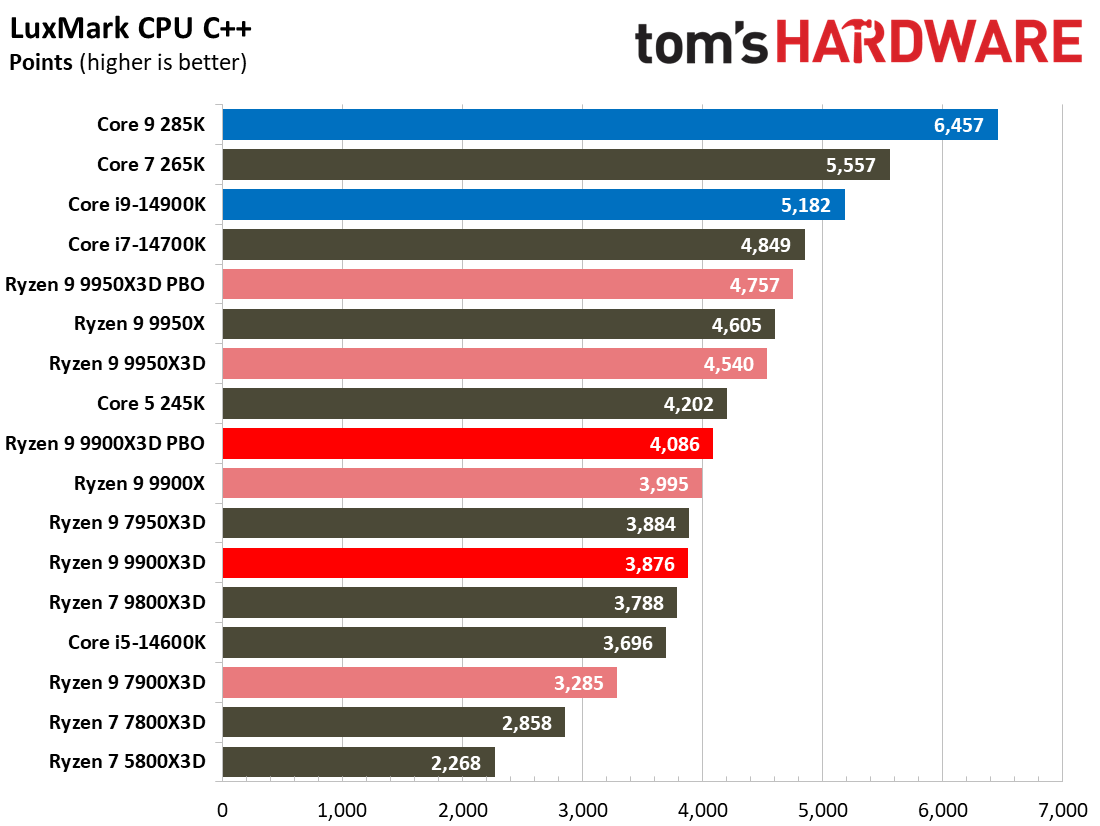
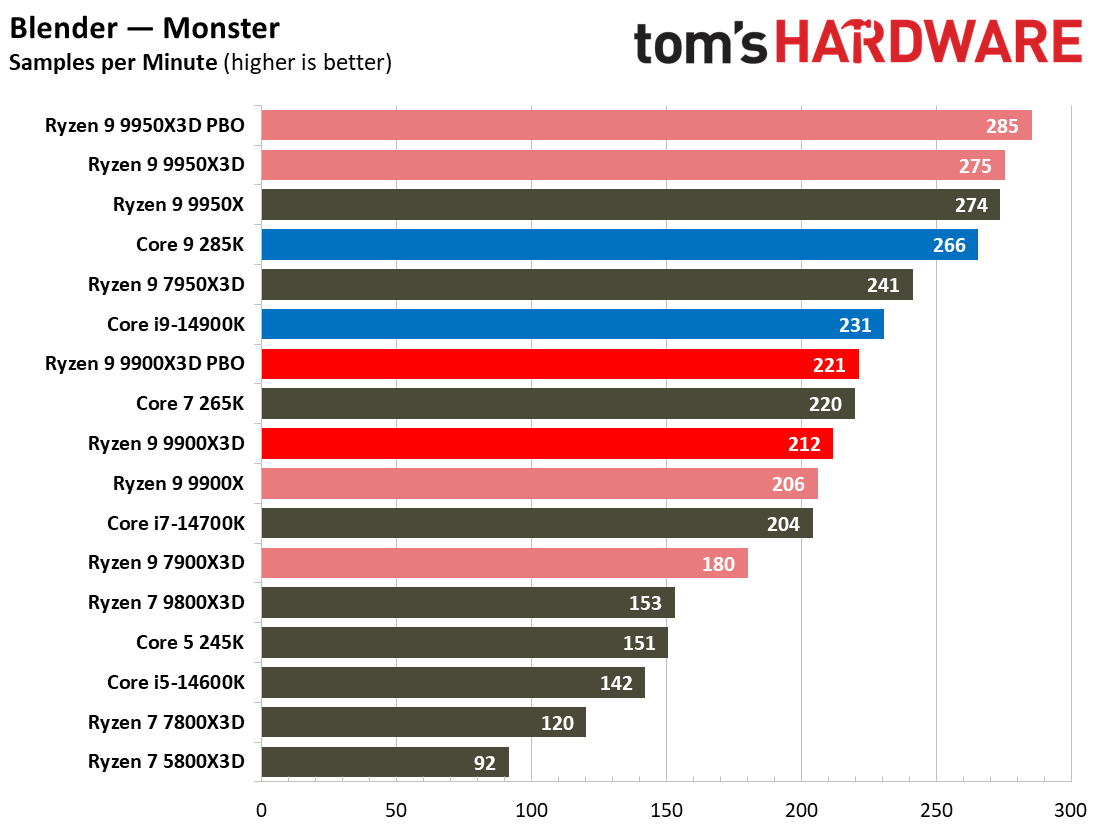
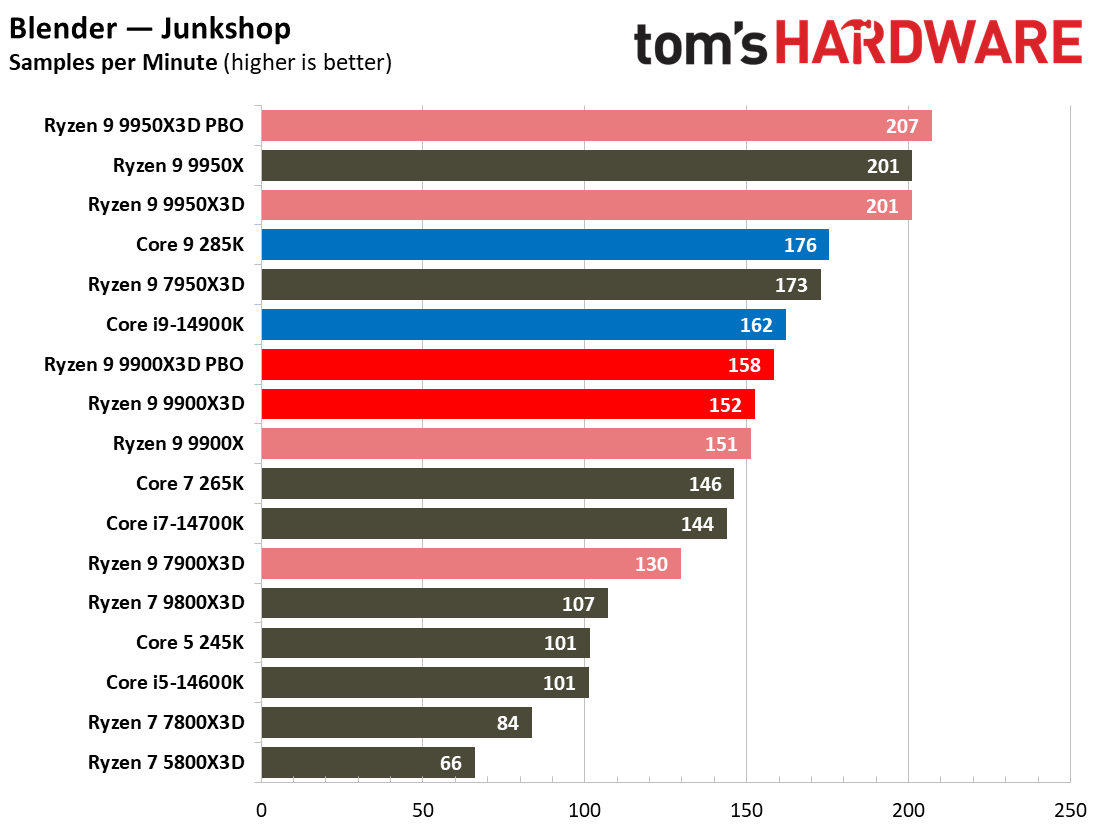
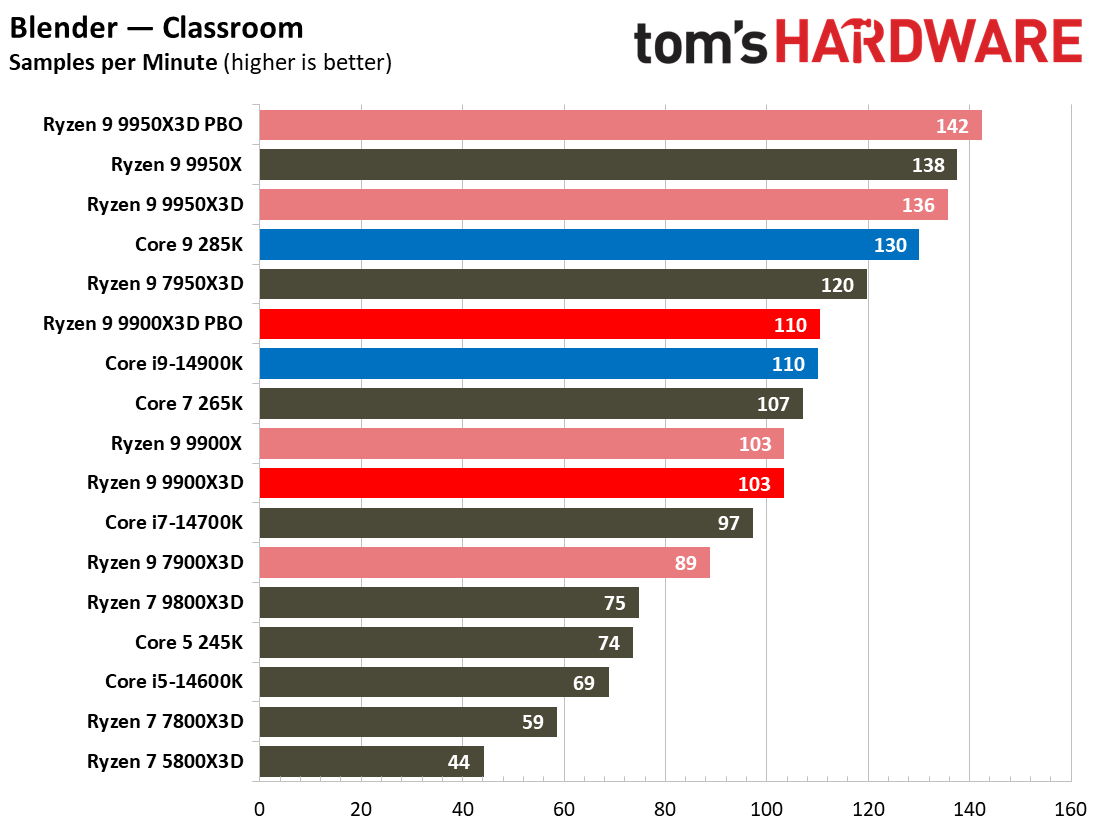
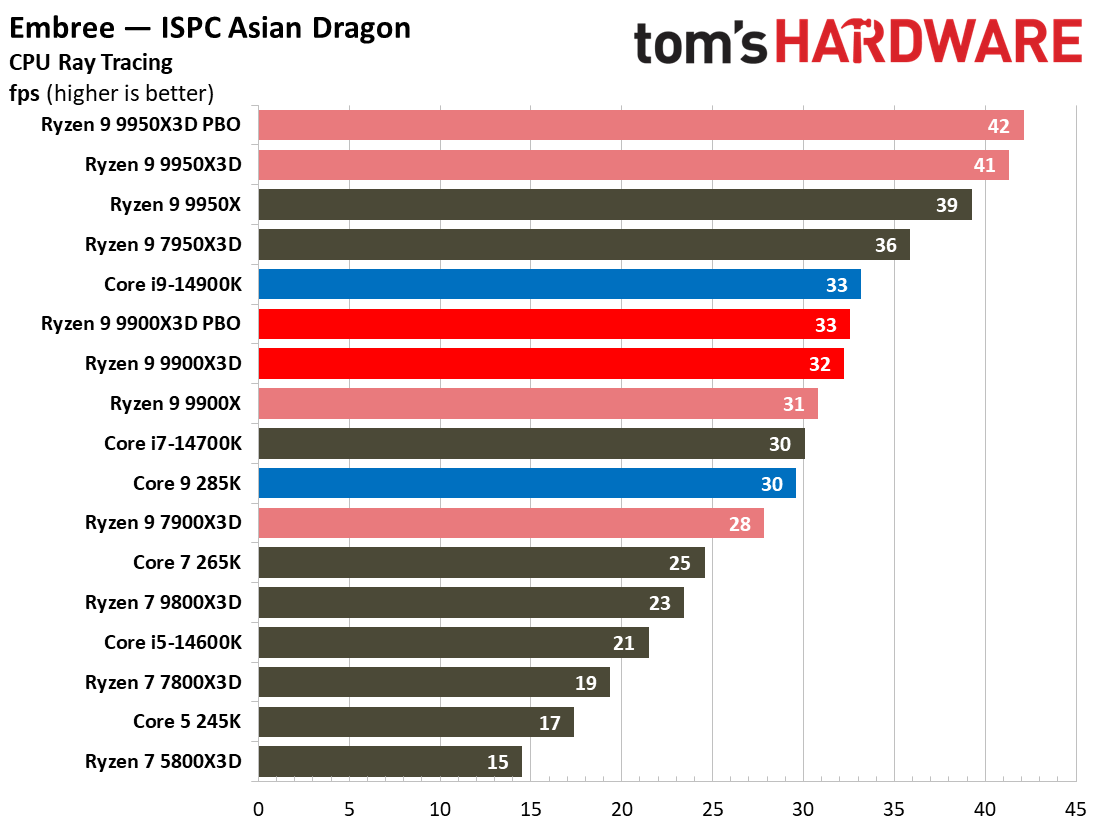
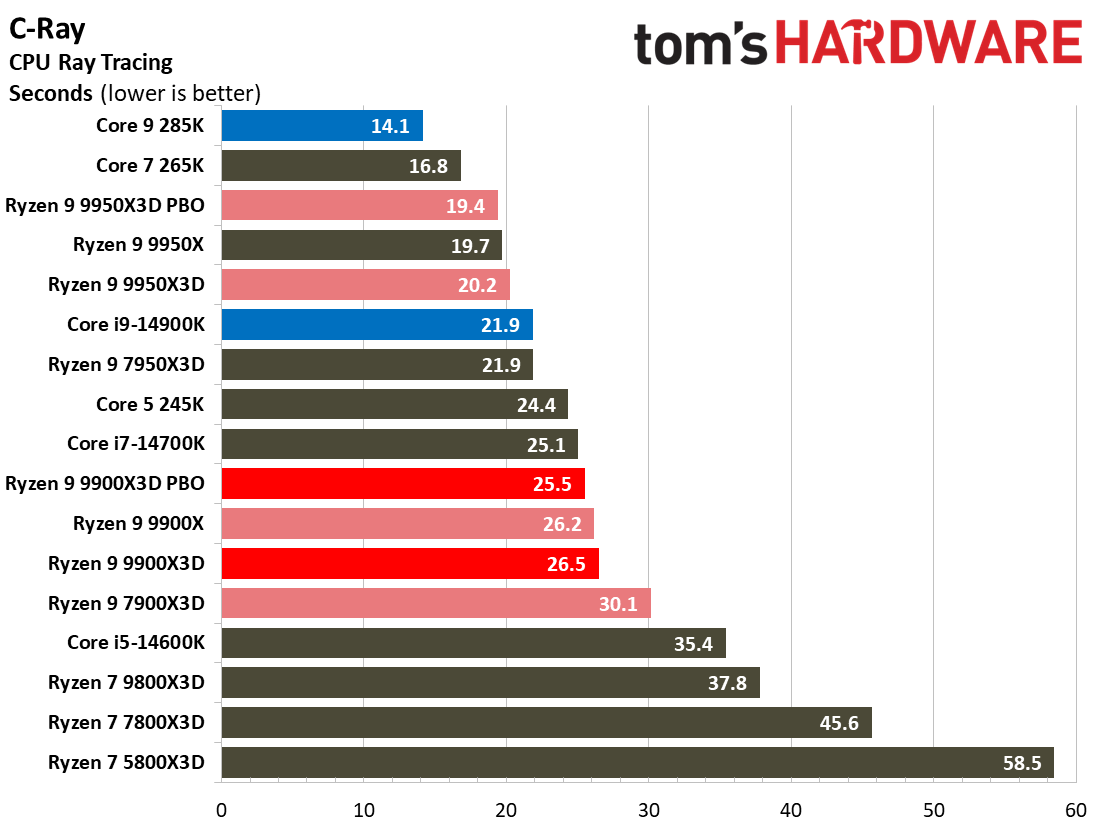


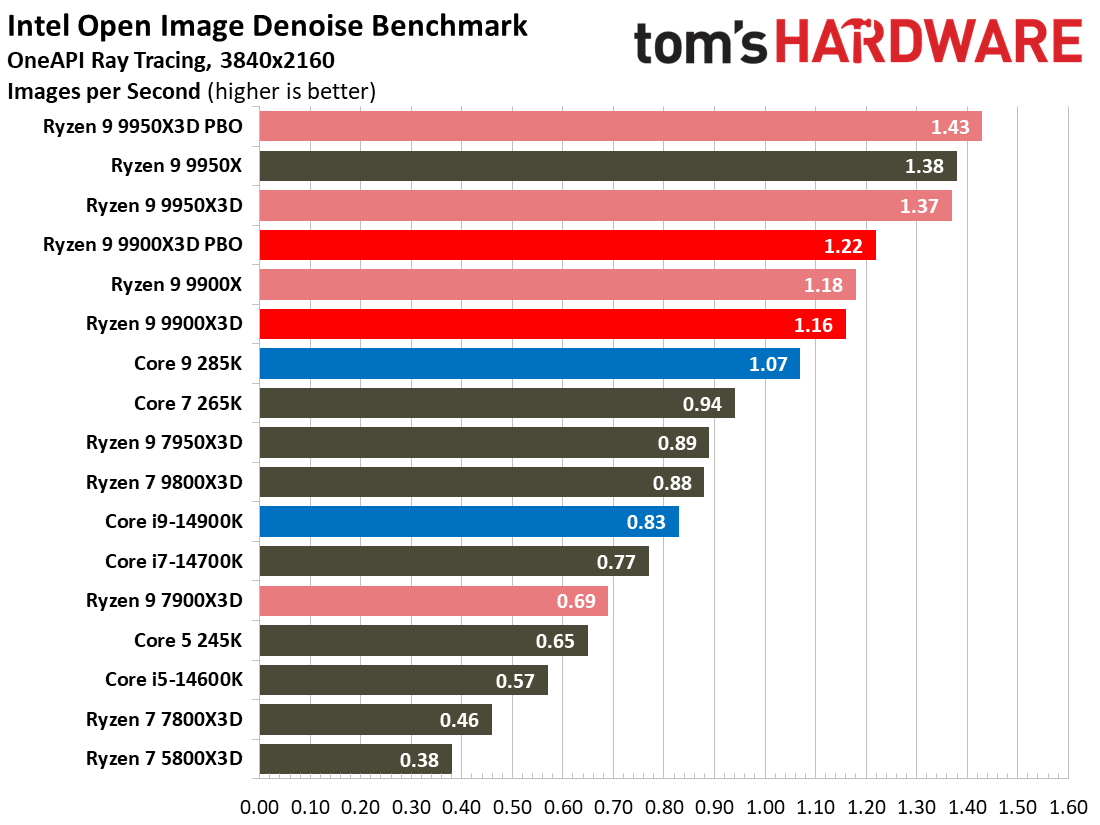
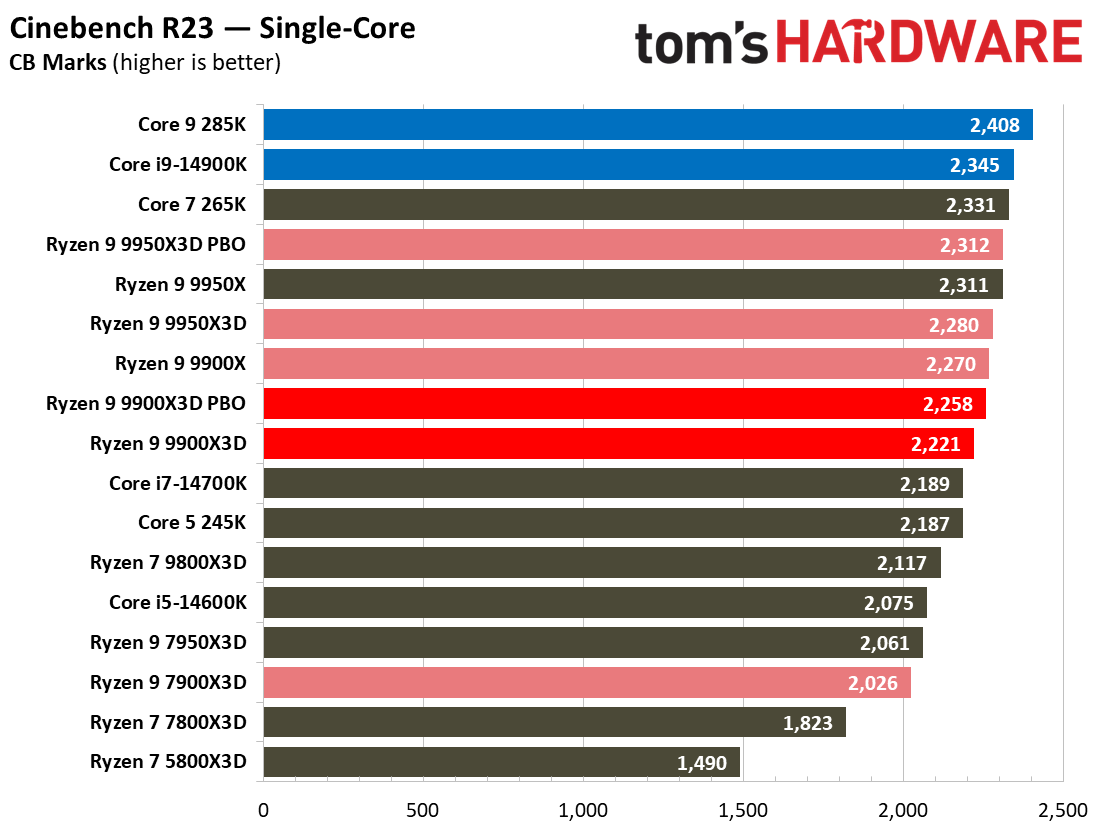
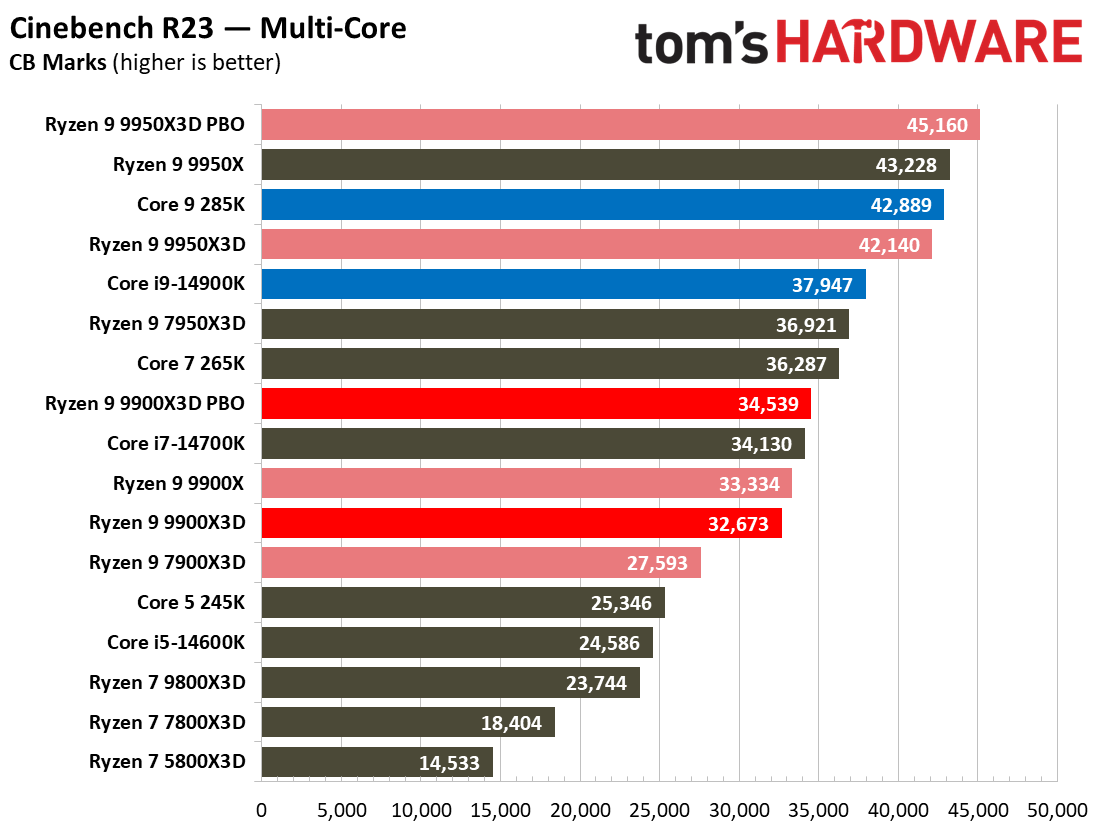
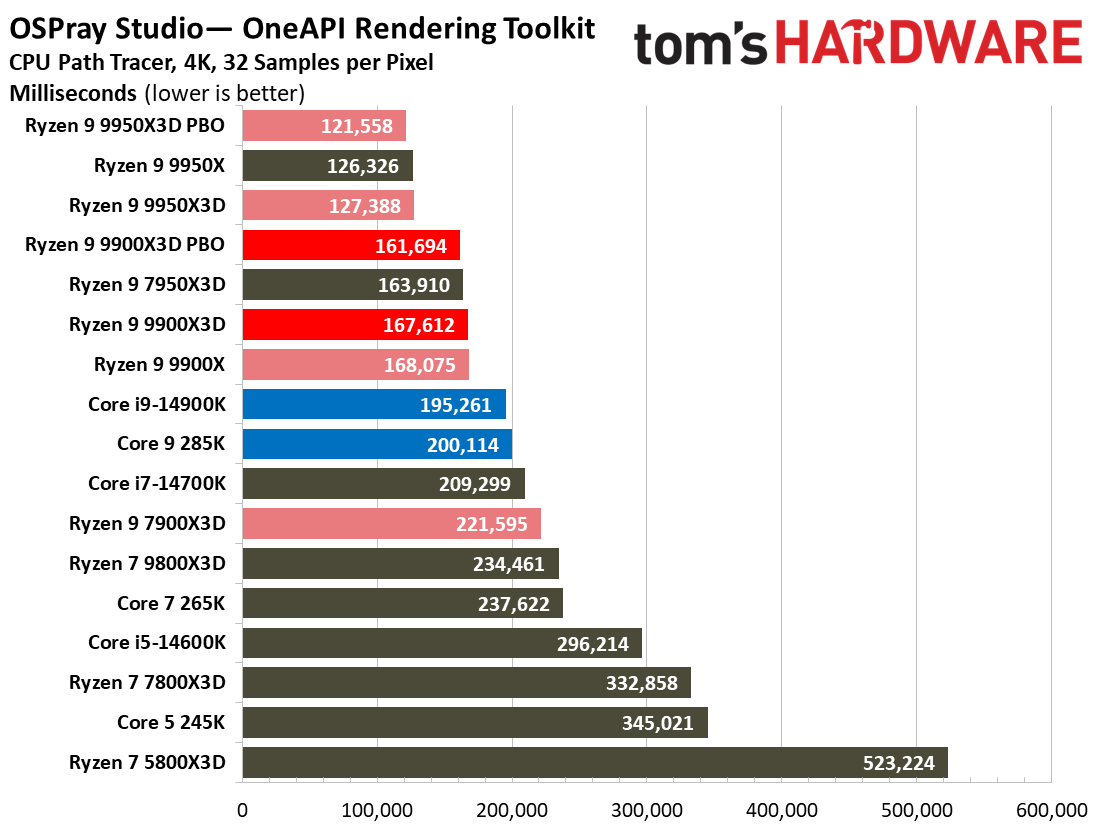
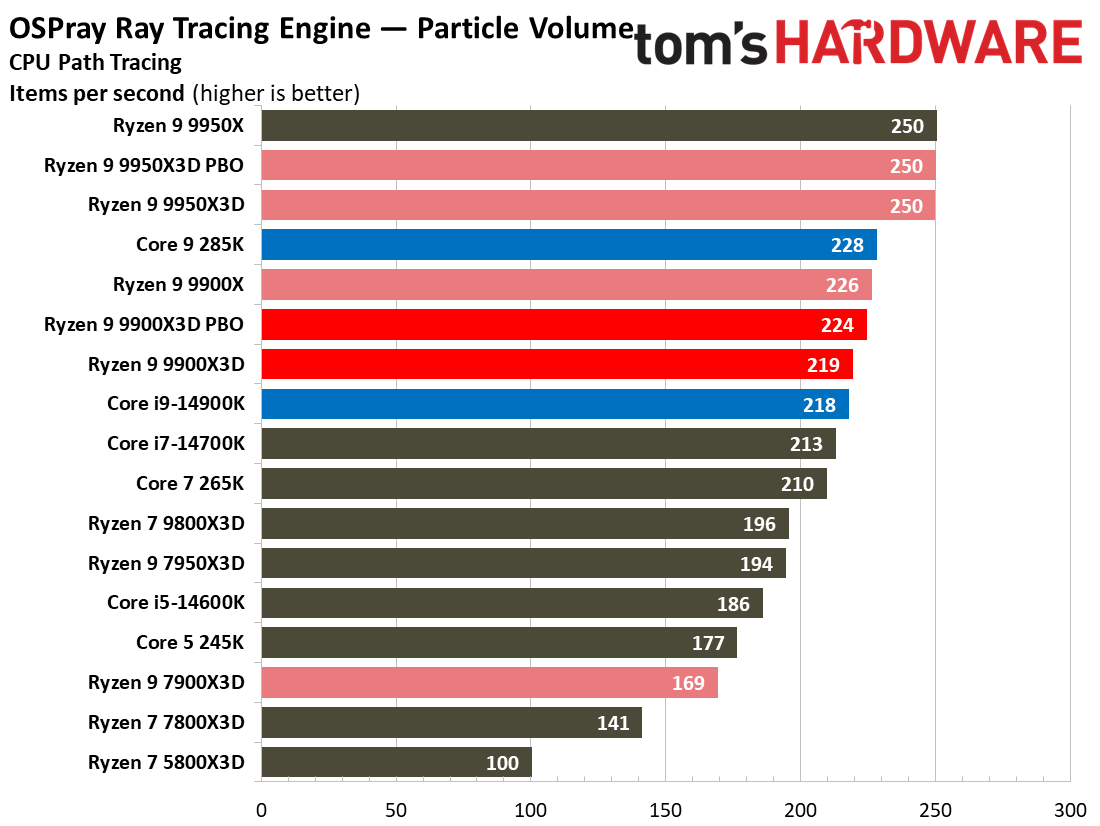
The Core i9-14900K matches or beats the 9900X3D in nearly all rendering workloads but at a much lower price point. Meanwhile, the Arrow Lake Core 9 285K dominates the Ryzen 9 9900X3D by much larger margins.
The Ryzen 9 900X3D delivers strong gains in some workloads from the PBO feature, and we also notice there's often only a slim difference between the 9900X and 9900X3D.
Encoding Benchmarks
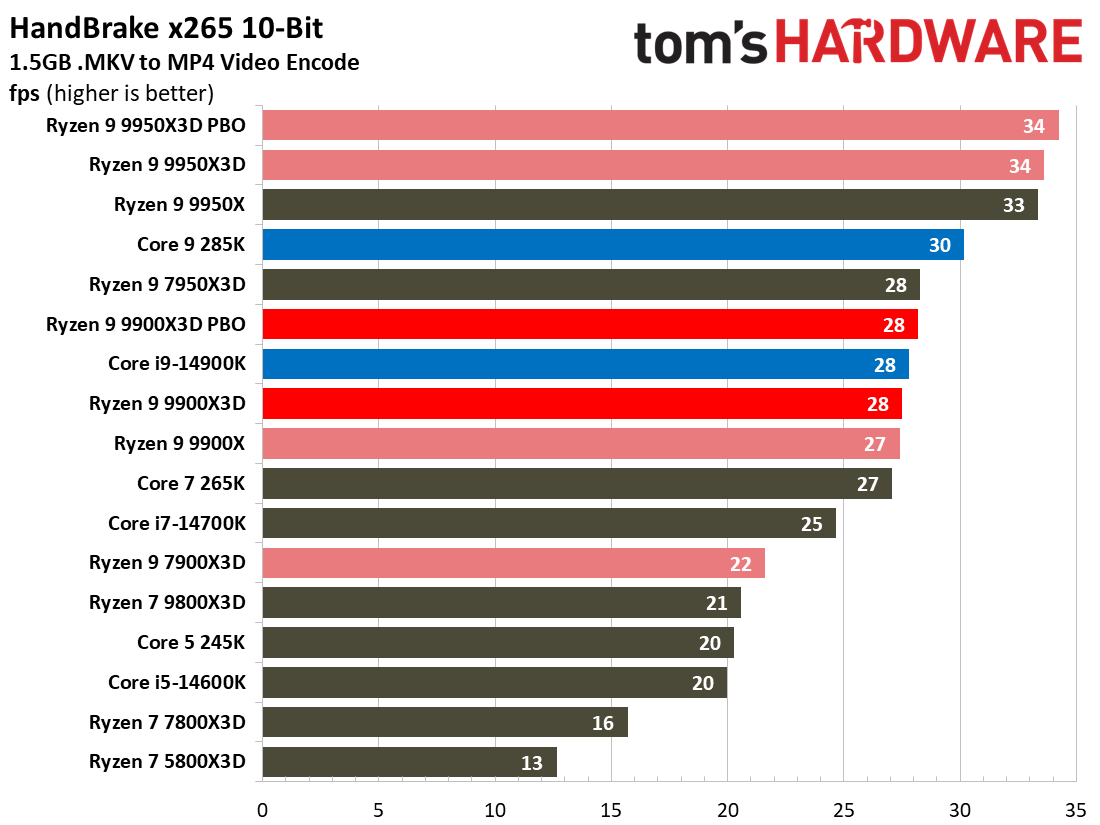
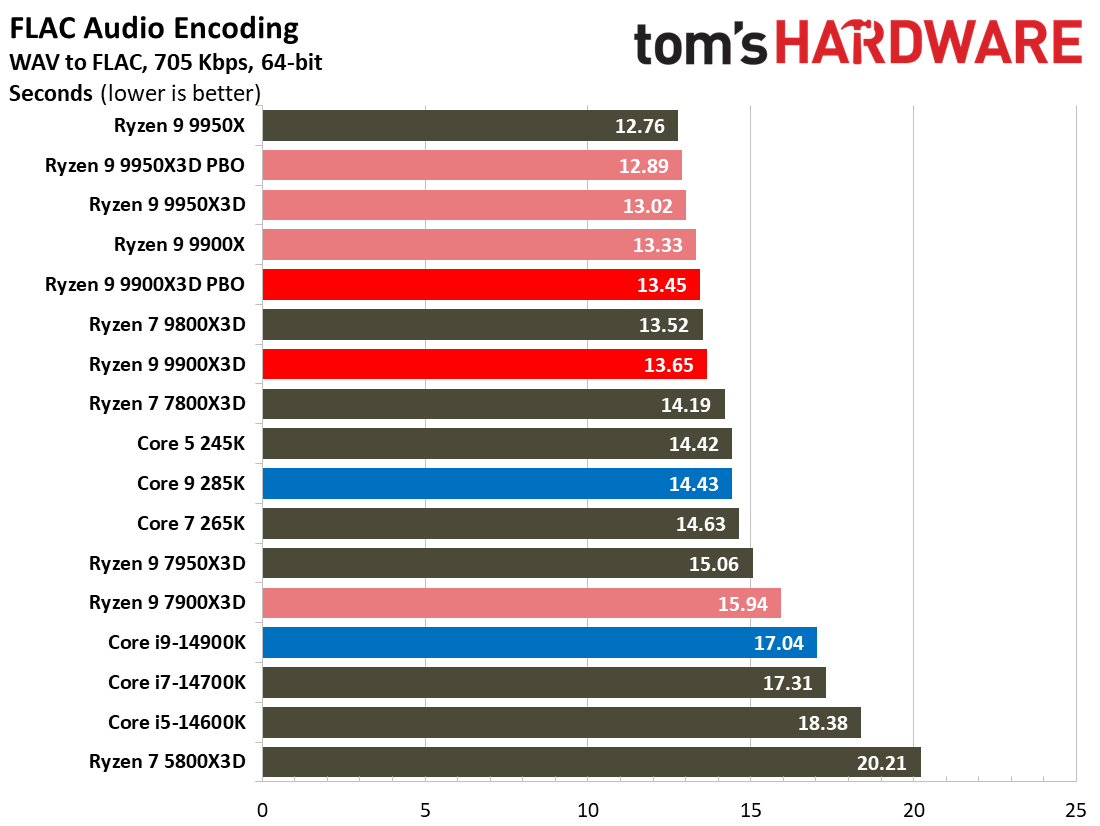
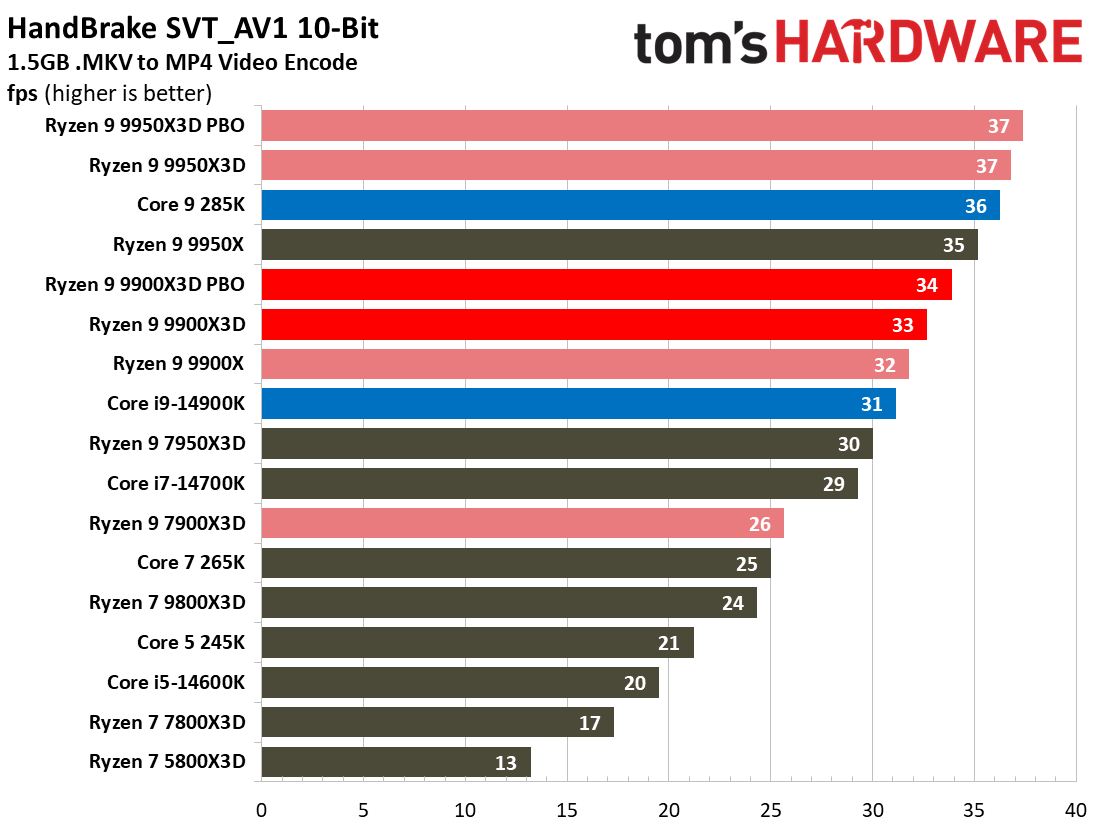
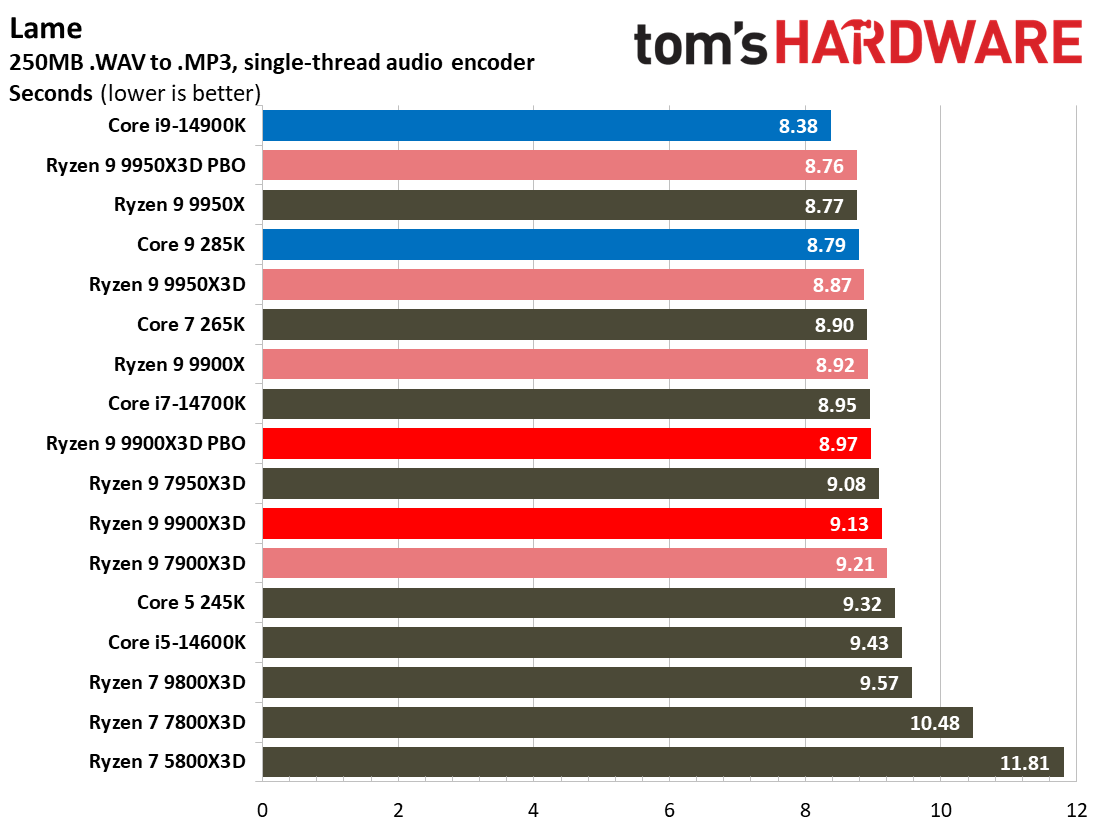
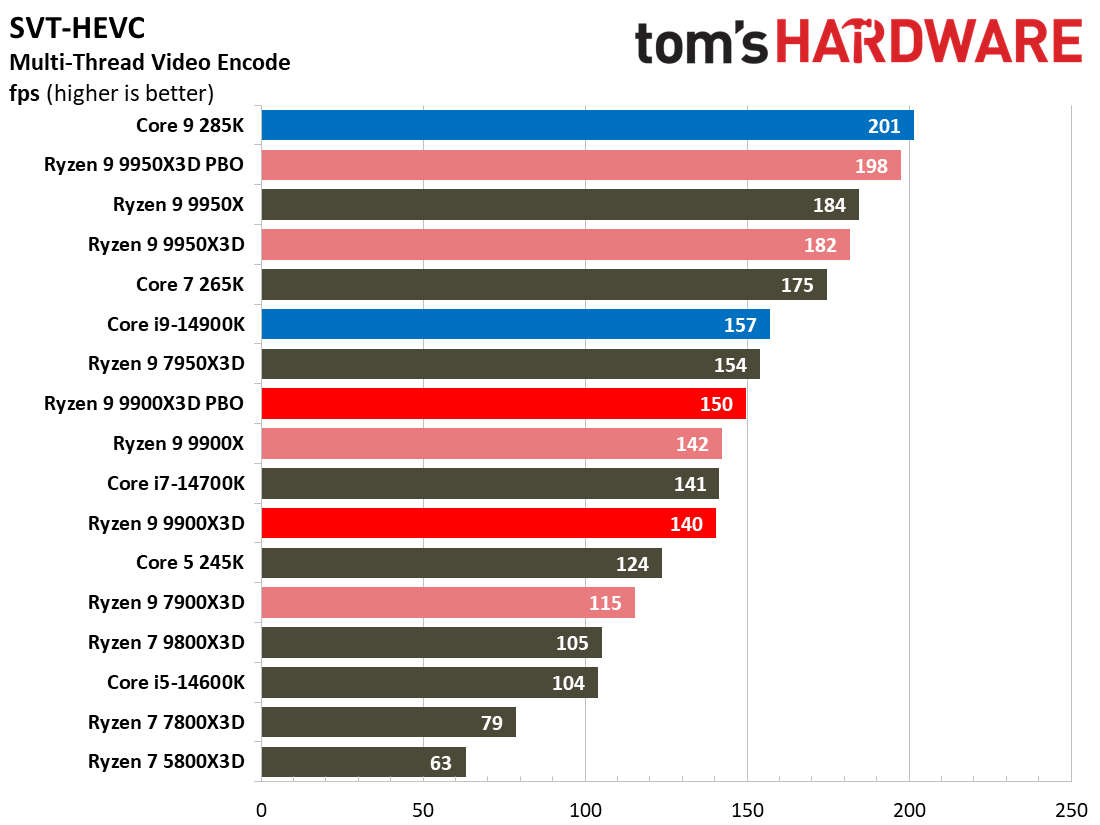
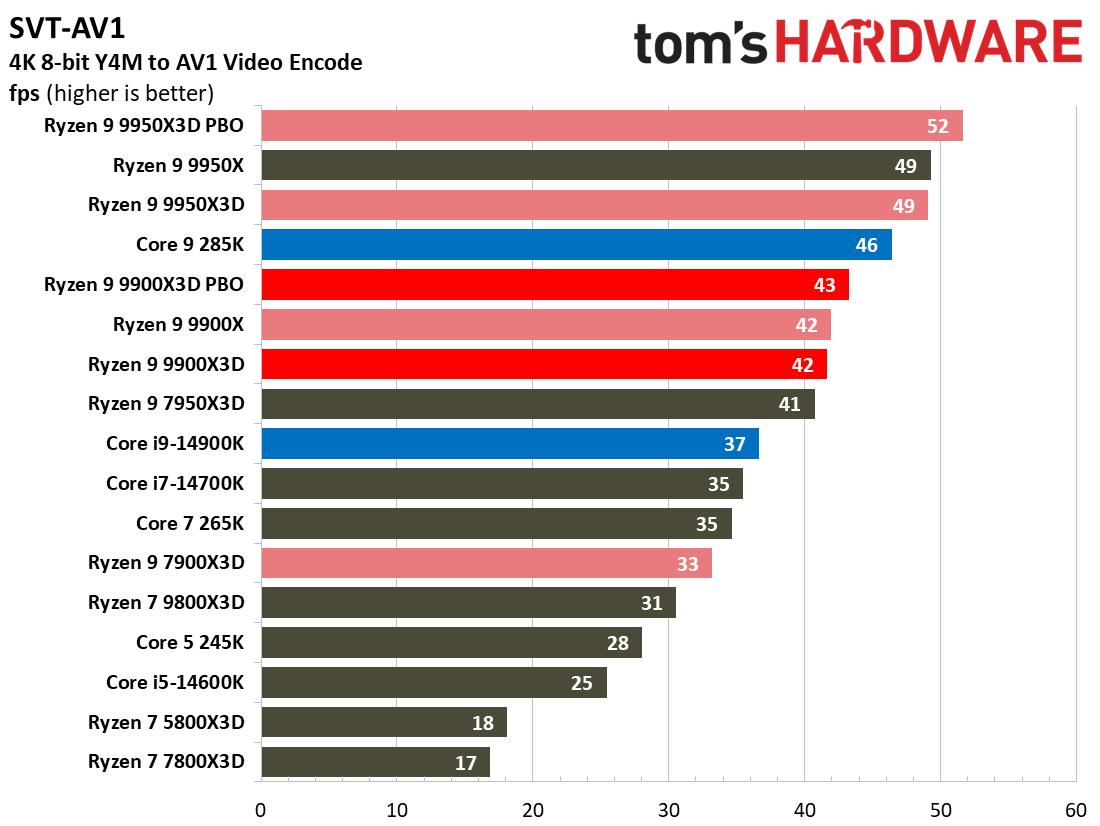
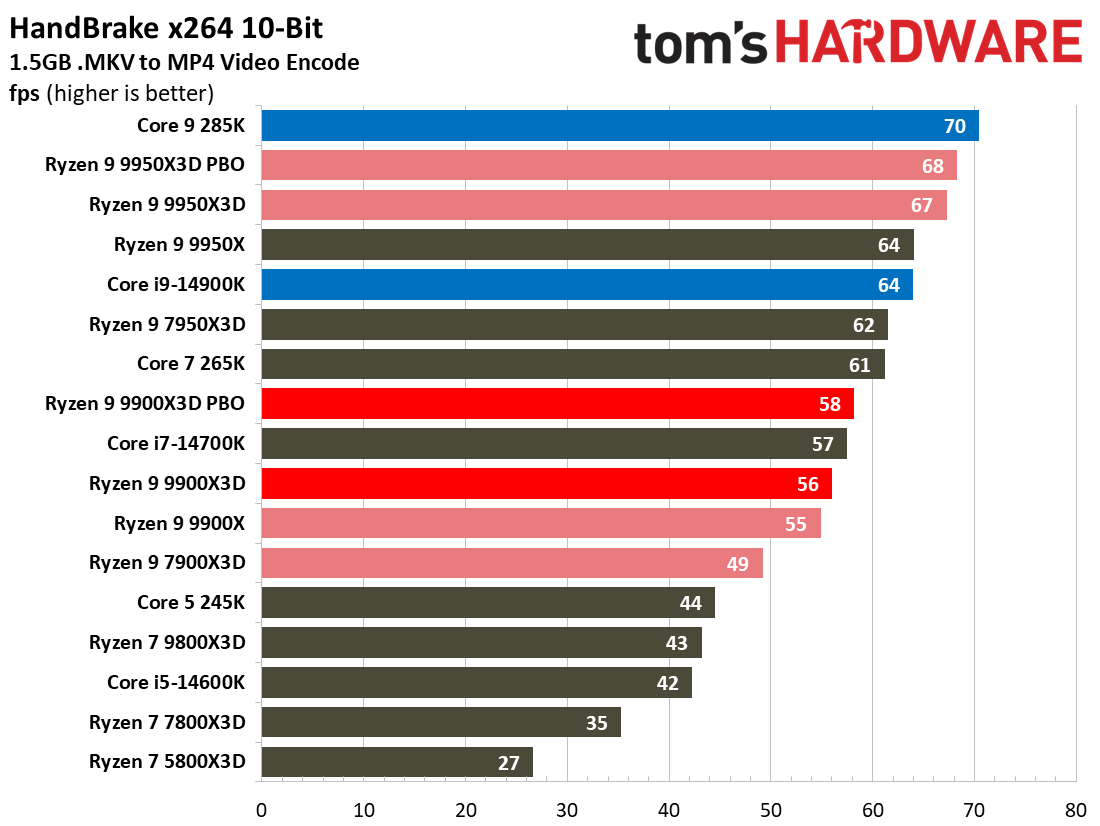
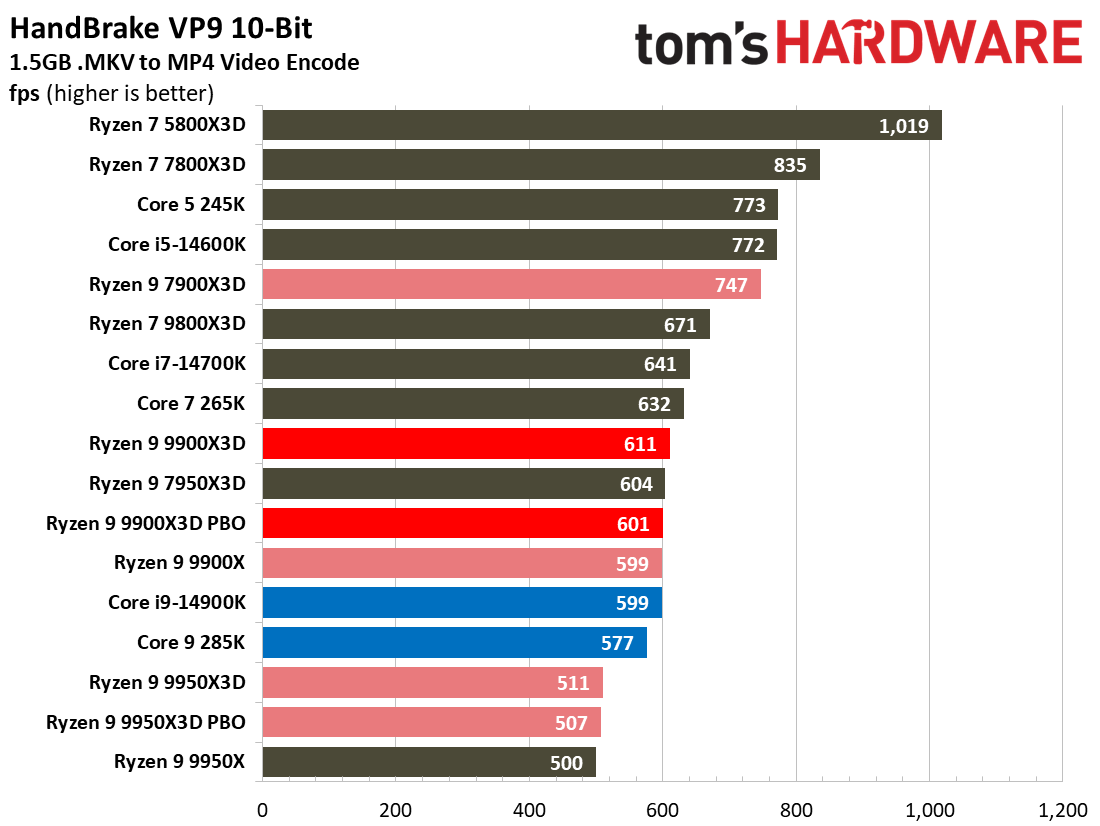
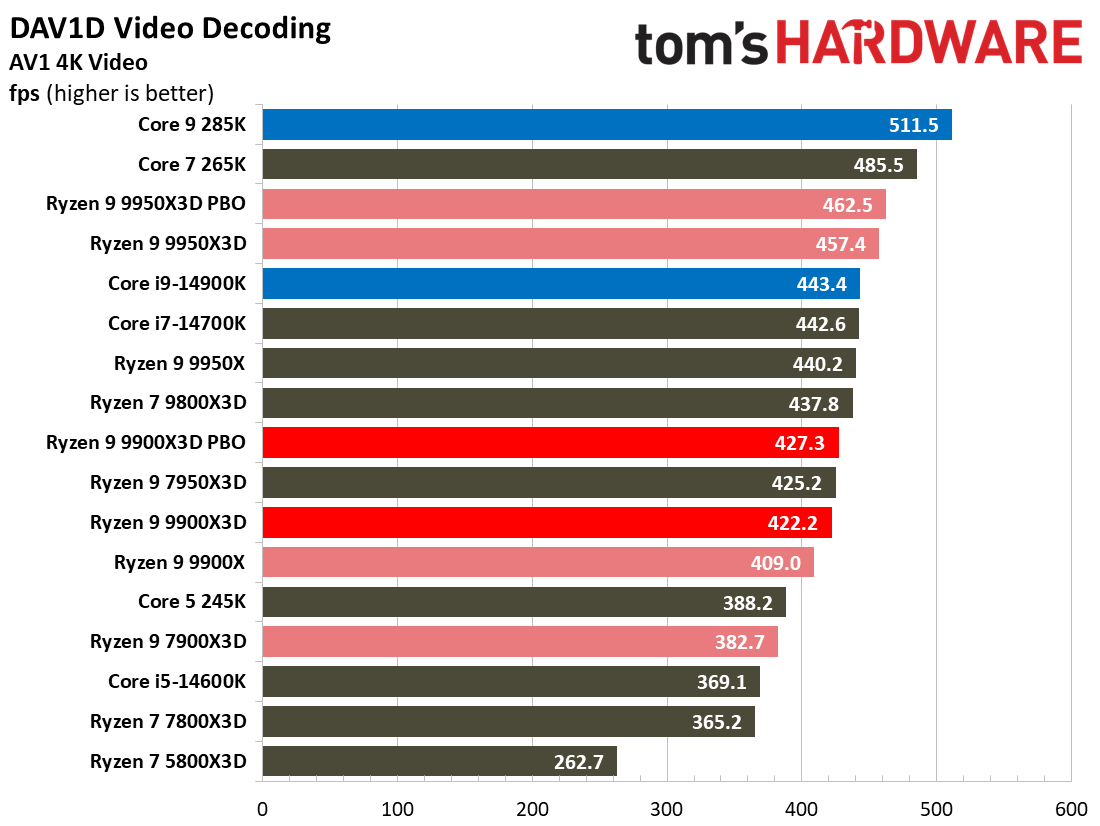
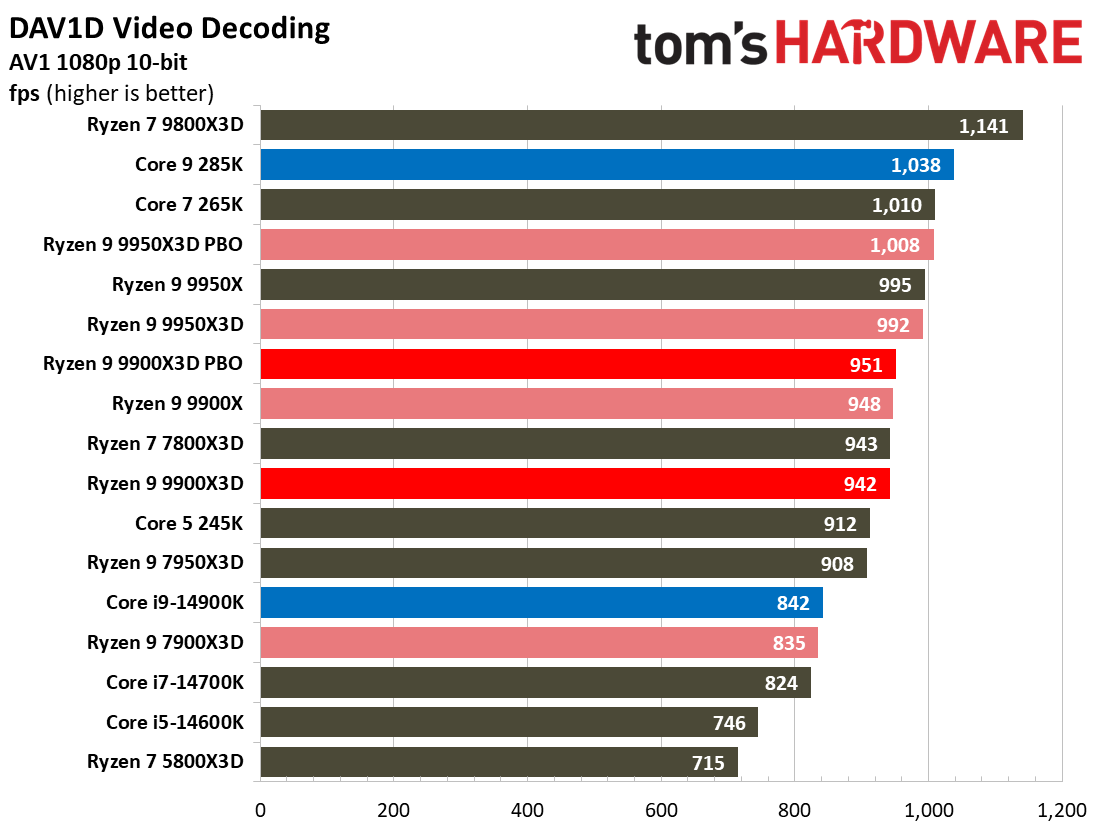
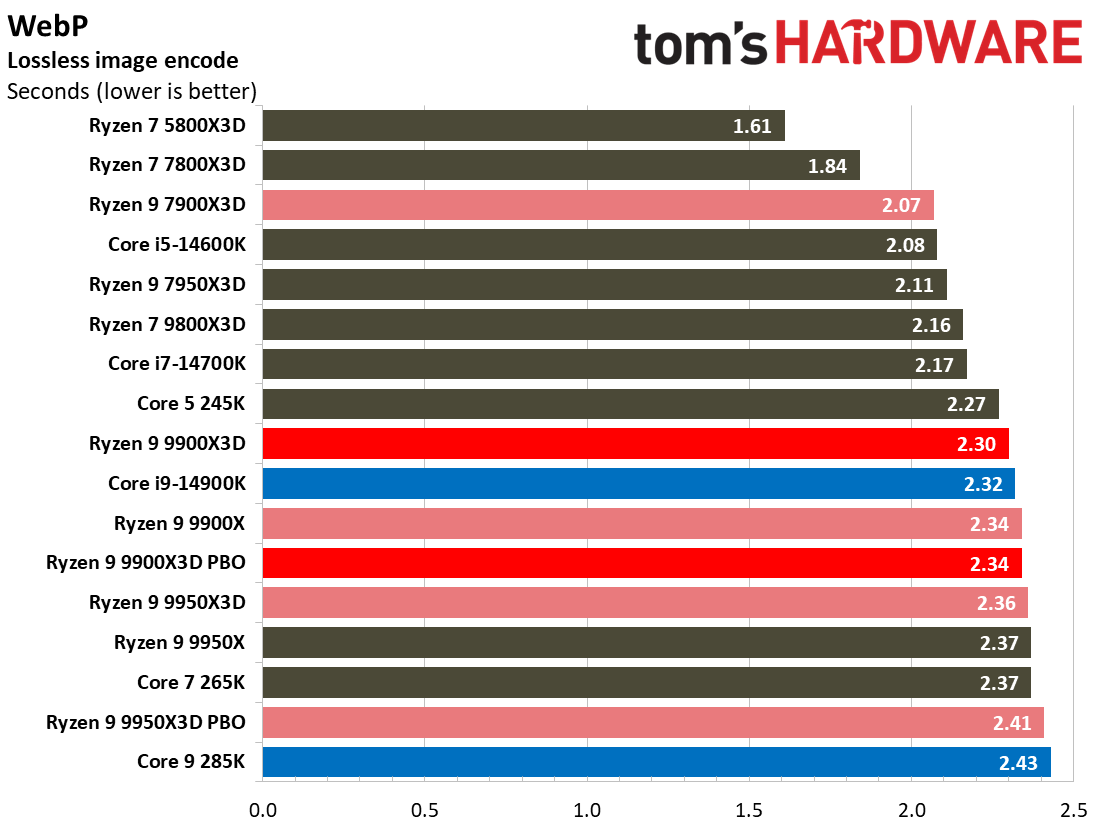
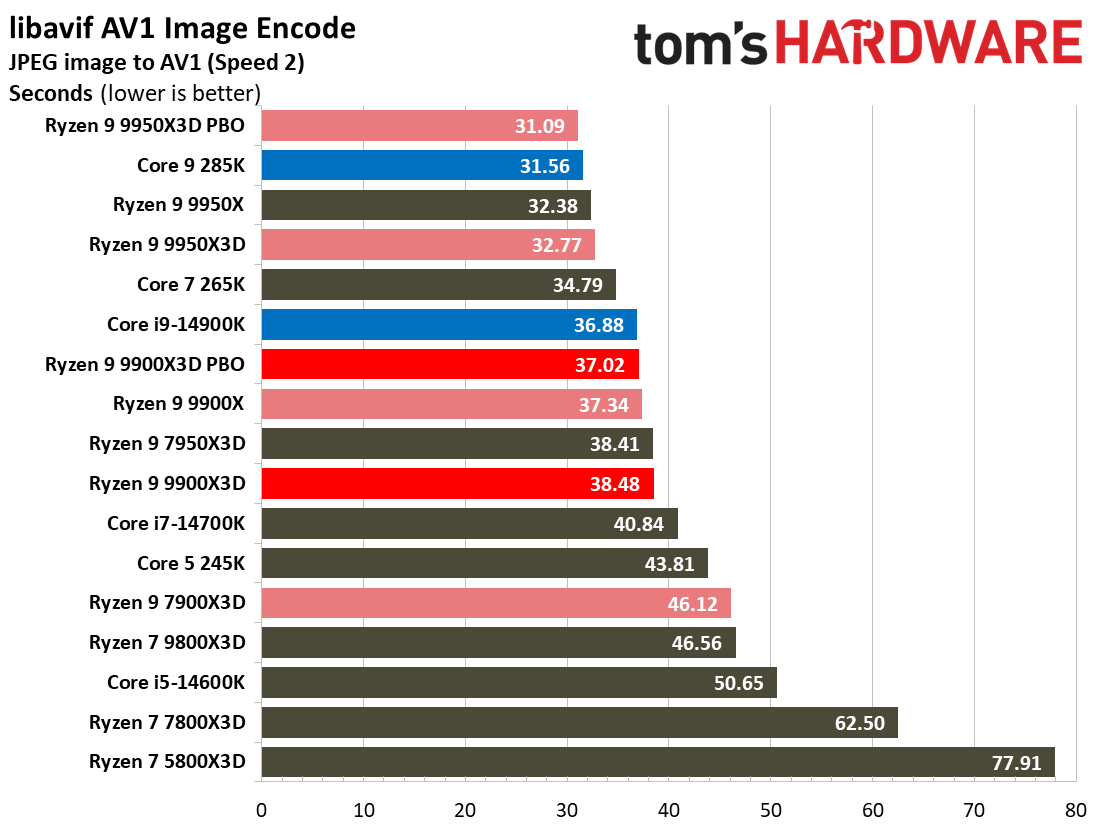
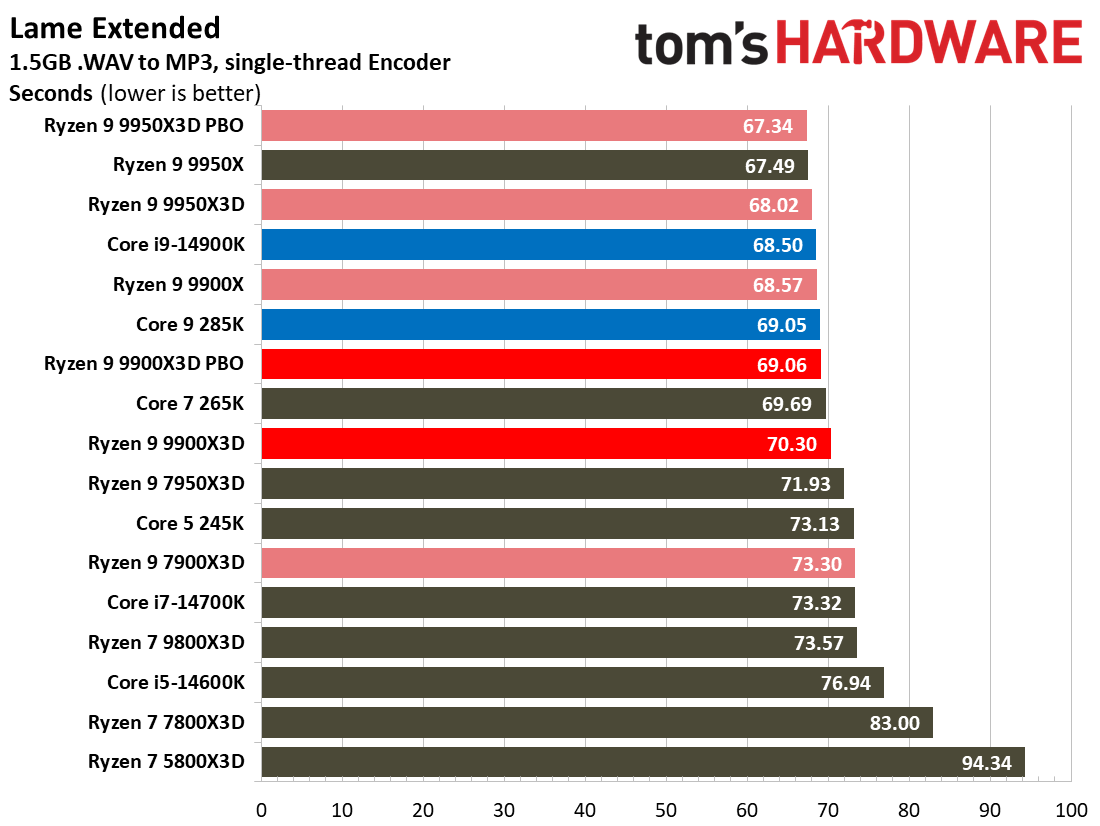
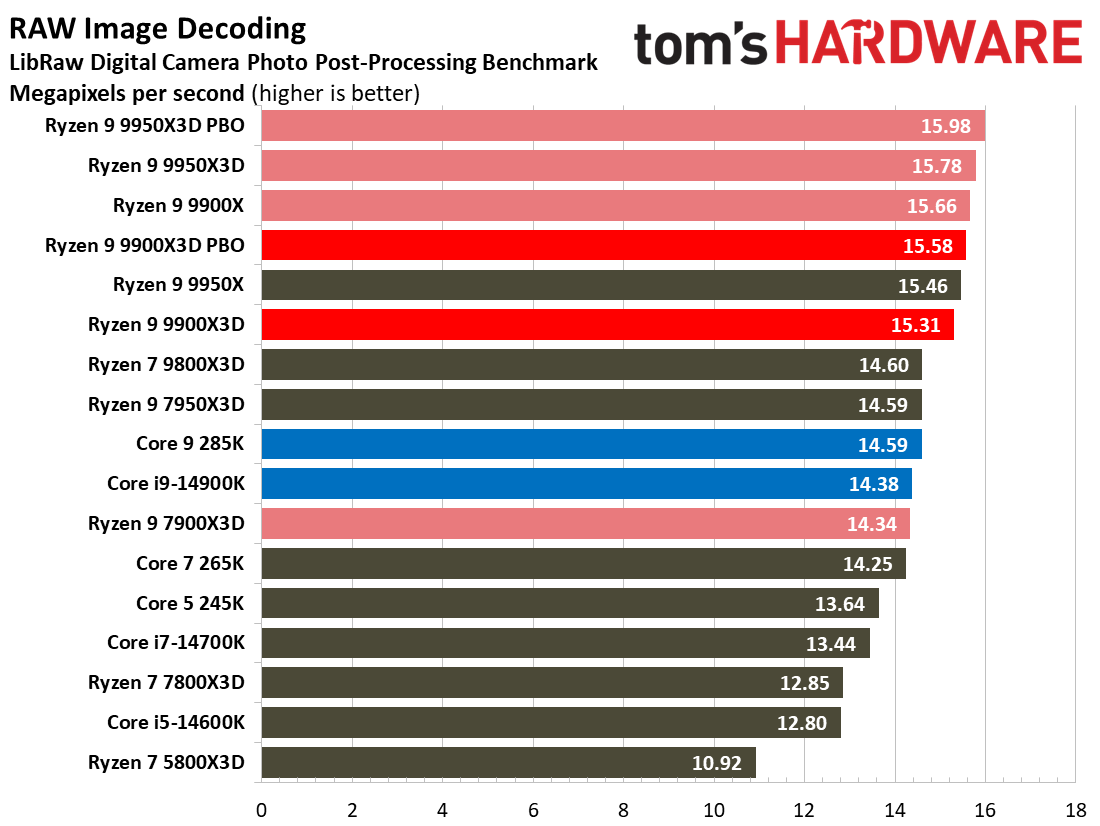
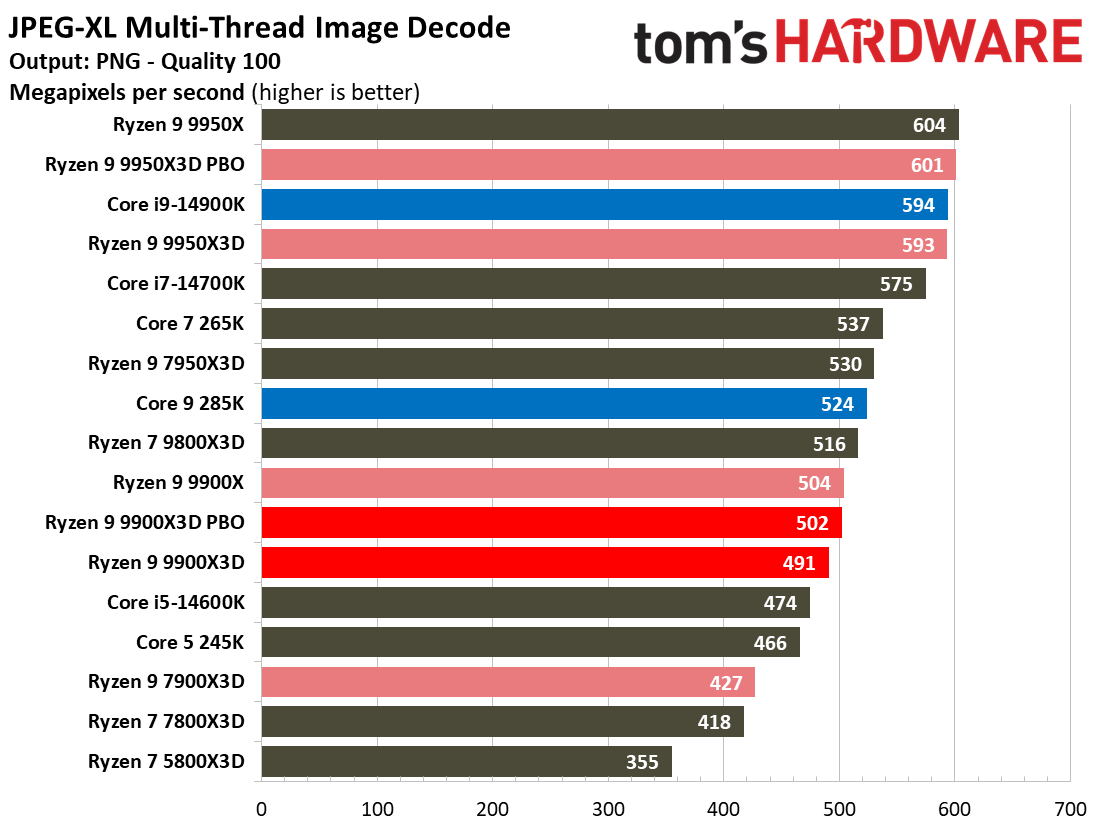
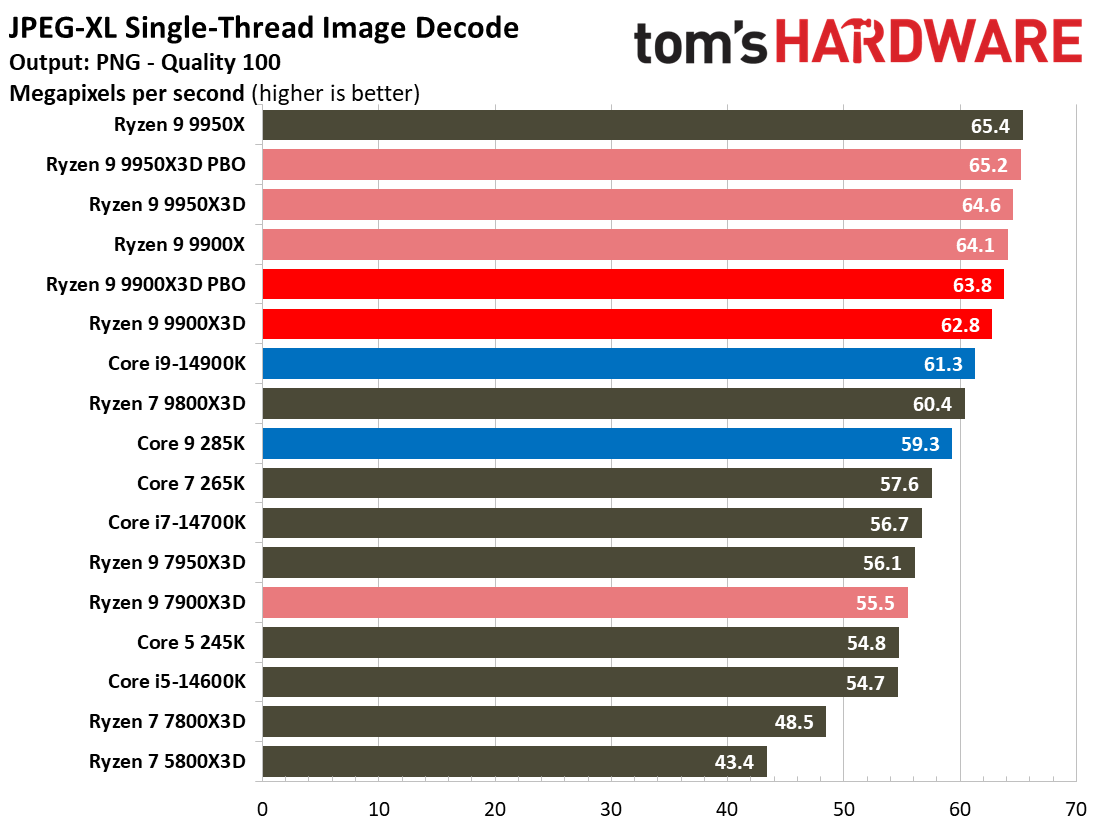
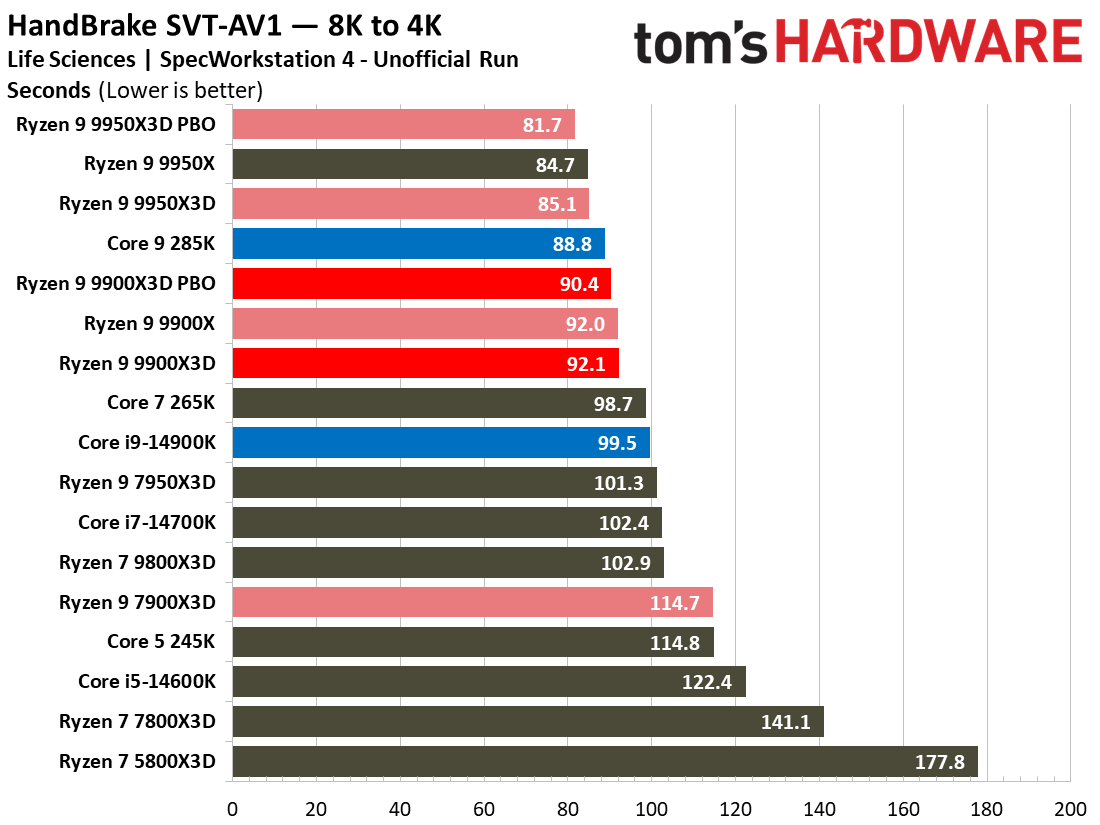

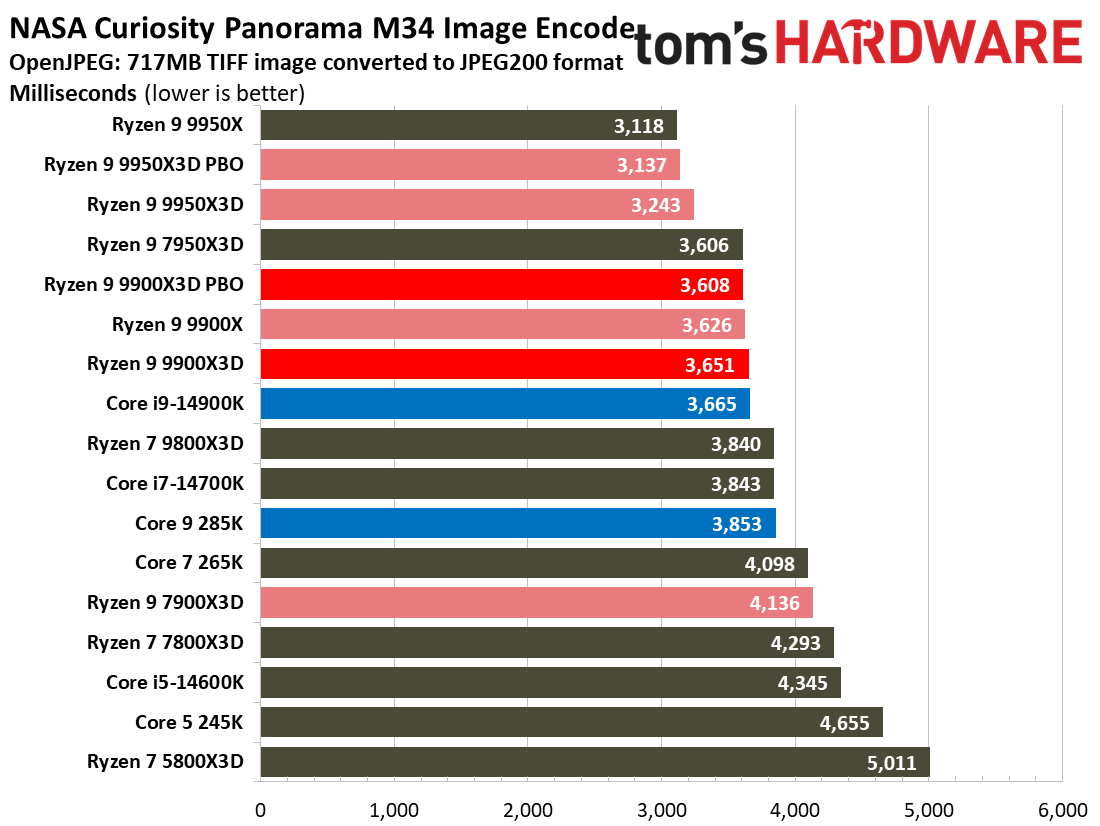
Most encoders tend to be either heavily threaded or almost exclusively single-threaded — and it takes an agile chip to master both disciplines. Handbrake, SVT-HEVC, and SVT-AV1 serve as our threaded encoders, while LAME and FLAC are indicative of how the chips handle lightly-threaded engines.
Adobe Photoshop, Premiere Pro, DaVinci Resolve
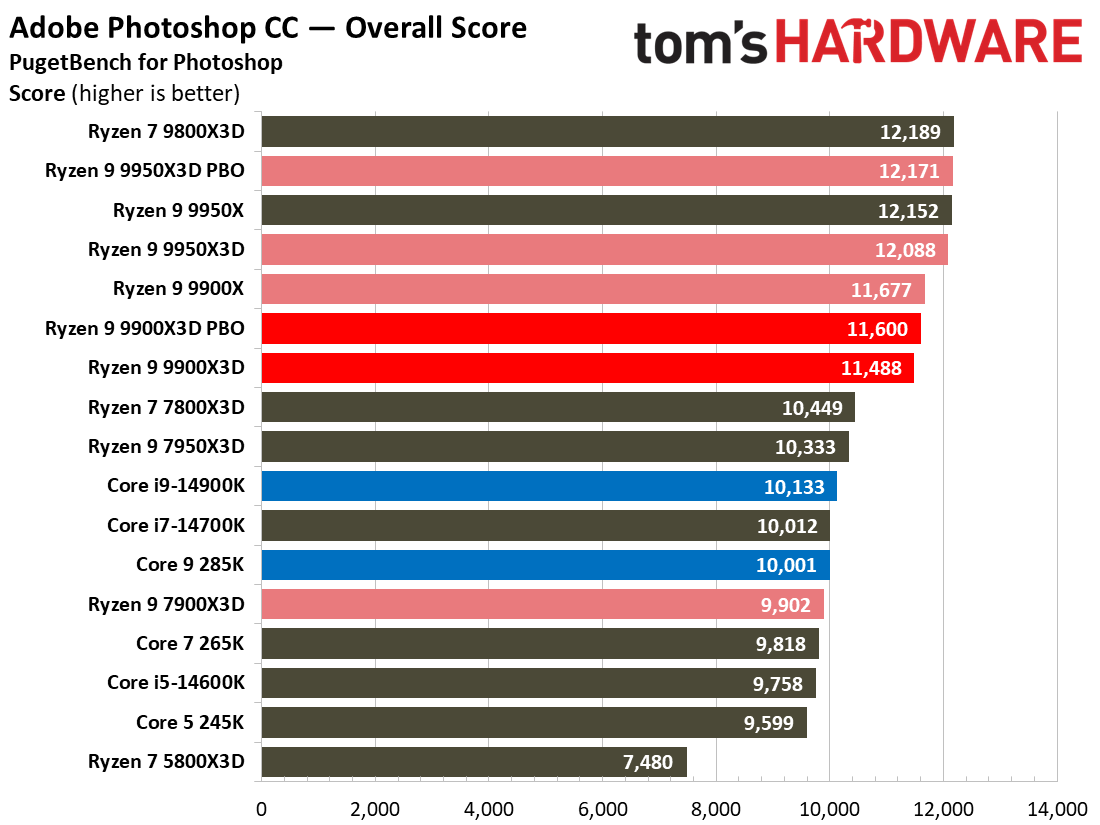

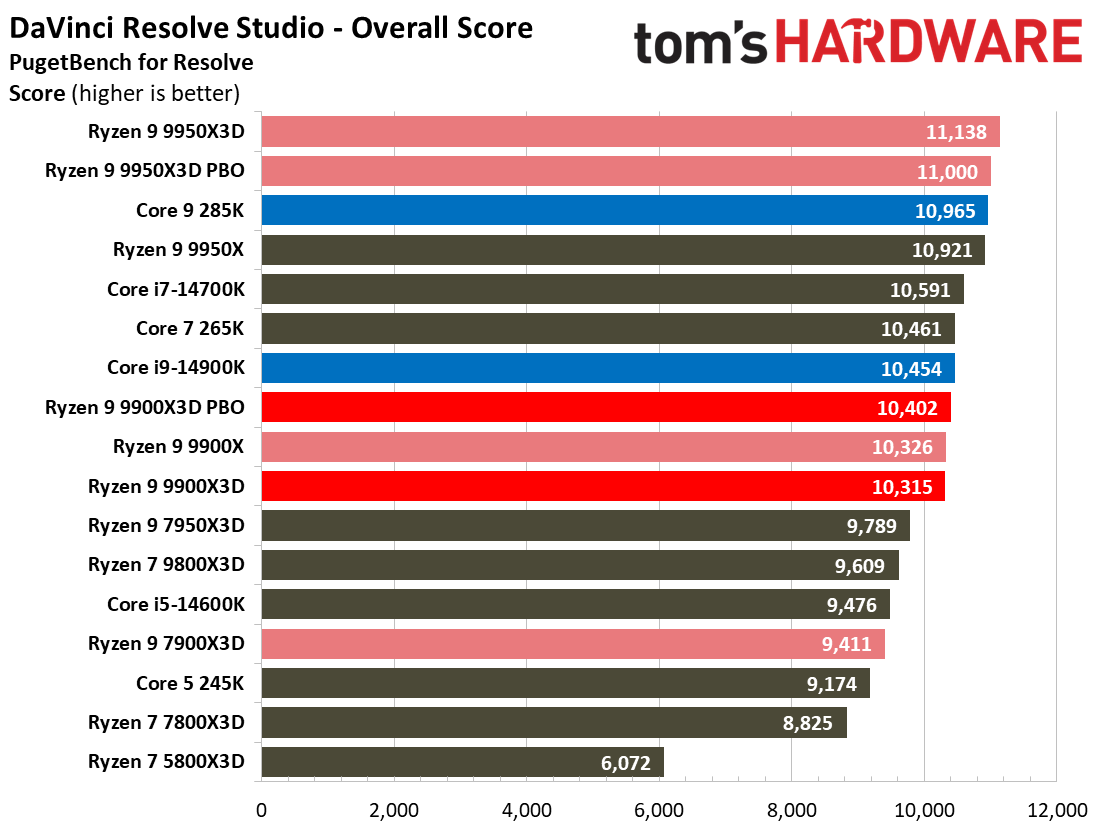


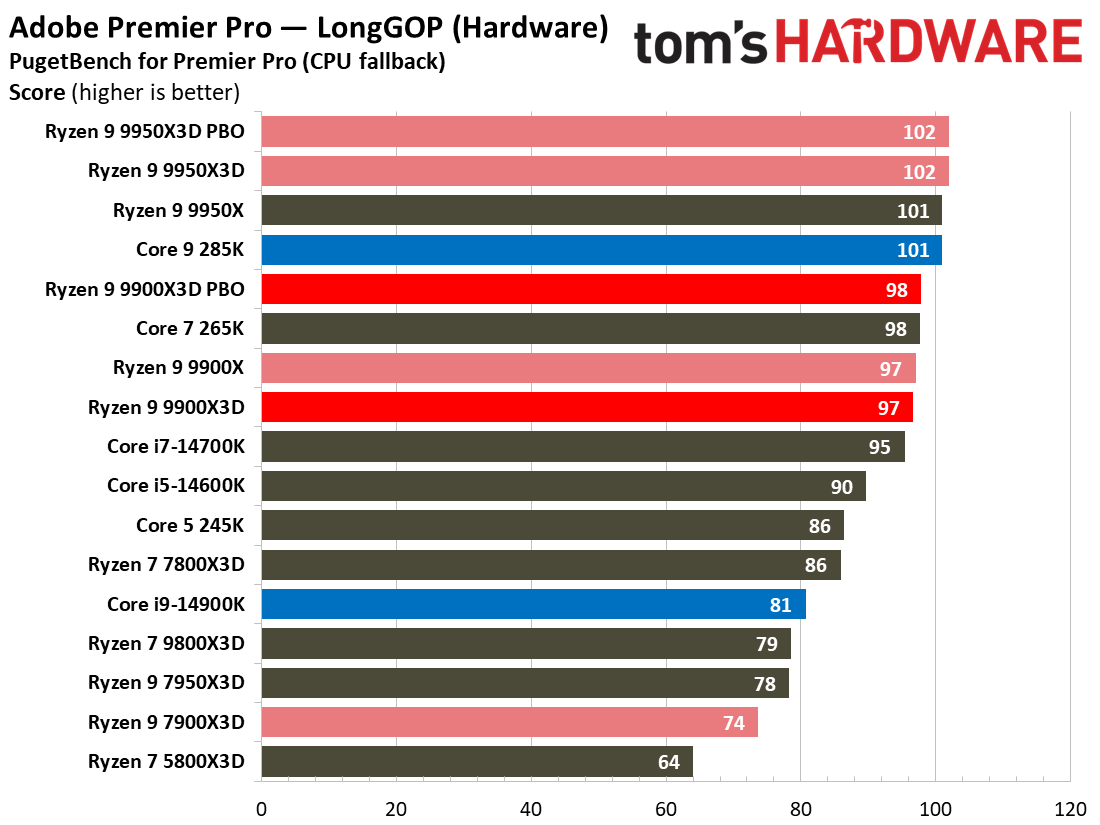
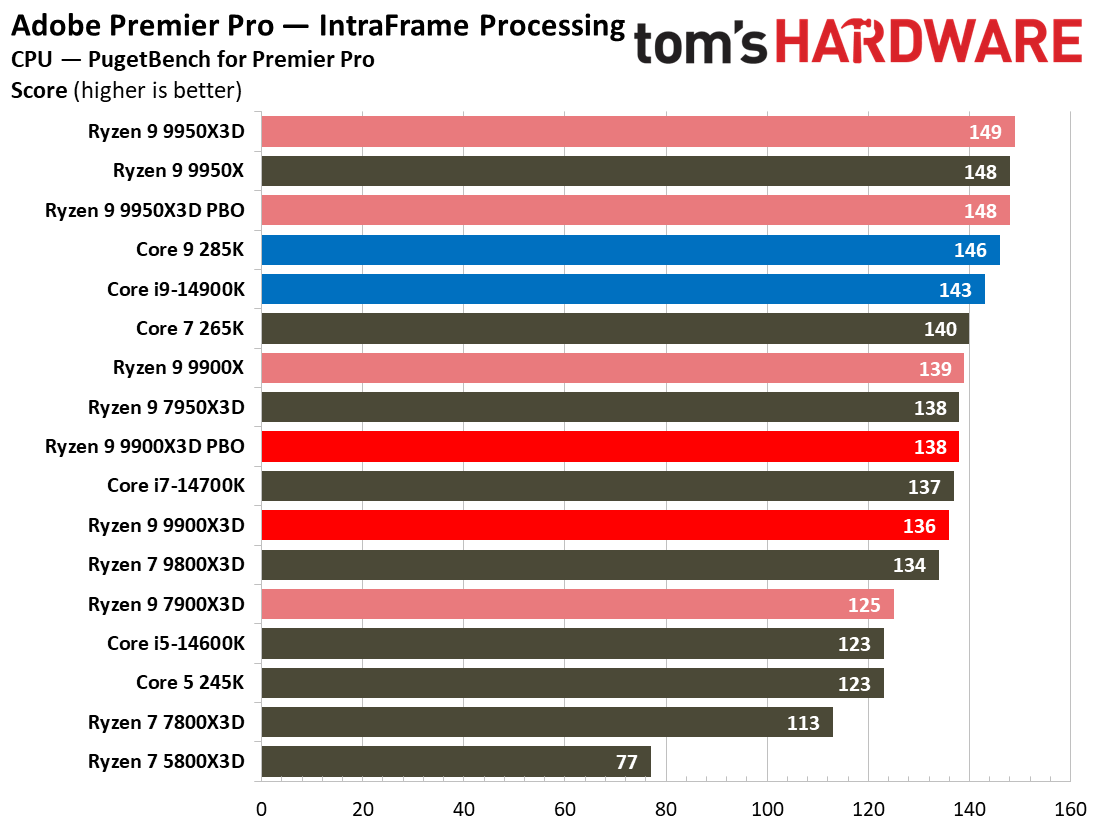
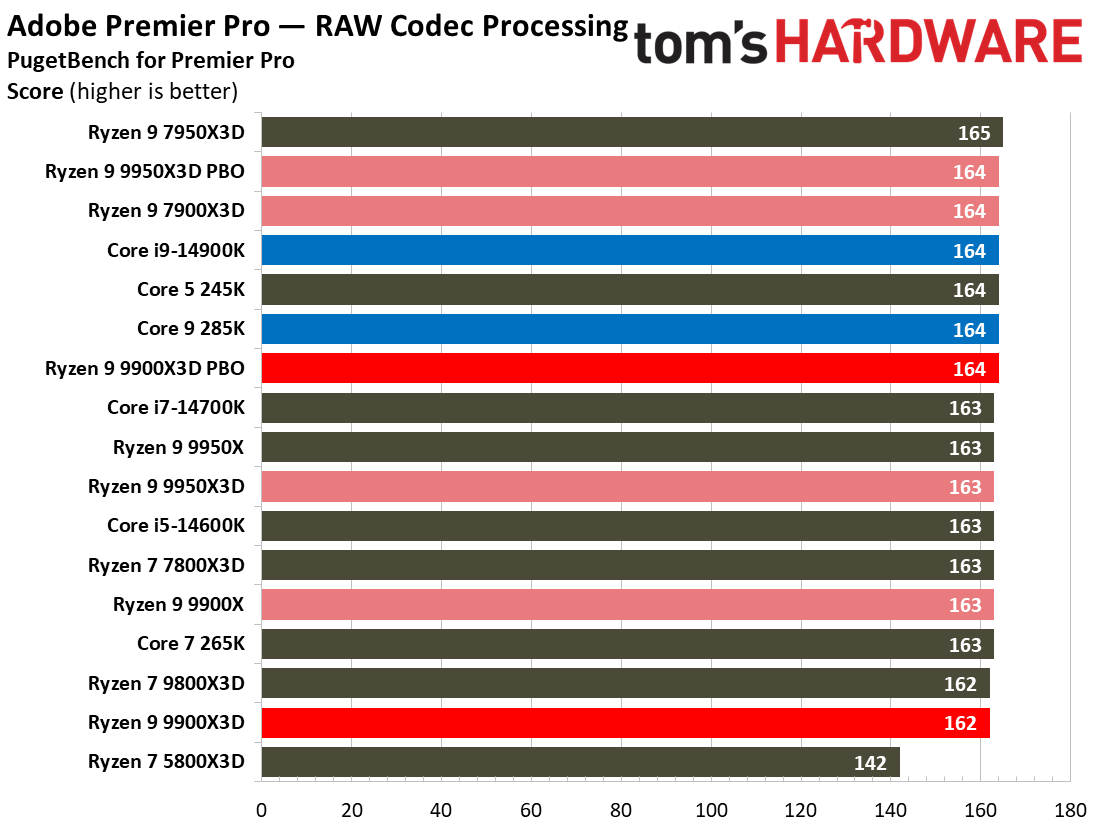
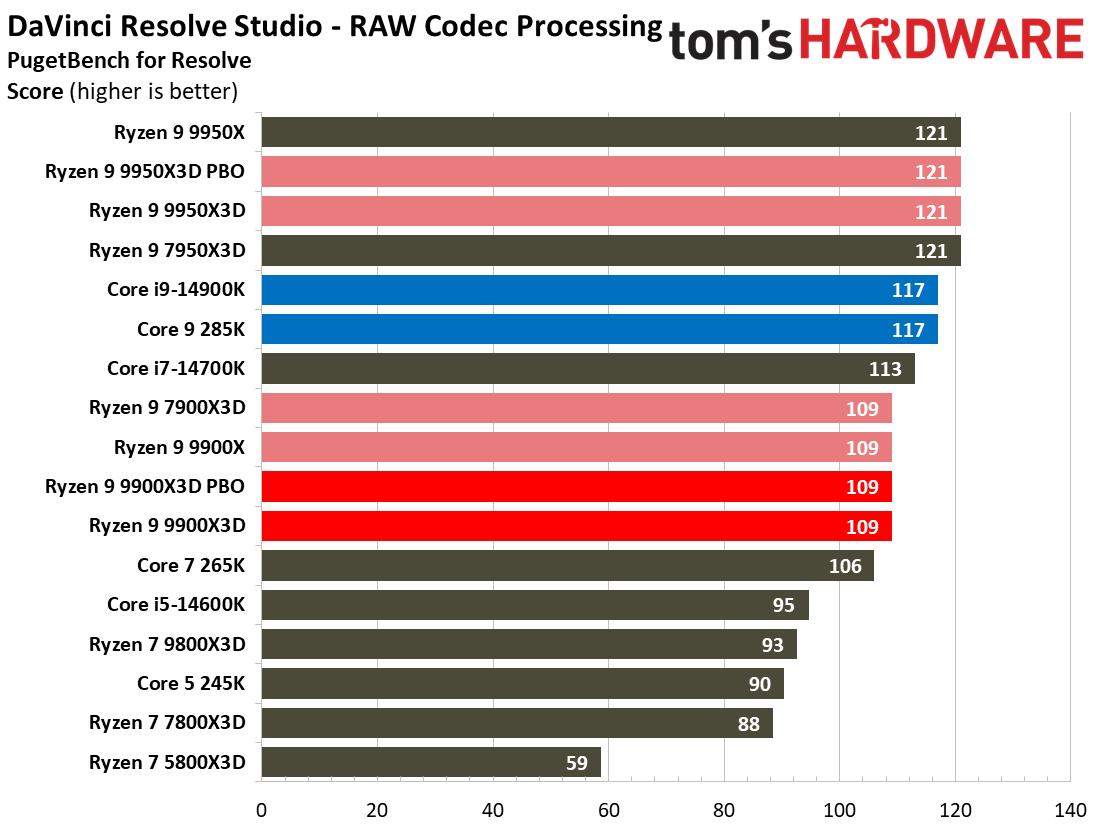
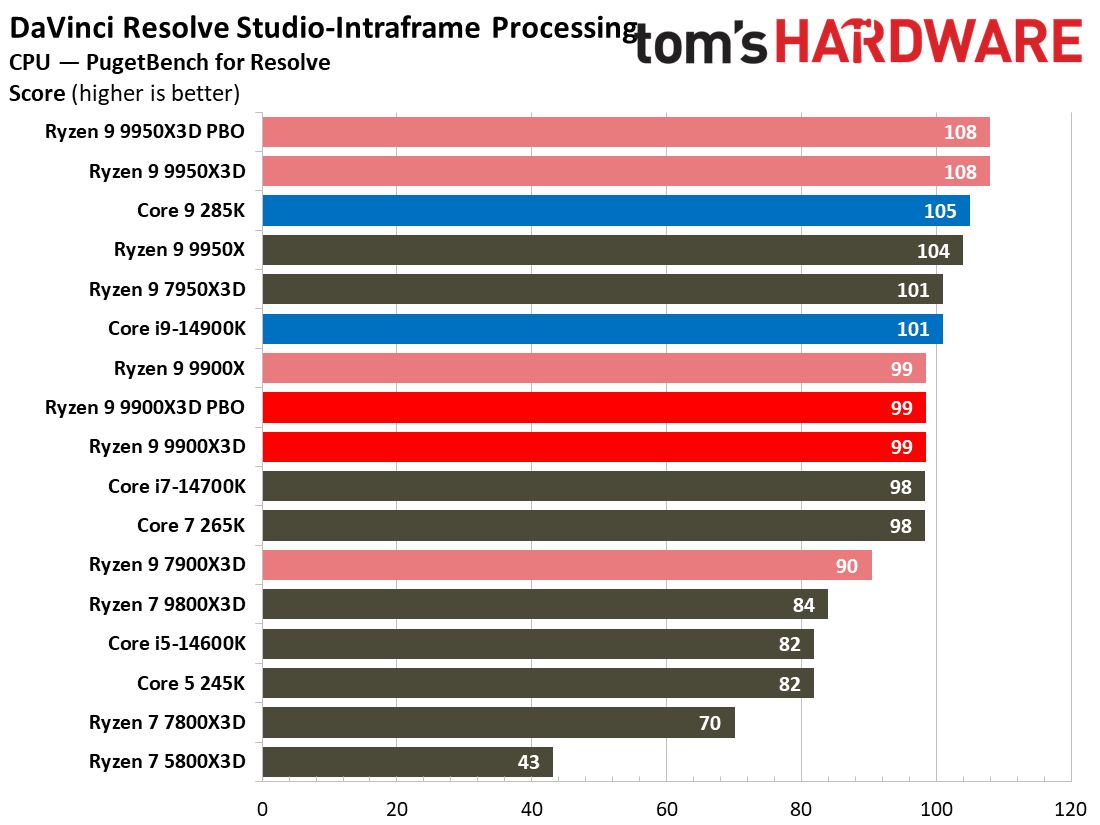
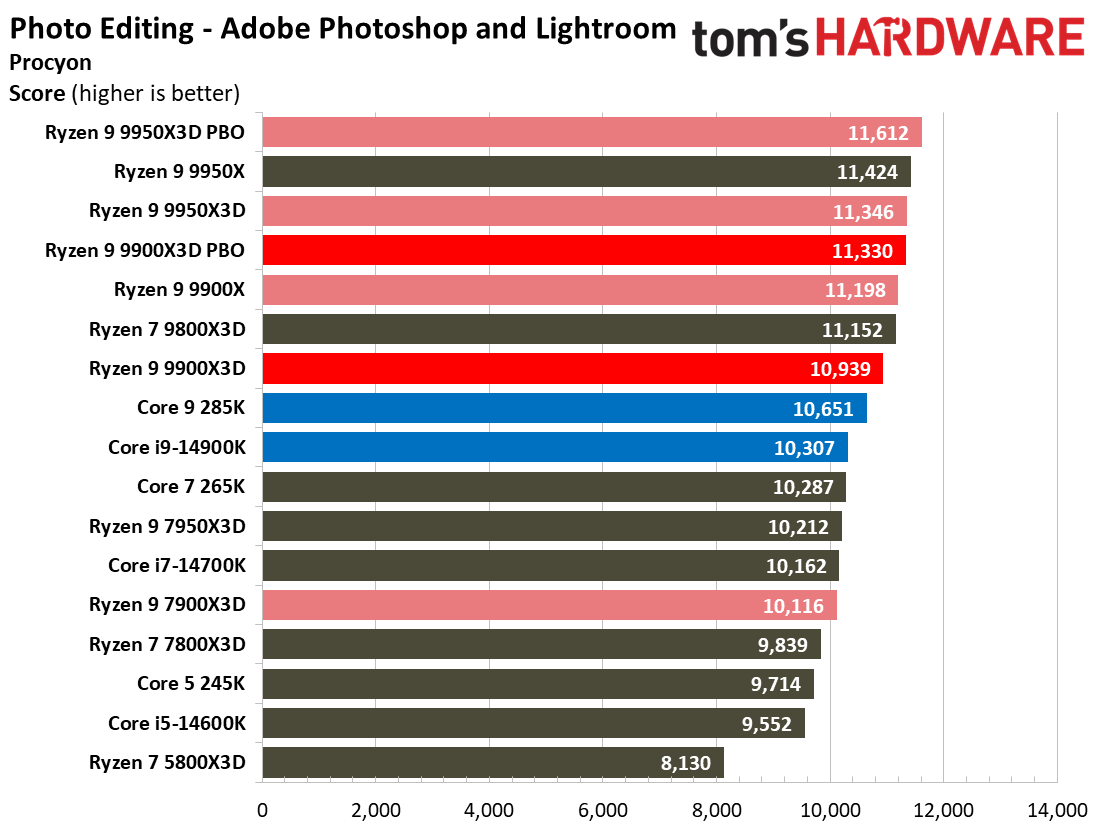
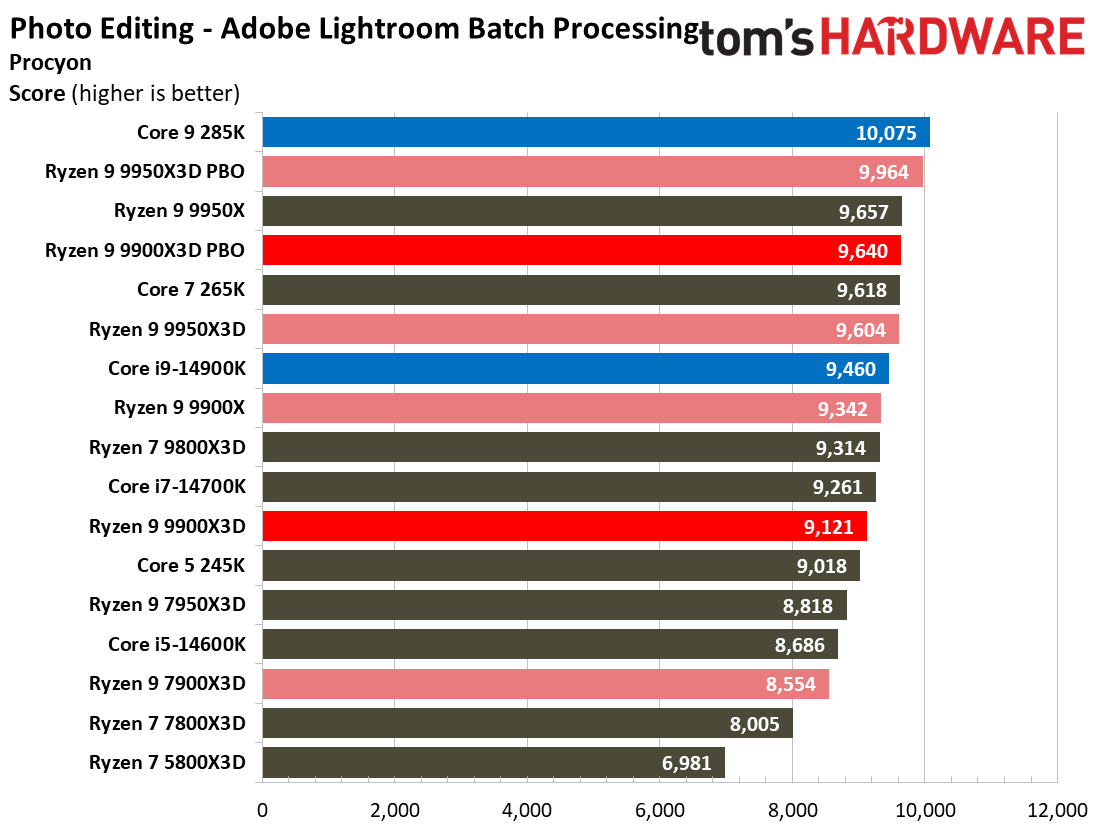
The PugetBench for Creators suite is a wonderful tool for benchmarking multiple types of Adobe applications, not to mention DaVinci Resolve. We used the benchmark for Photoshop, Premiere Pro, and DaVinci workloads.
The Ryzen 9000X3D chips lead Intel across the board in Adobe Photoshop and Lightroom, but Adobe Premier Pro finds a much more contested picture, with the 285K taking the lead over the 9900X3D while the 14900K challenges. The 14900K claws out a slim lead over the 9900X3D in DaVinci Resolve Studio, while the 285K leads once again.
Web Browser, Office Benchmarks
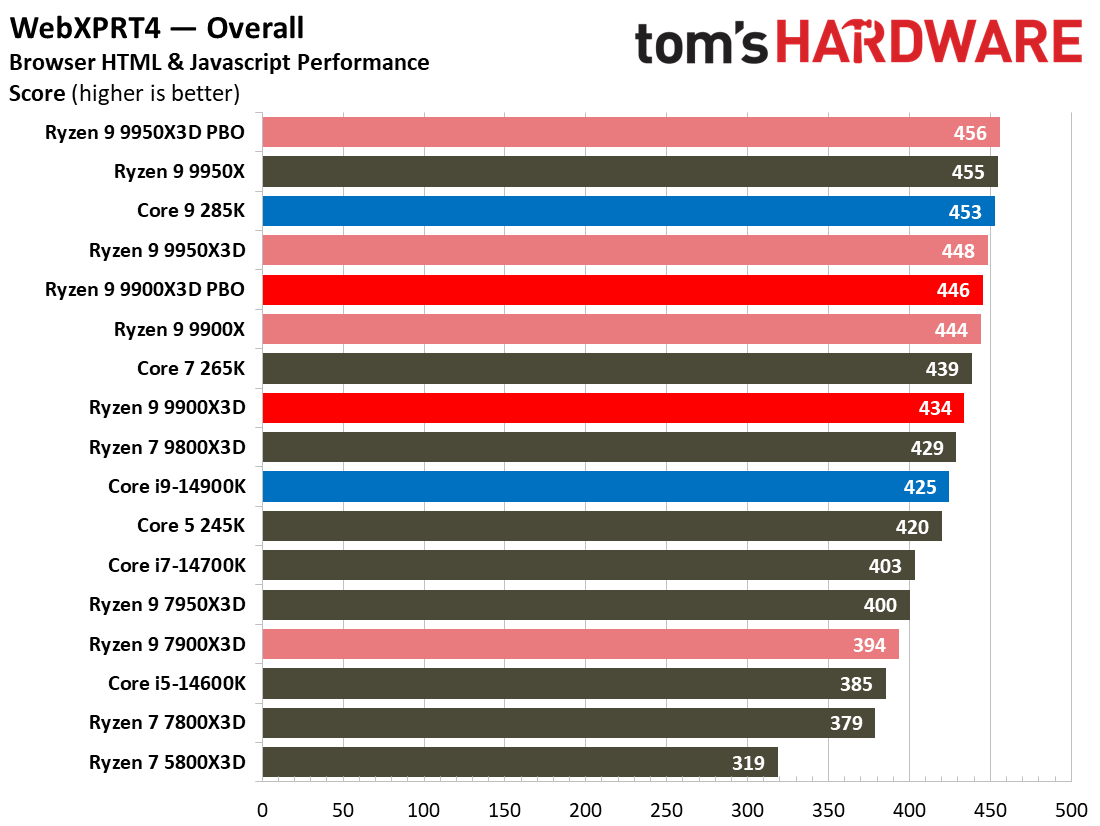
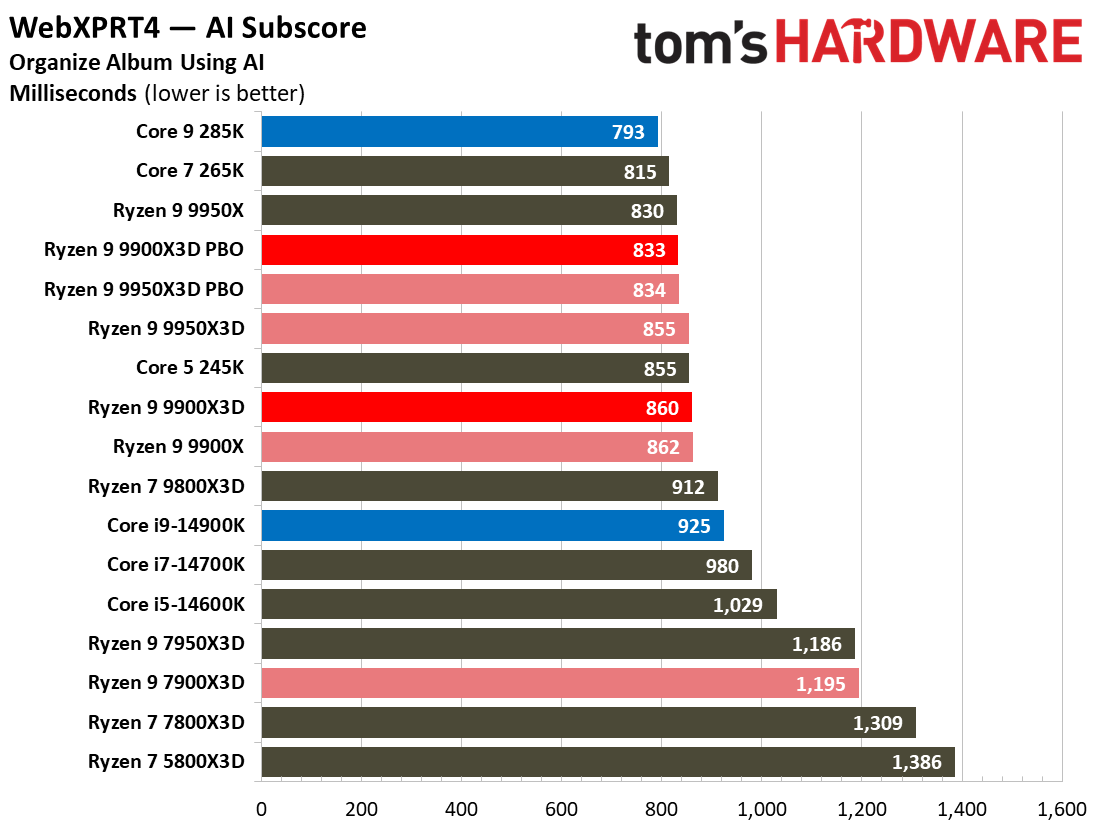
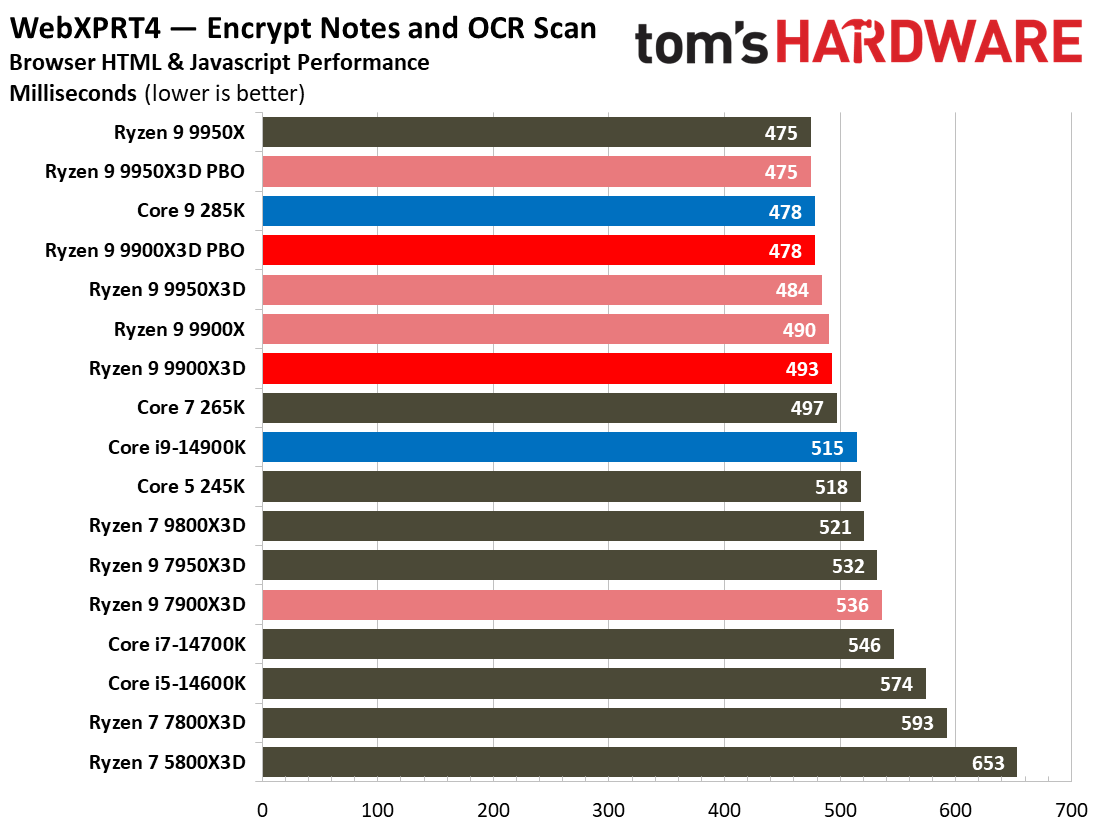
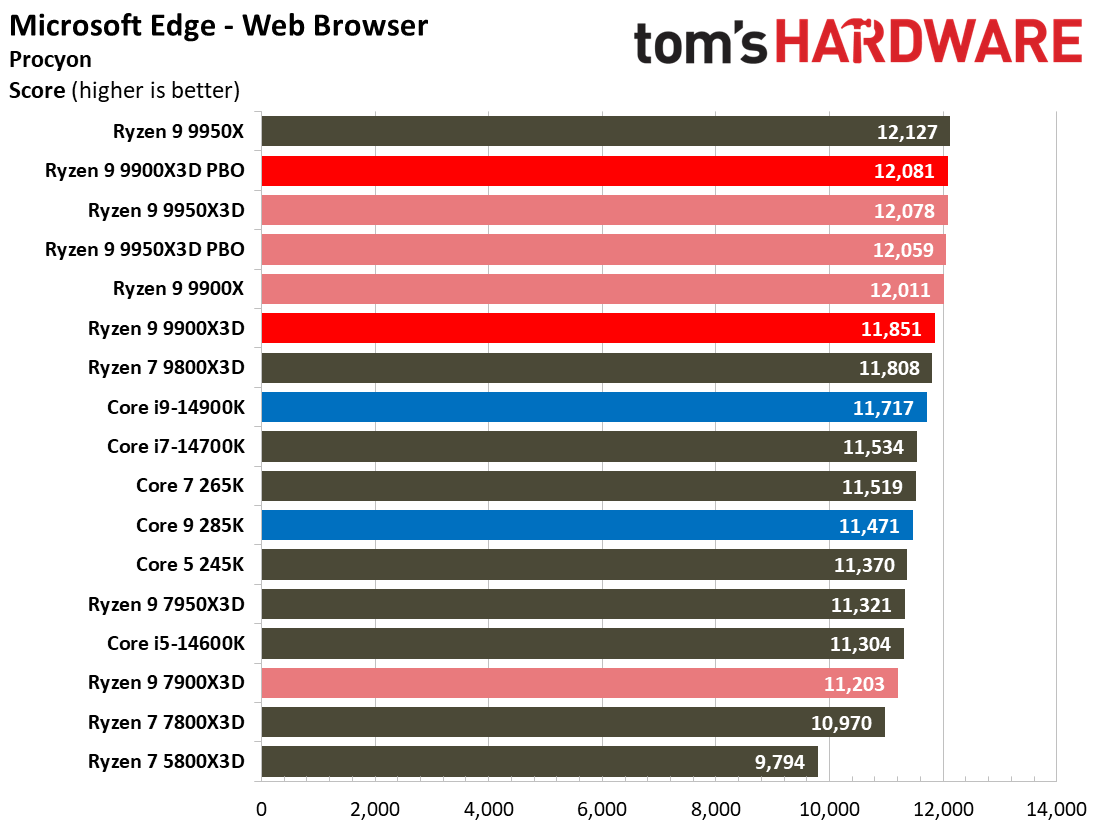
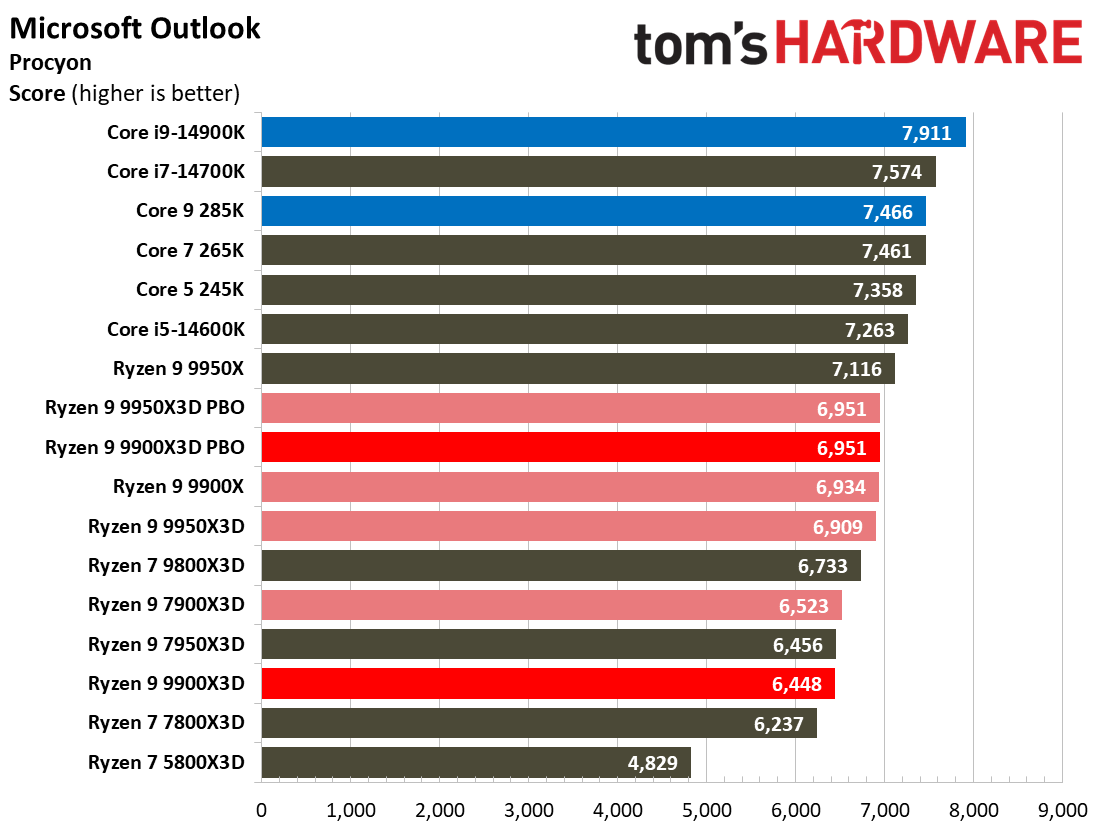
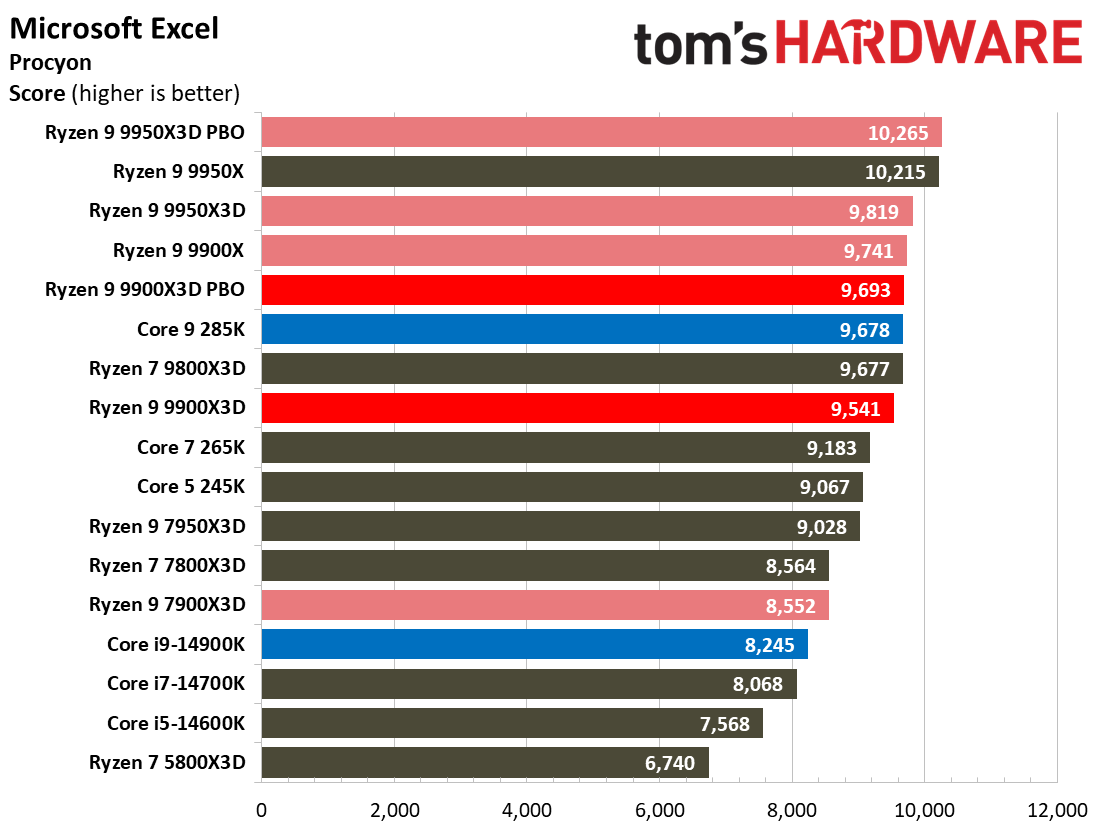
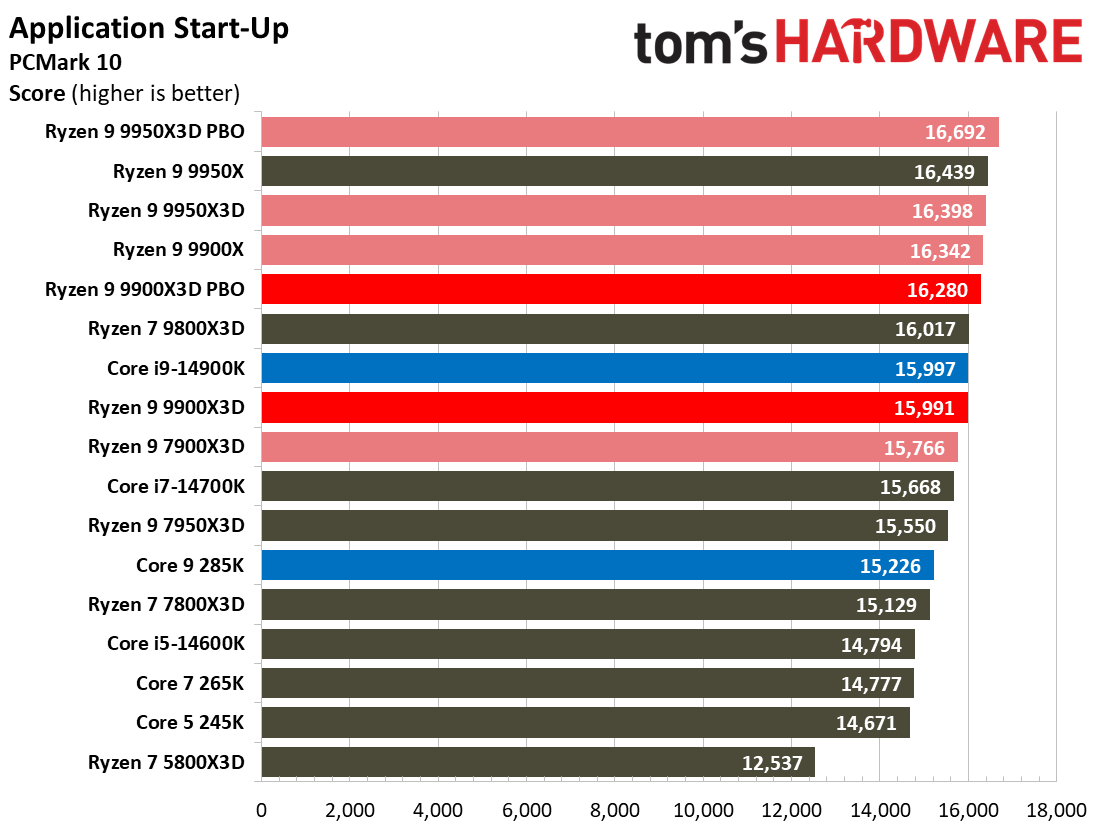
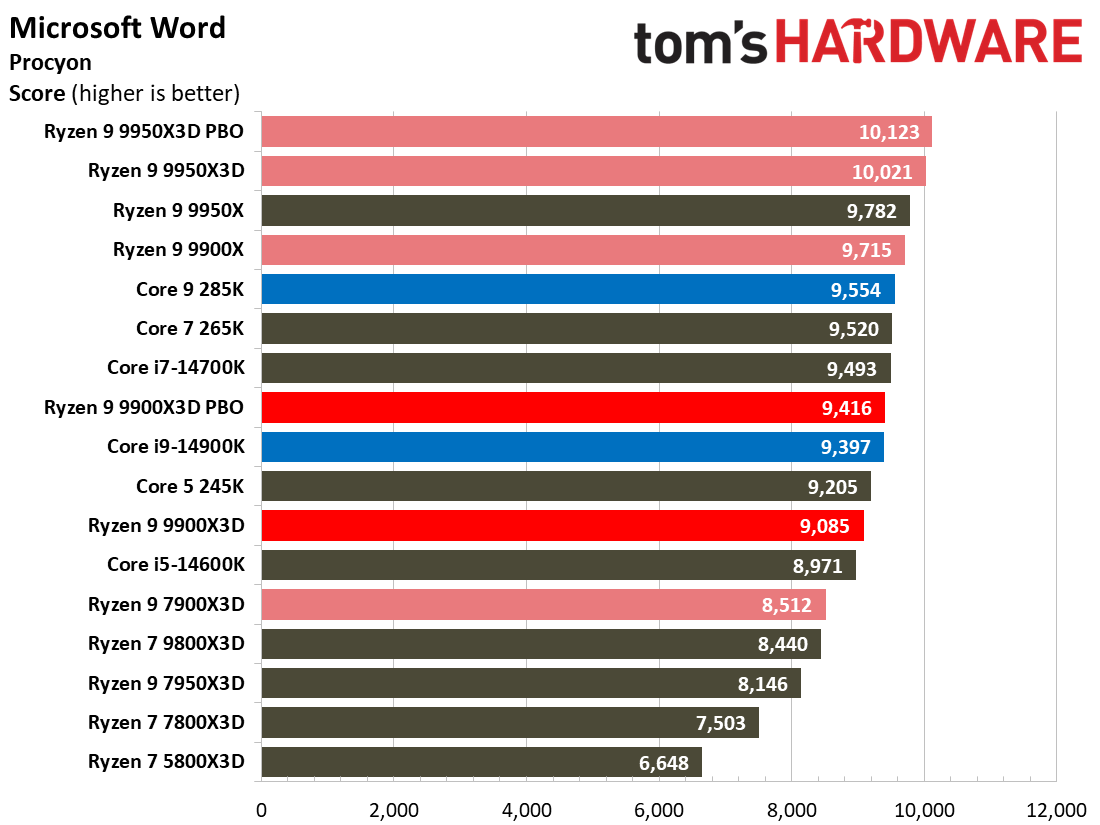
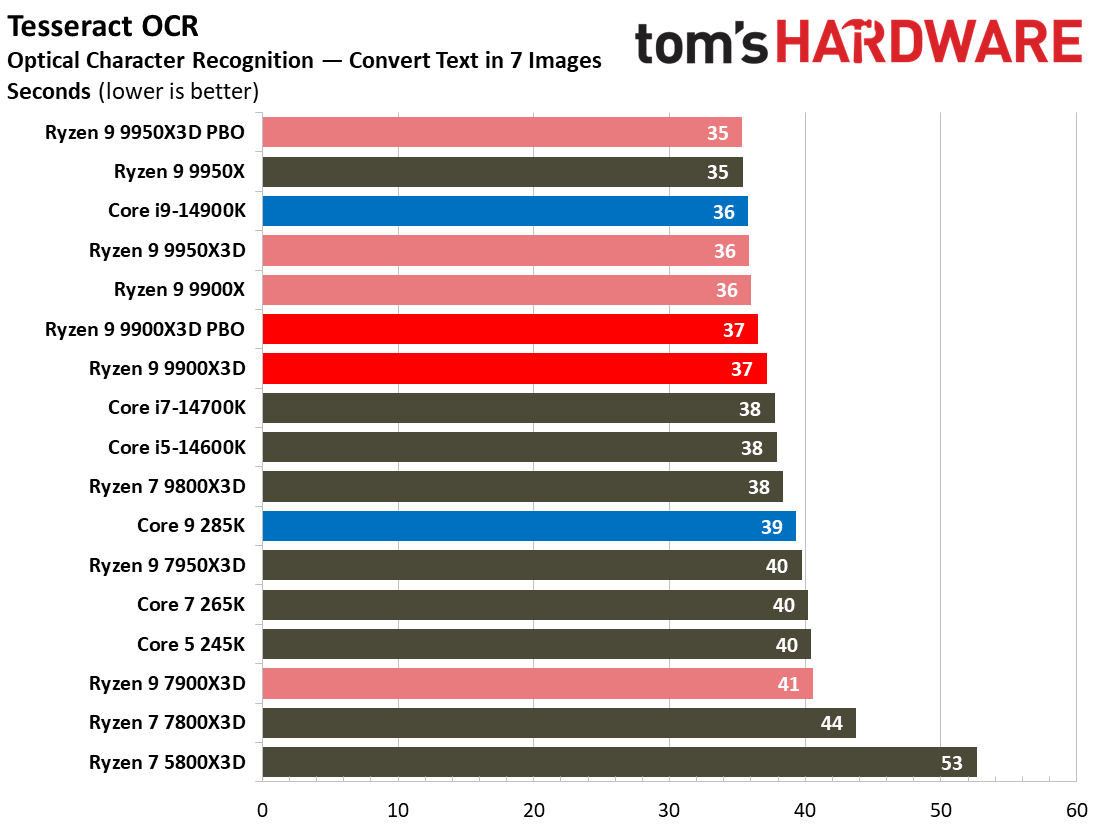
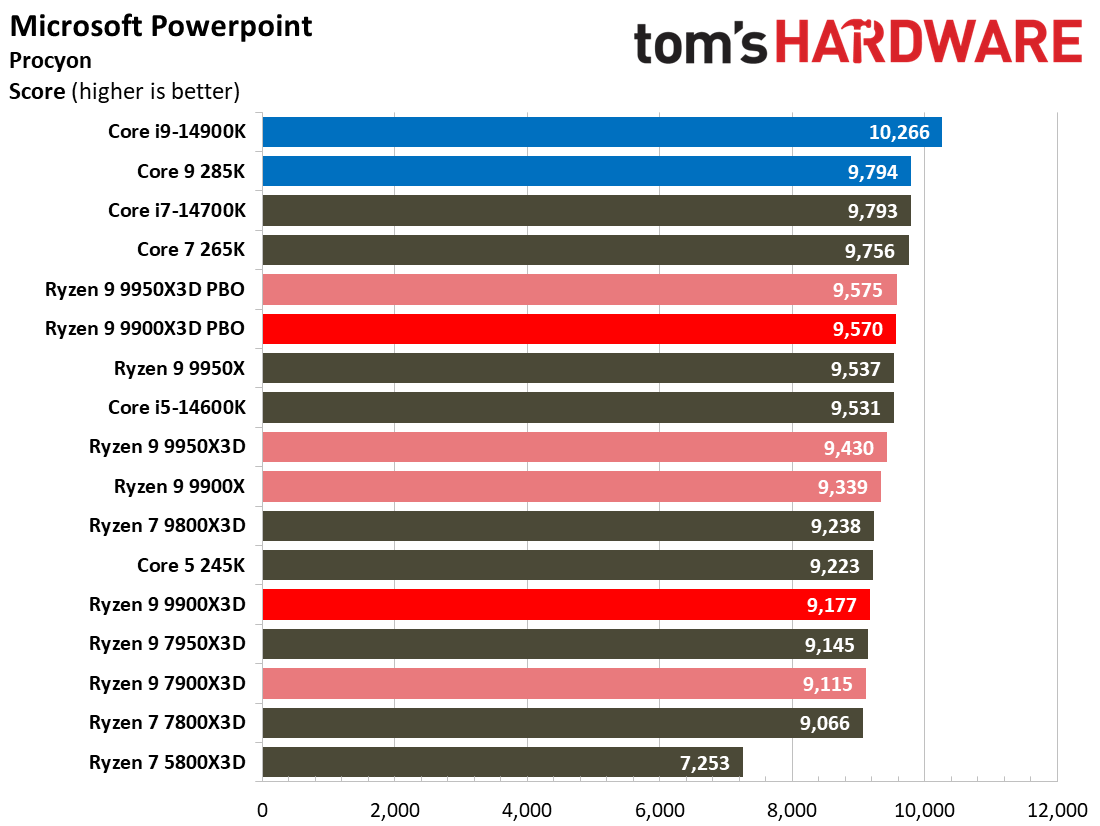
The Core Ultra 9 285K has a 4% lead over the 9900X3D in the WebXPRT4 overall score, while the Core i9-14900K trails slightly. In contrast, the 9000X3D leads convincingly in the Edge browser benchmark.
Compilation, AVX, Scientific Workloads, Chess Engines, Others
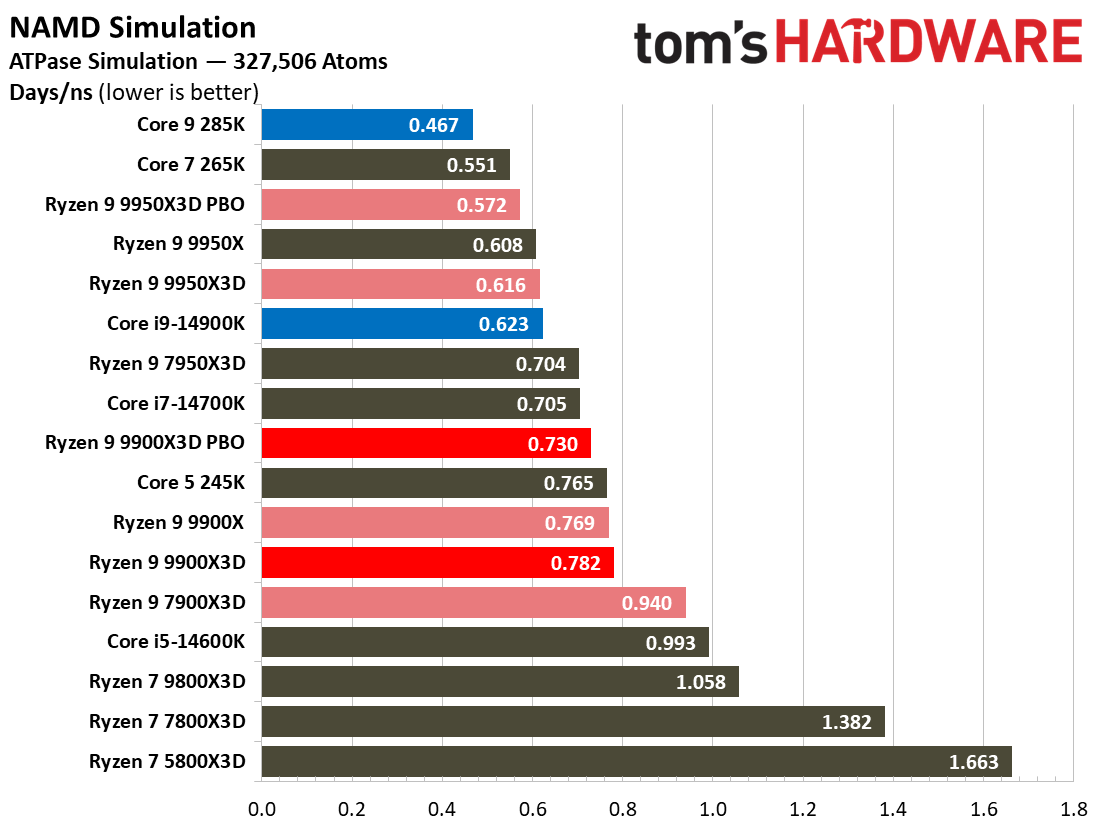
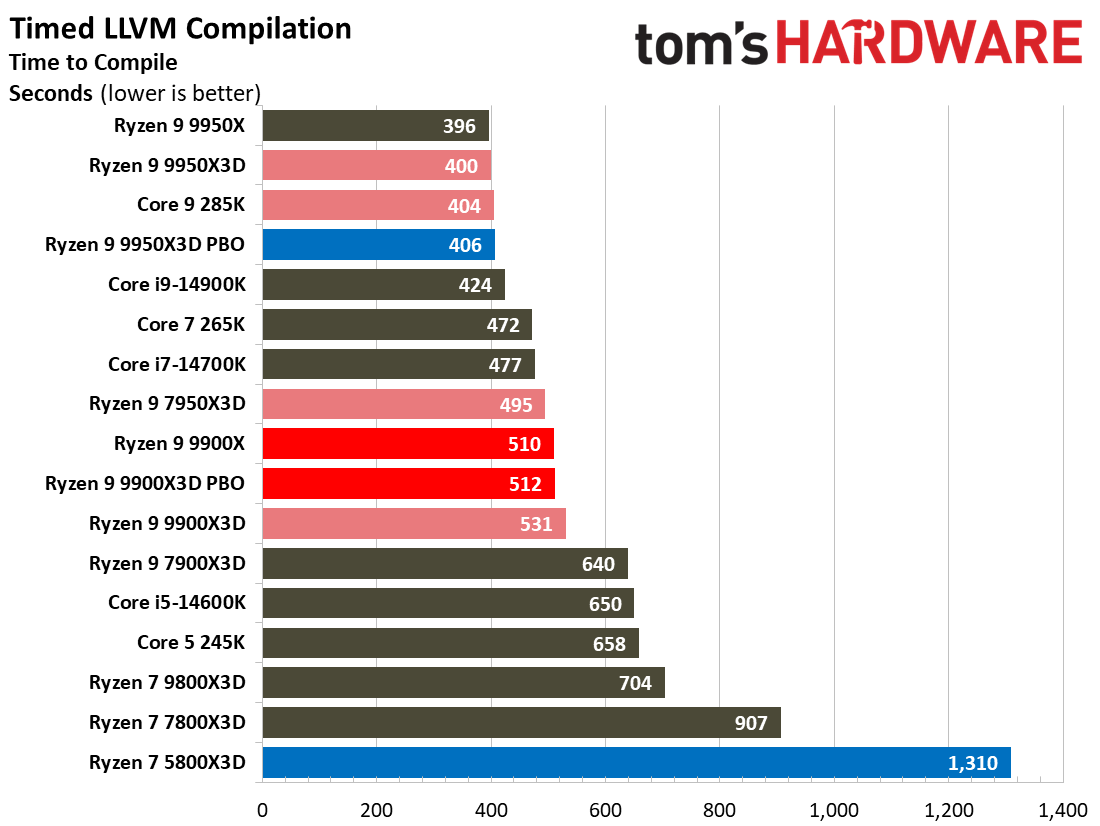
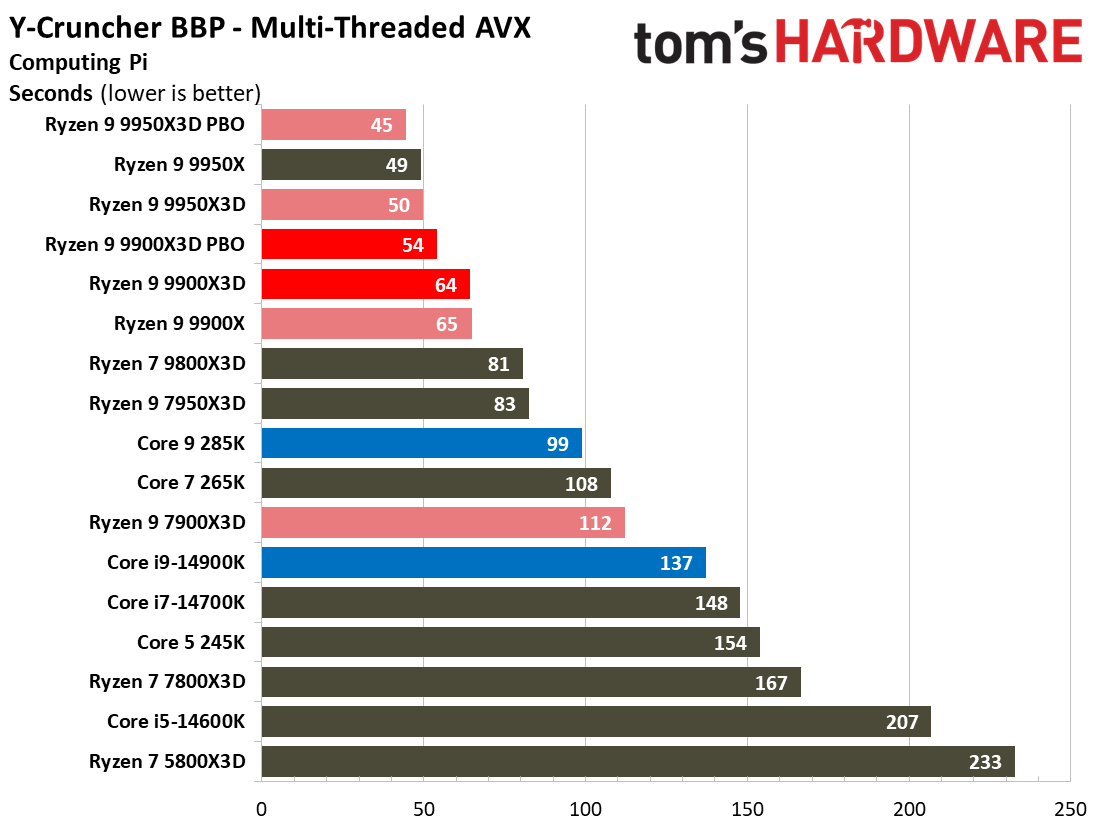
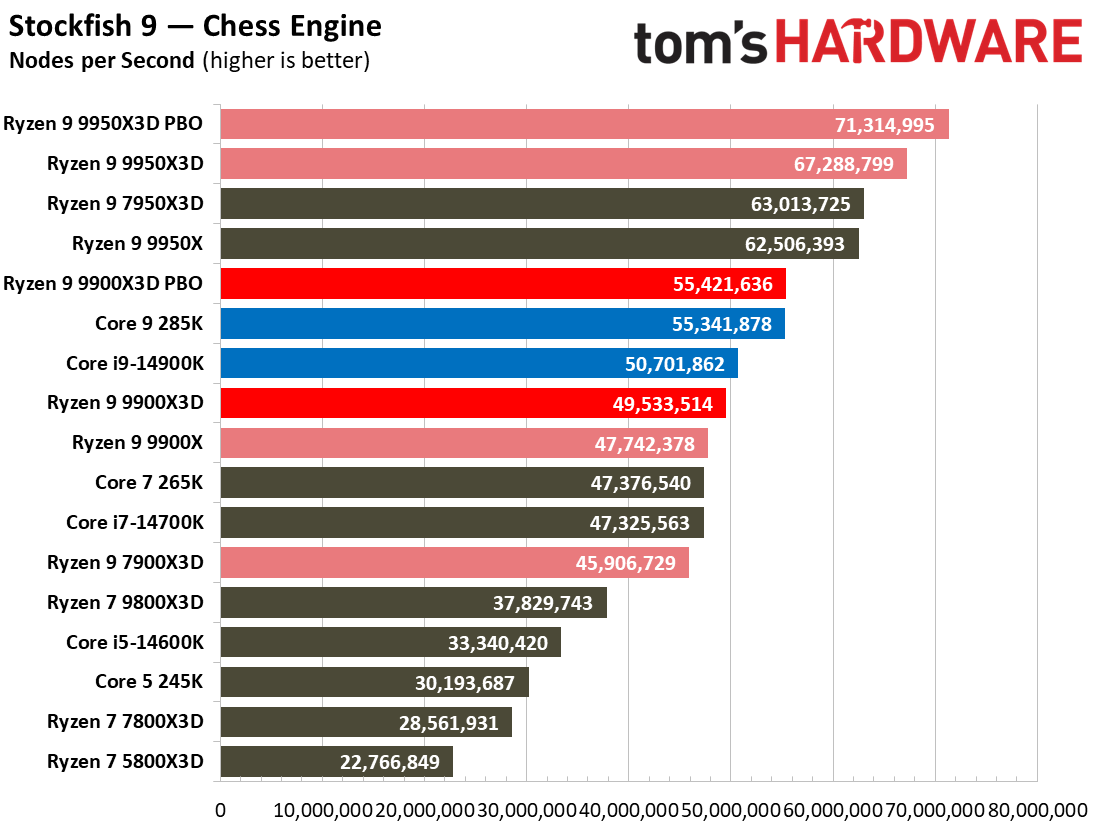
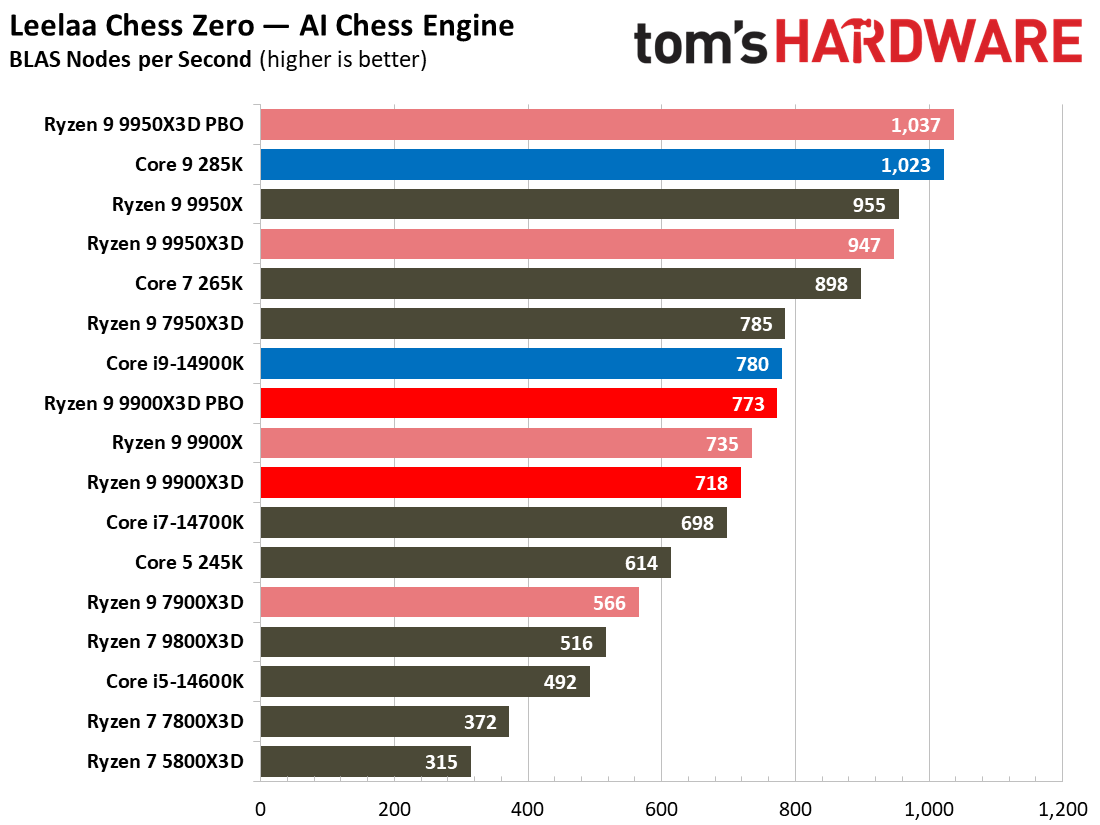
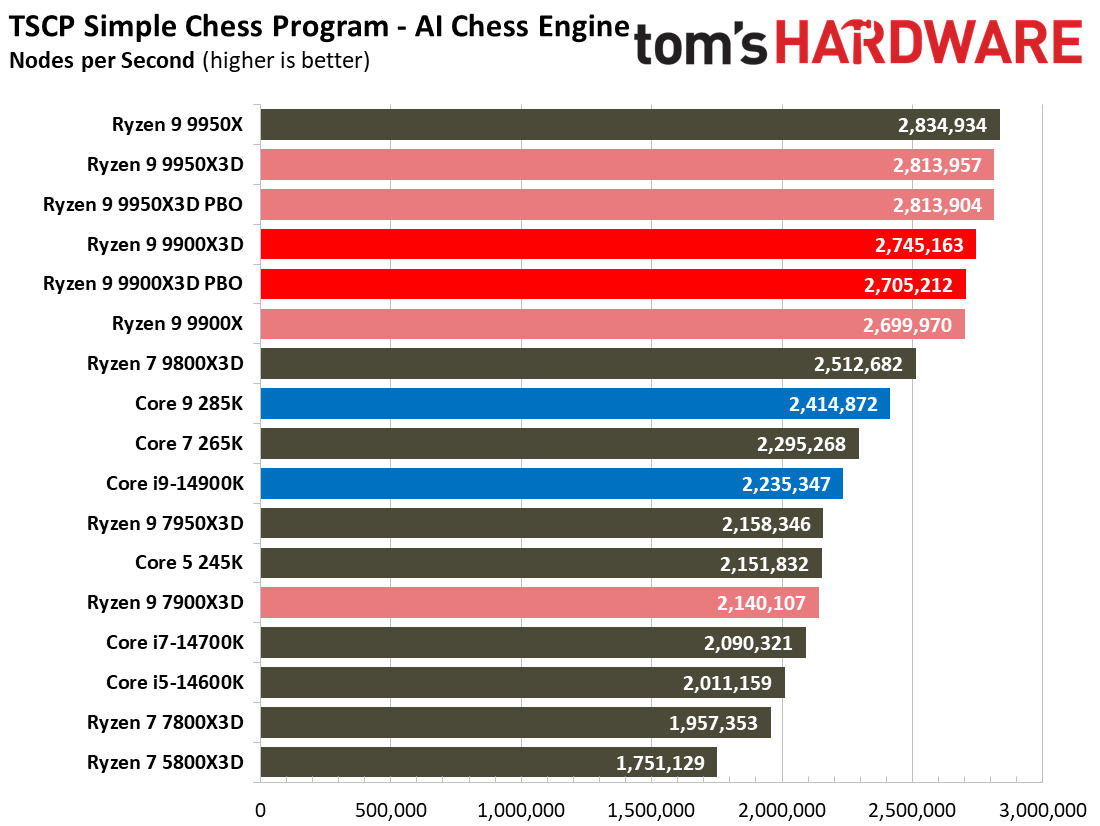
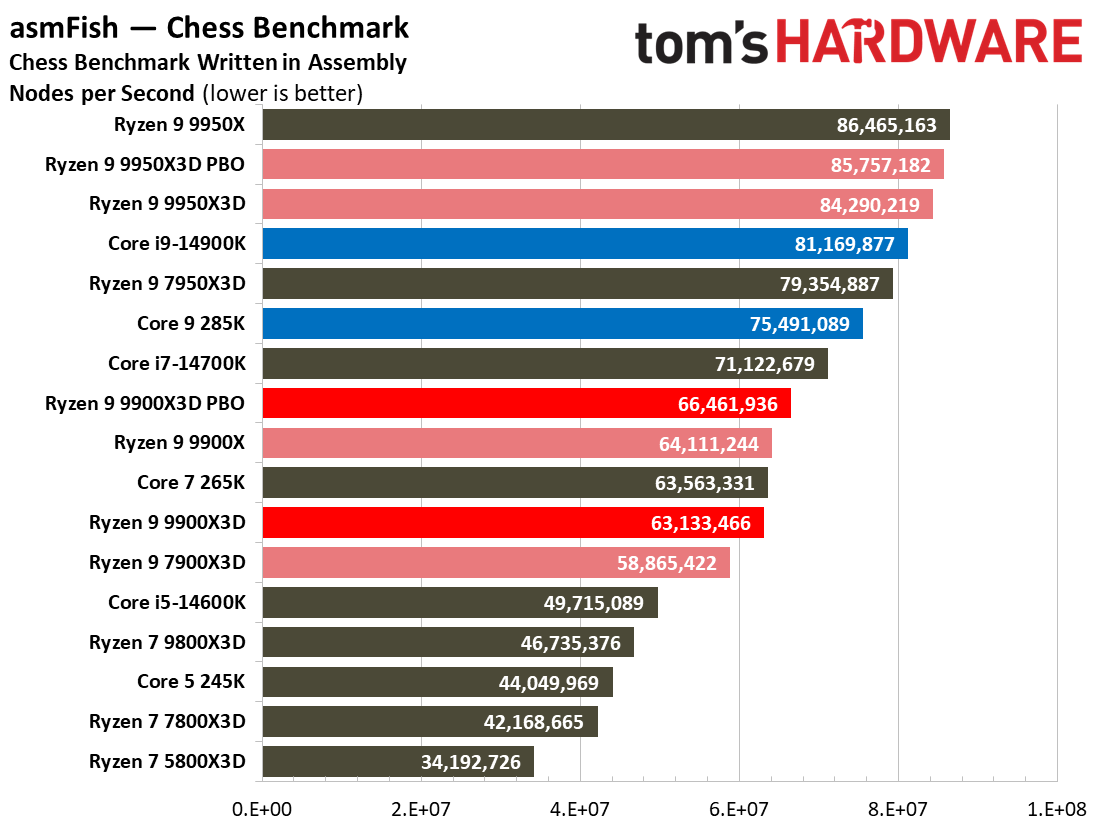

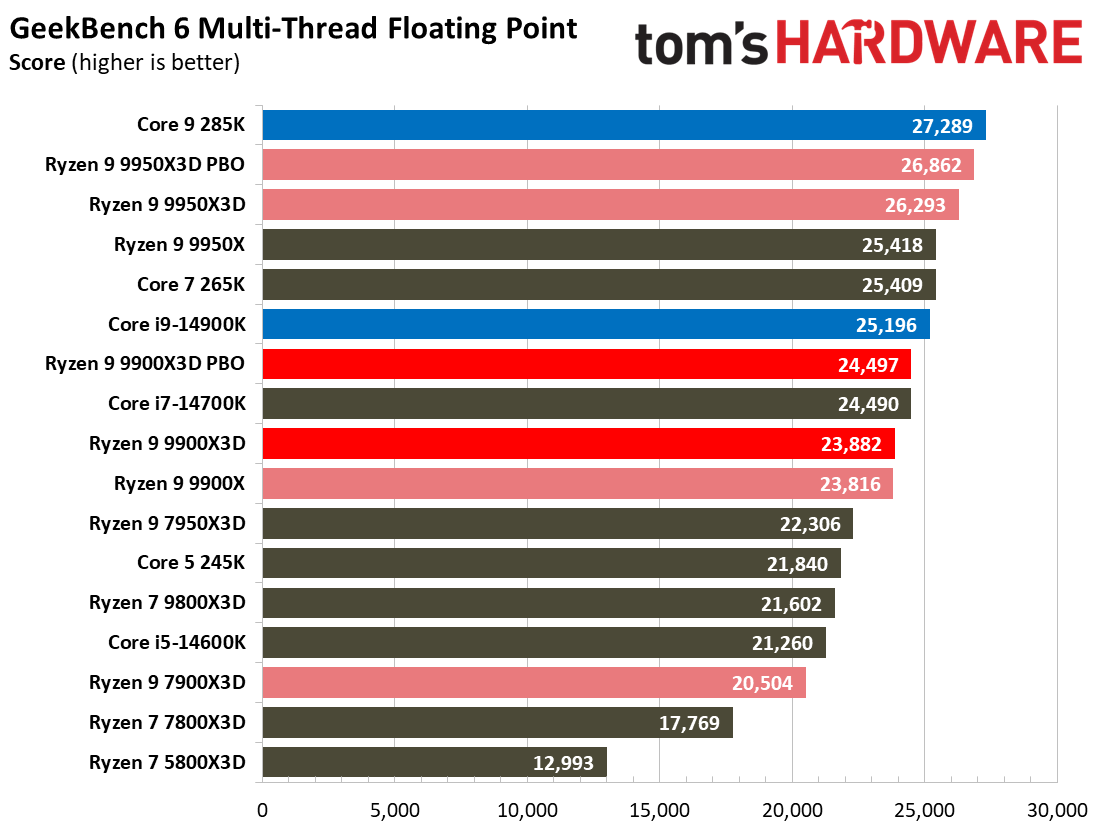
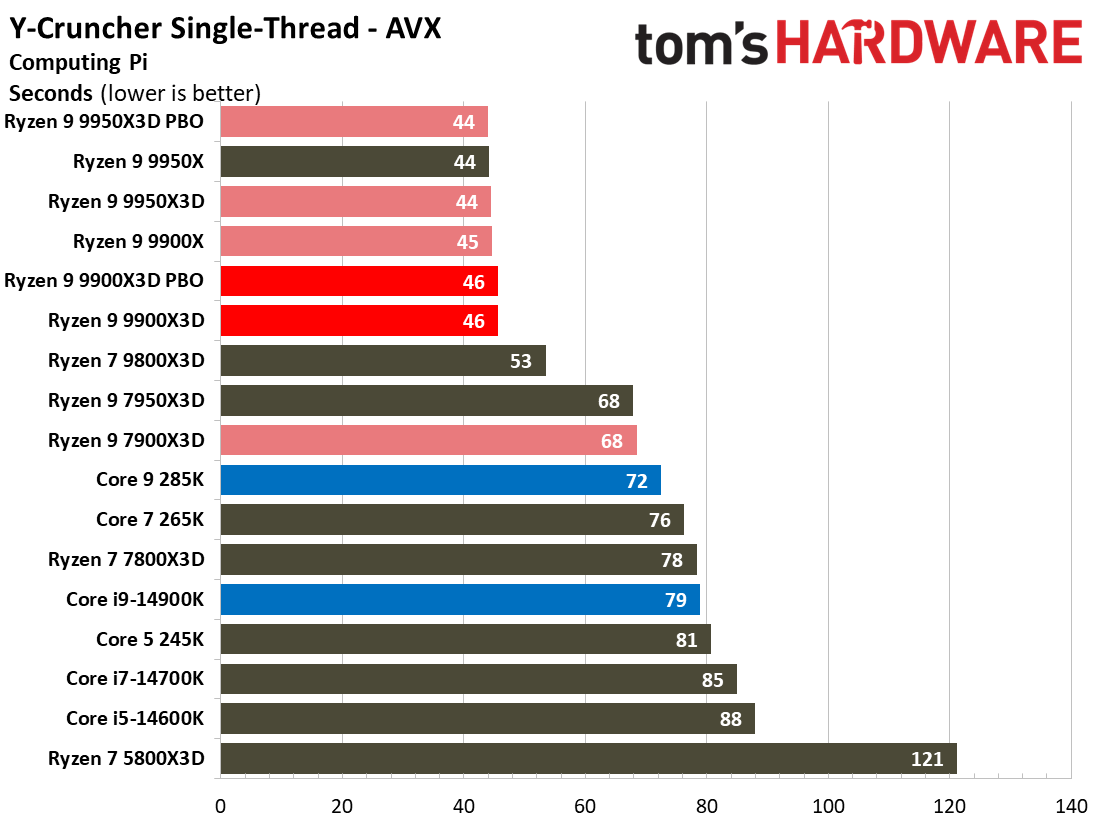
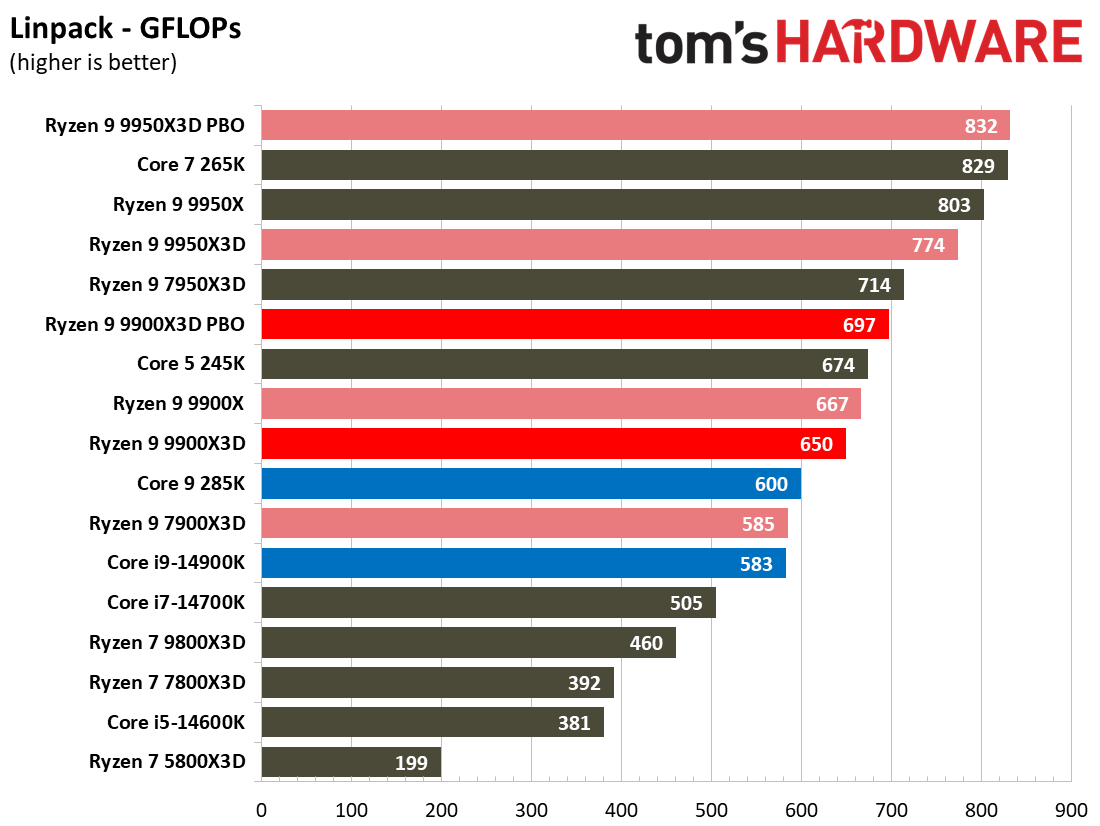
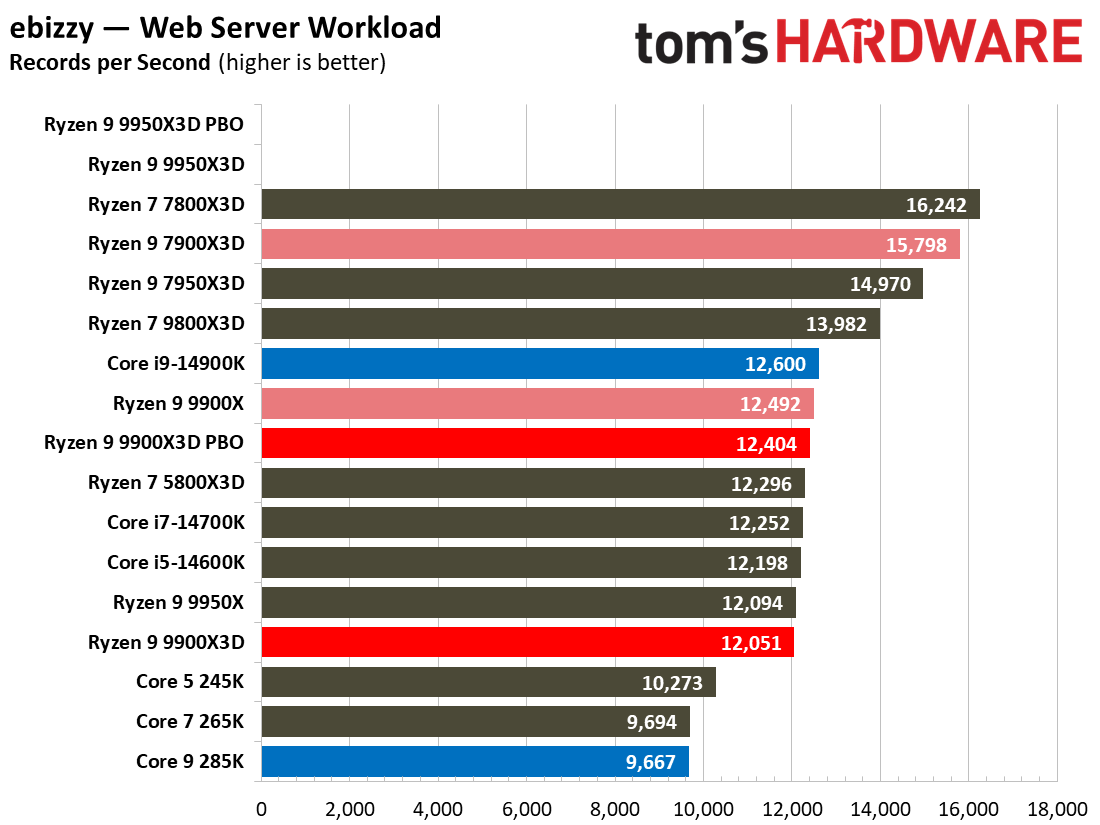
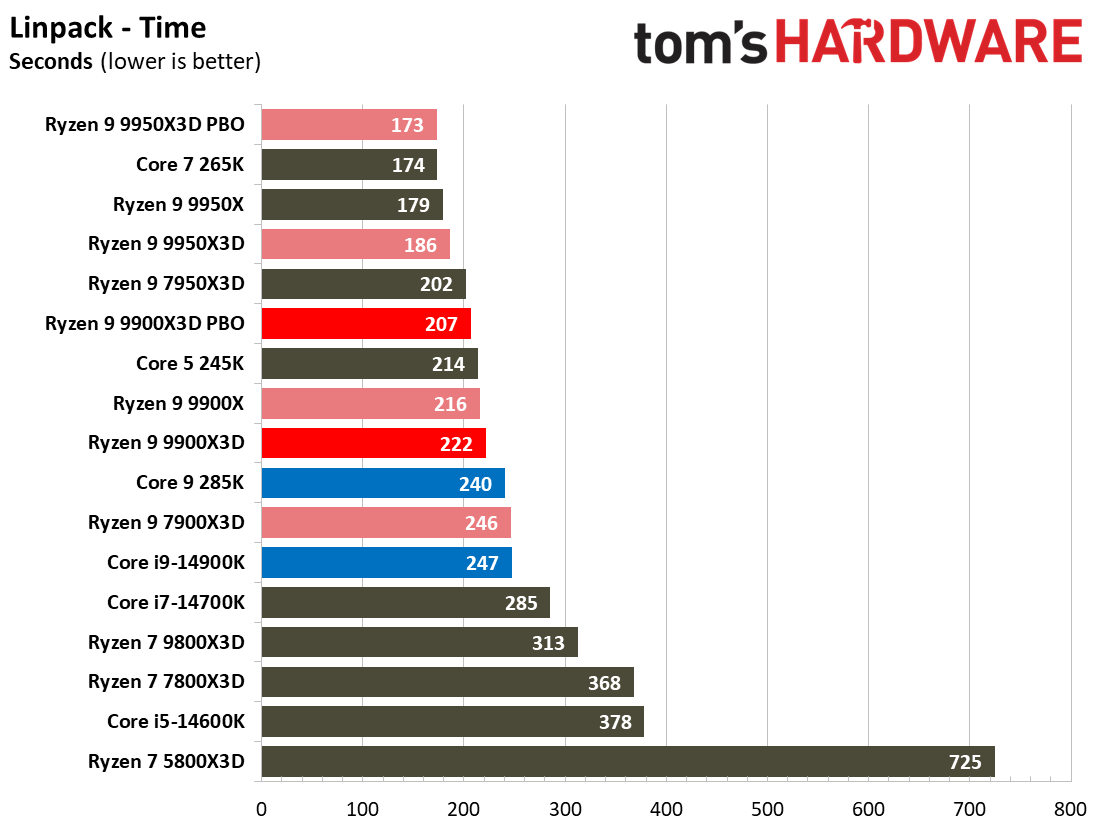
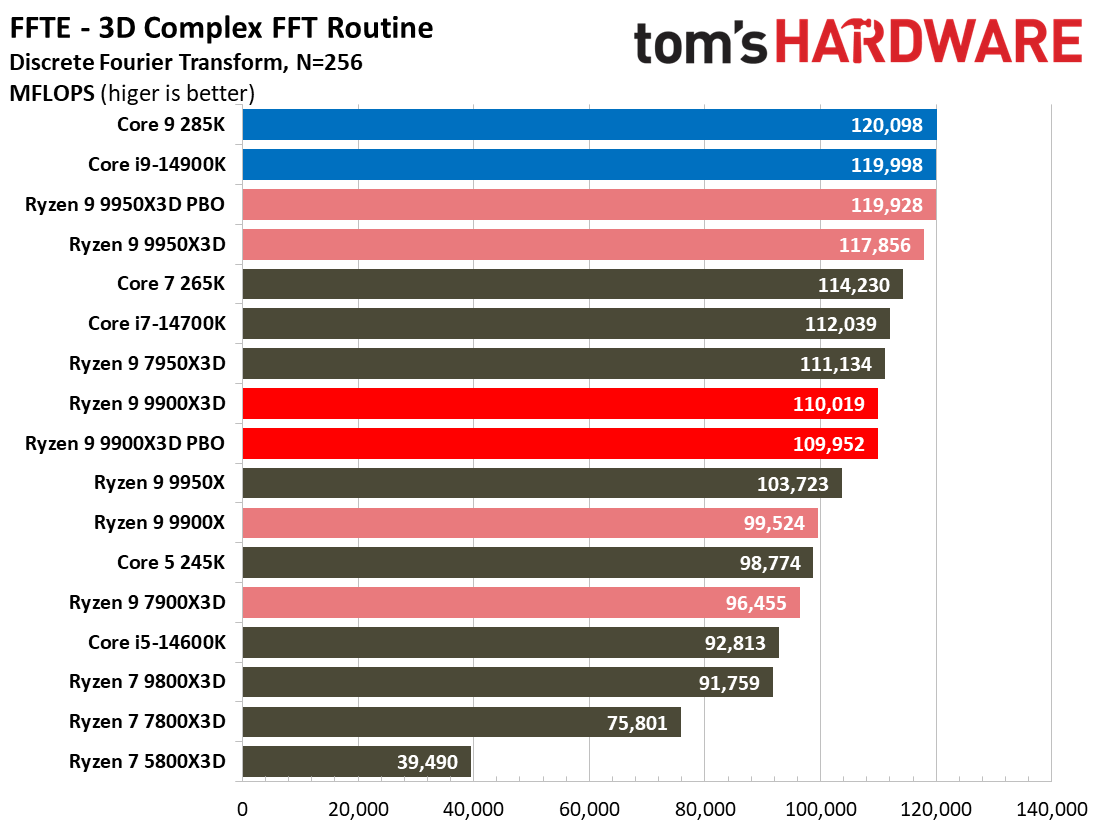
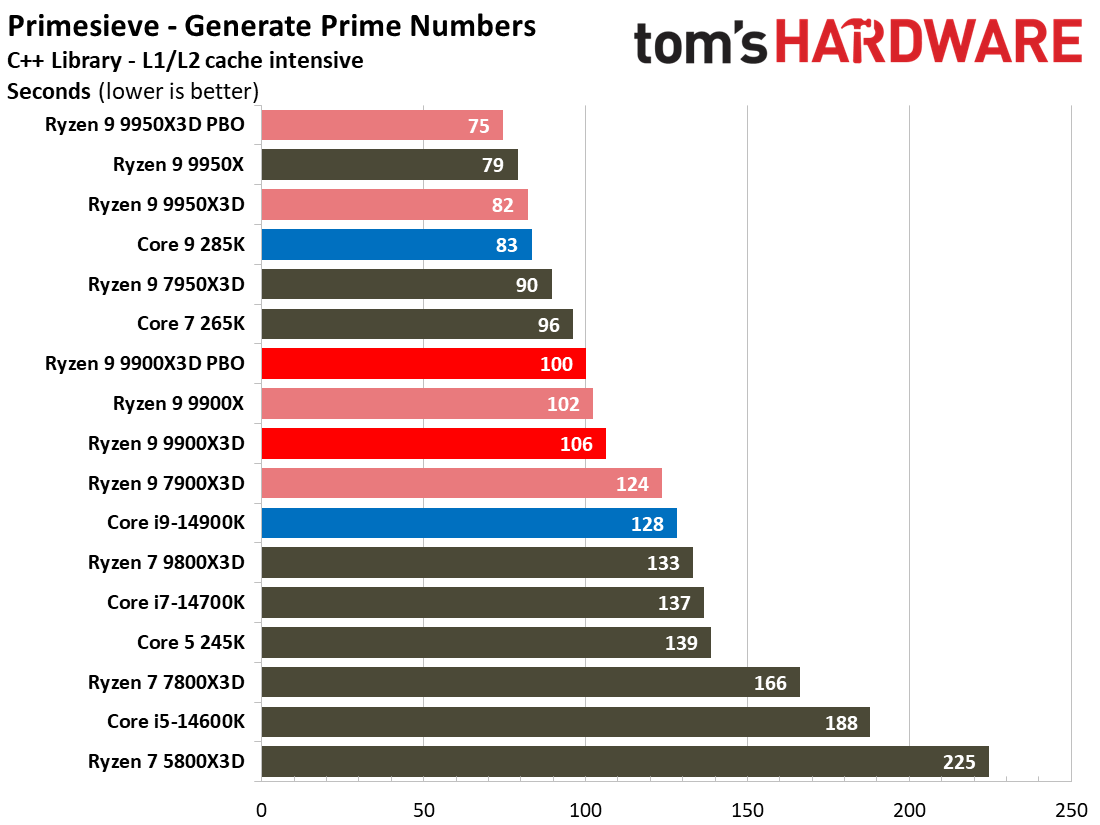
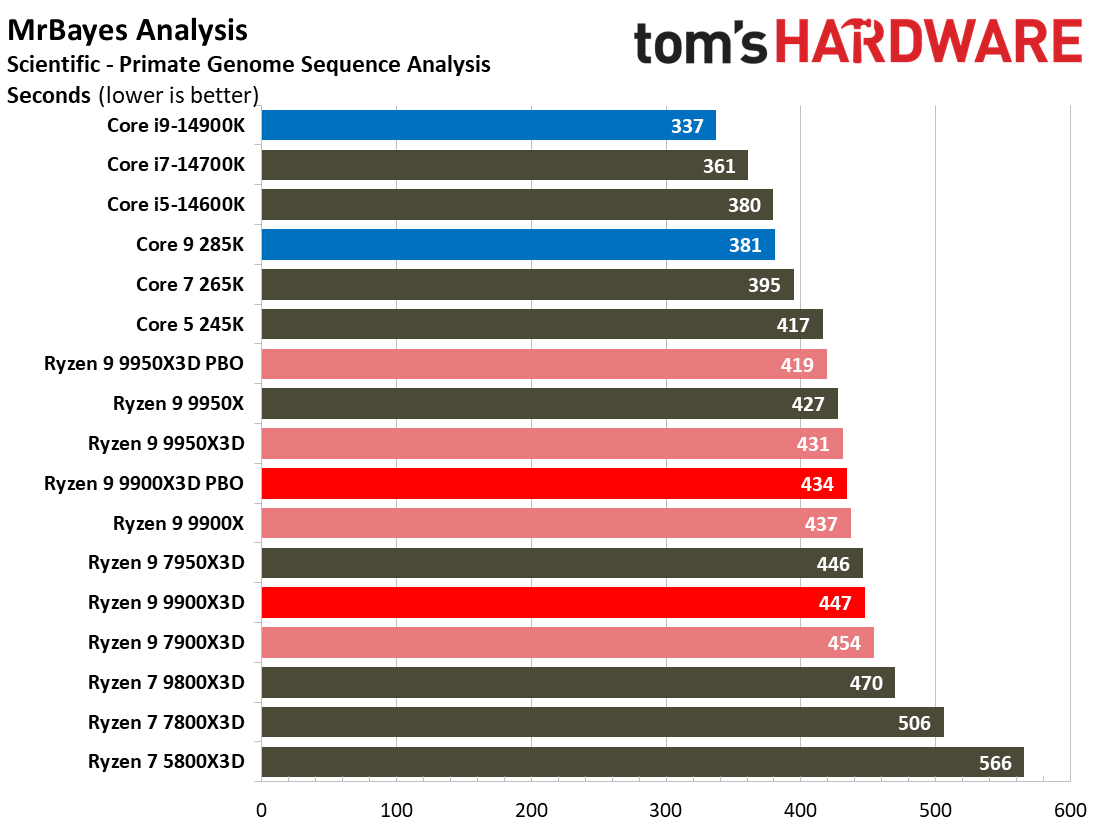
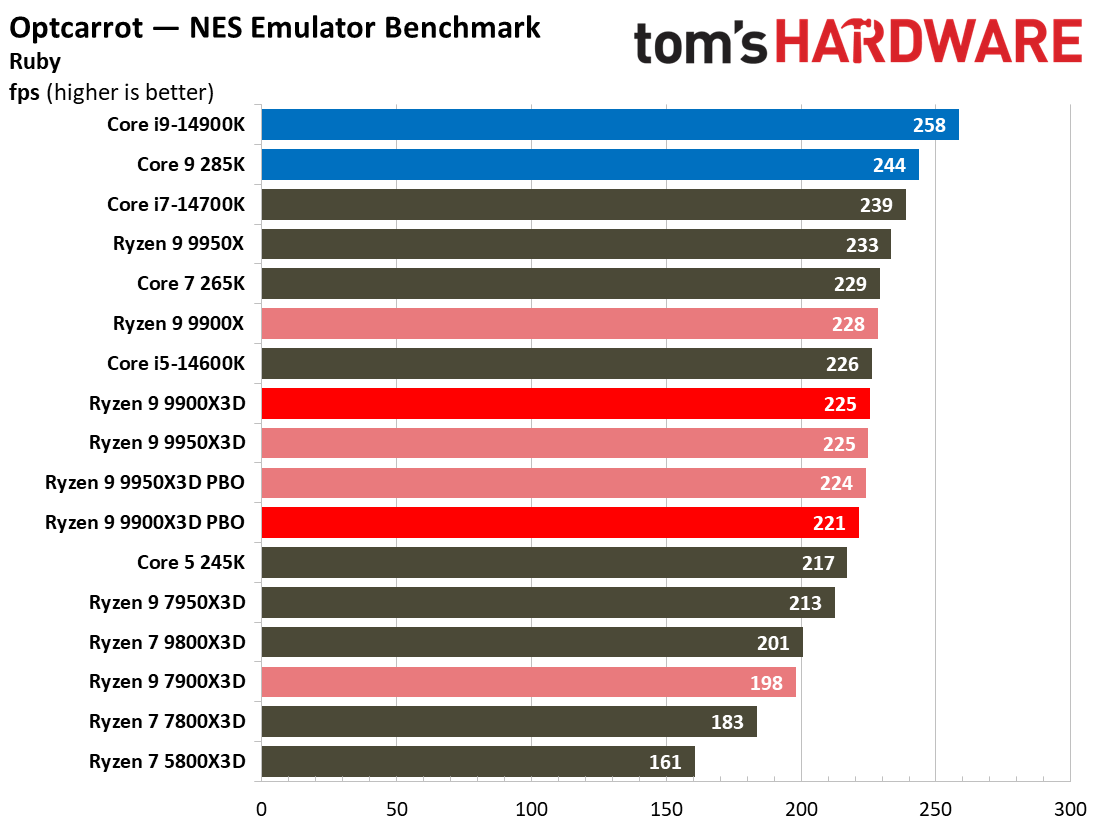
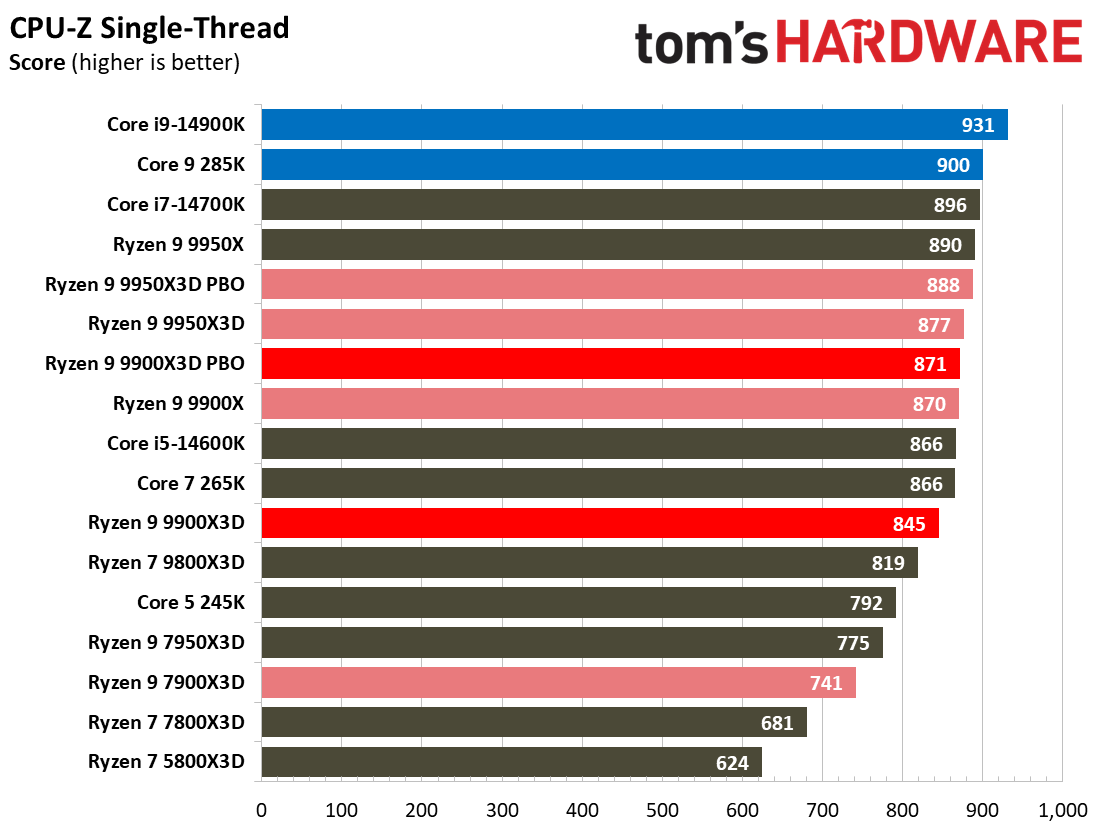
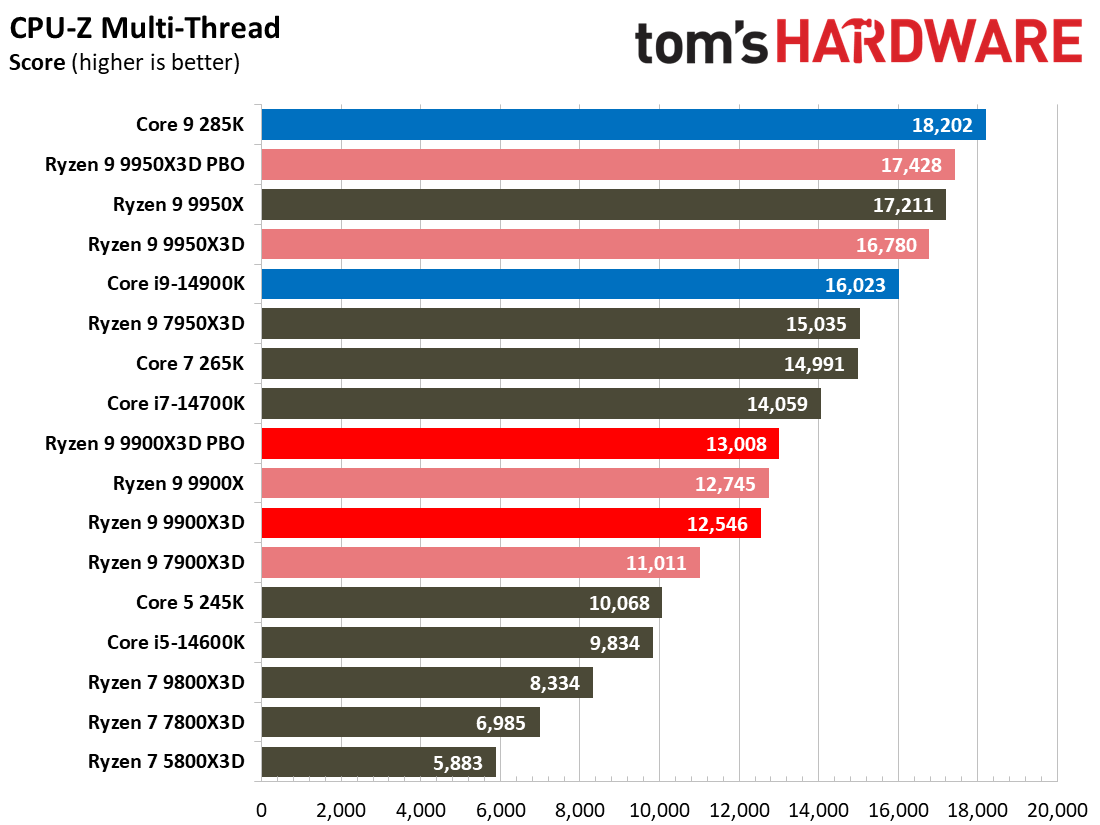
This selection of tests runs the gamut from massively parallel molecular dynamics simulation code in NAMD to compression/decompression performance.
Y-cruncher computes Pi with the AVX instruction set, making for an exceedingly demanding benchmark. This benchmark was recently updated with specific tuning for AMD's AVX-512 implementation. The new code delivers a big boost to Ryzen, but it isn't as representative of performance in real-world applications as the older, unoptimized version. Most code simply isn't as well tuned, or doesn't utilize AVX-512 to such a heavy extent. Intel's new chips make big strides in this benchmark over the prior generation, but they only support AVX-256 natively, so AMD gets an easy win — the Ryzen 9 chips are incredibly impressive in the BPP benchmark.
The 285K takes a strong lead in the NAMD simulation code benchmark, while the AMD processors excel at most Chess engine benchmarks.
Compression, Encryption
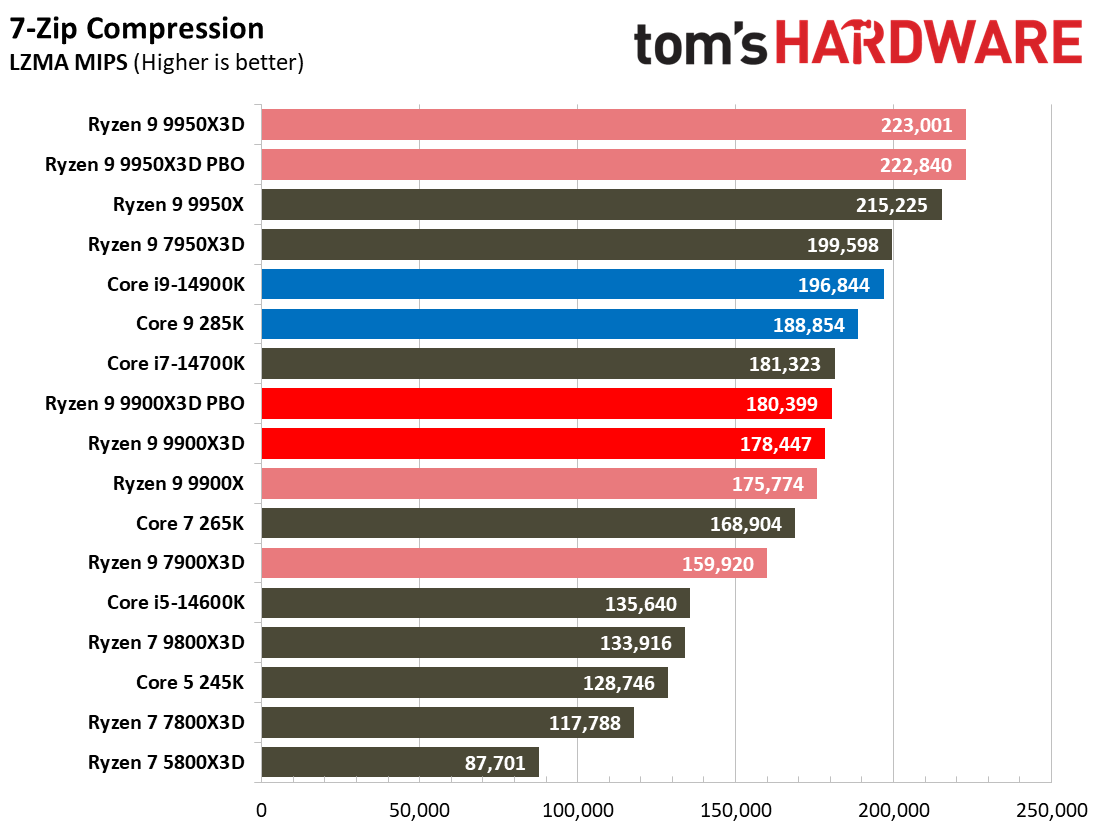
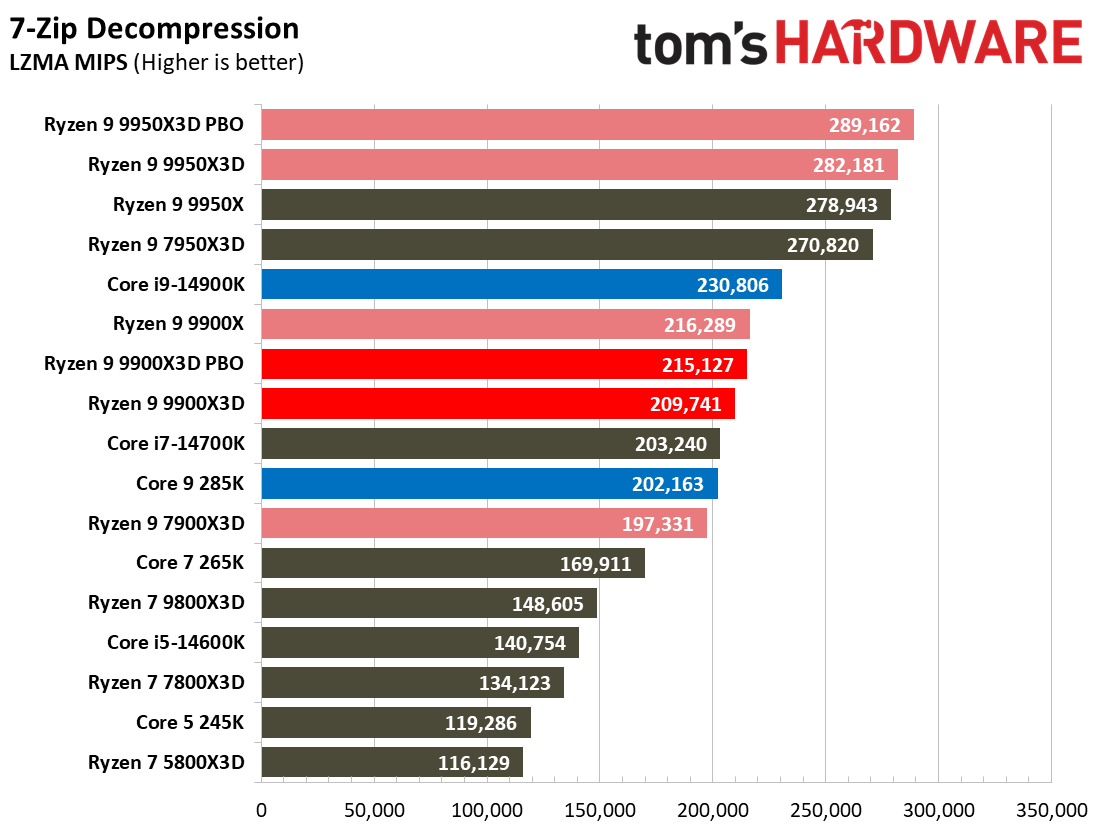
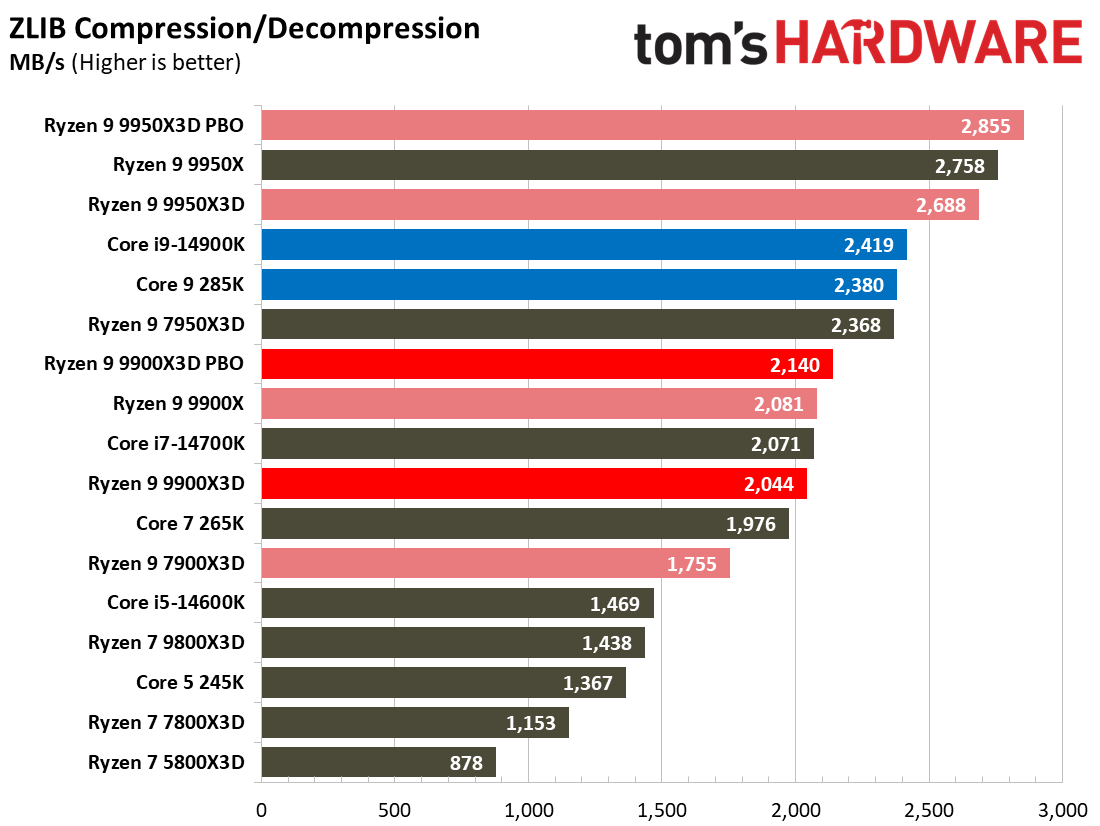
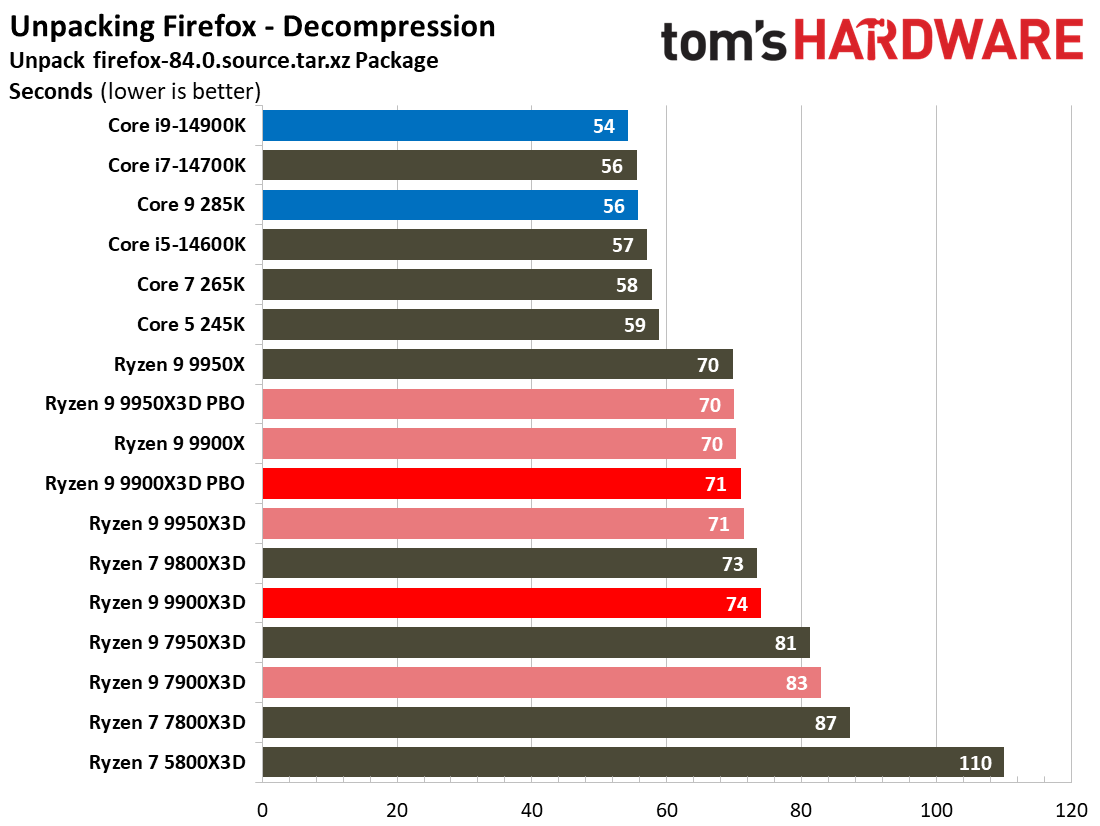
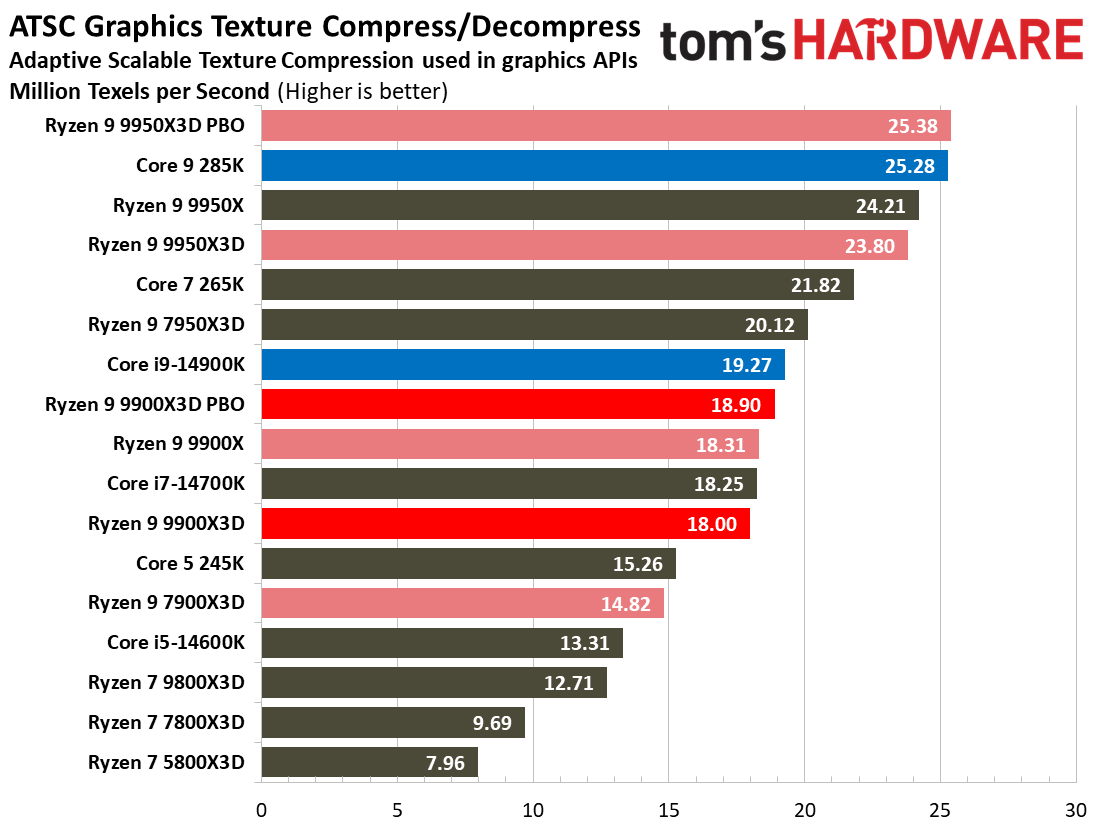
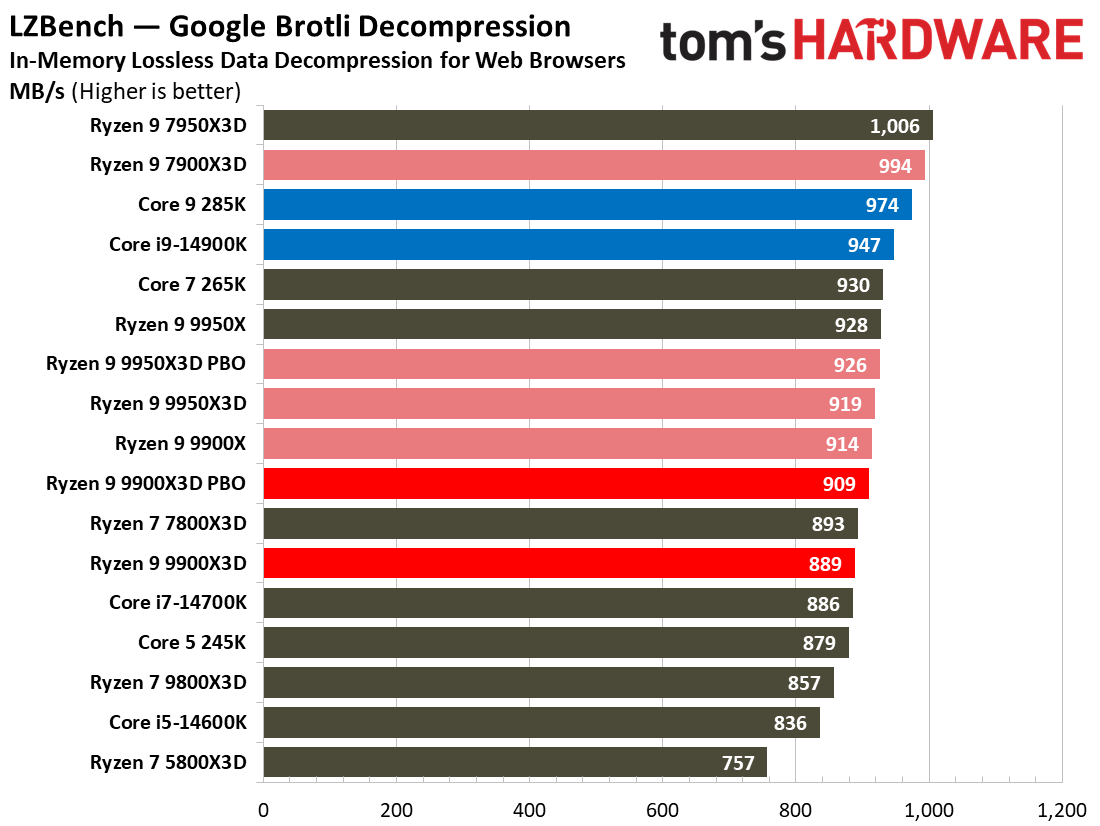
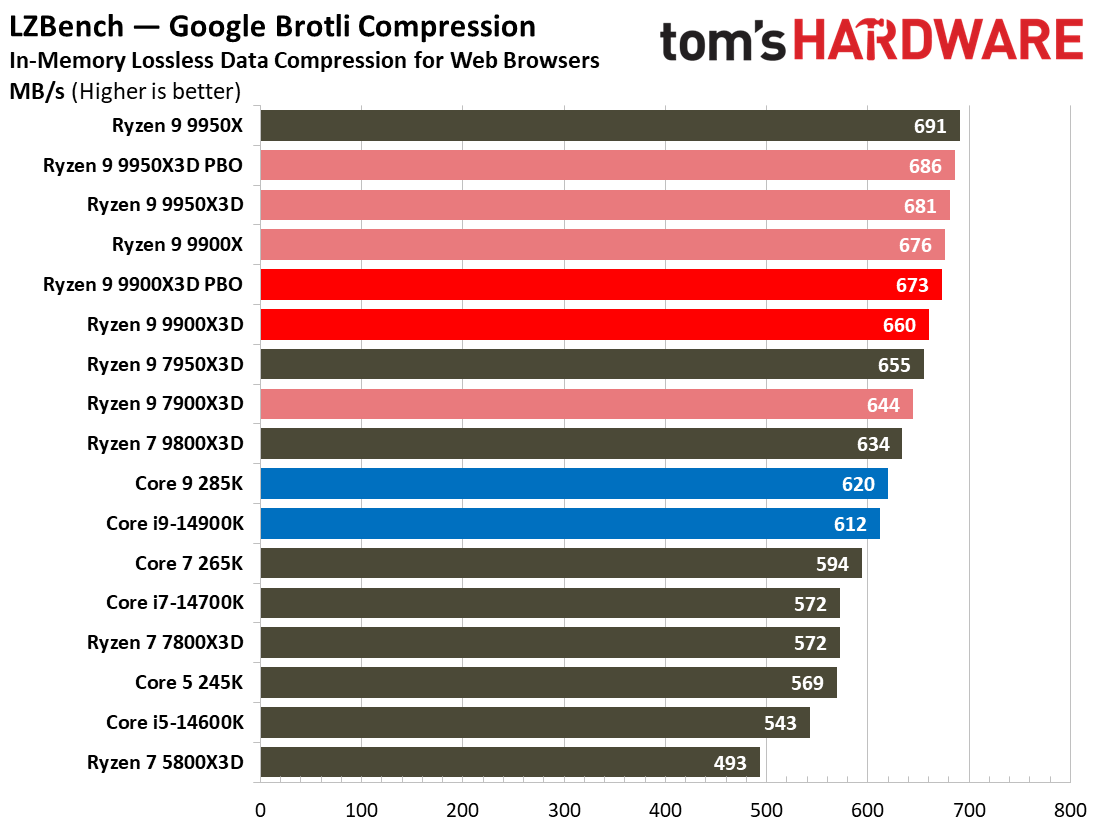
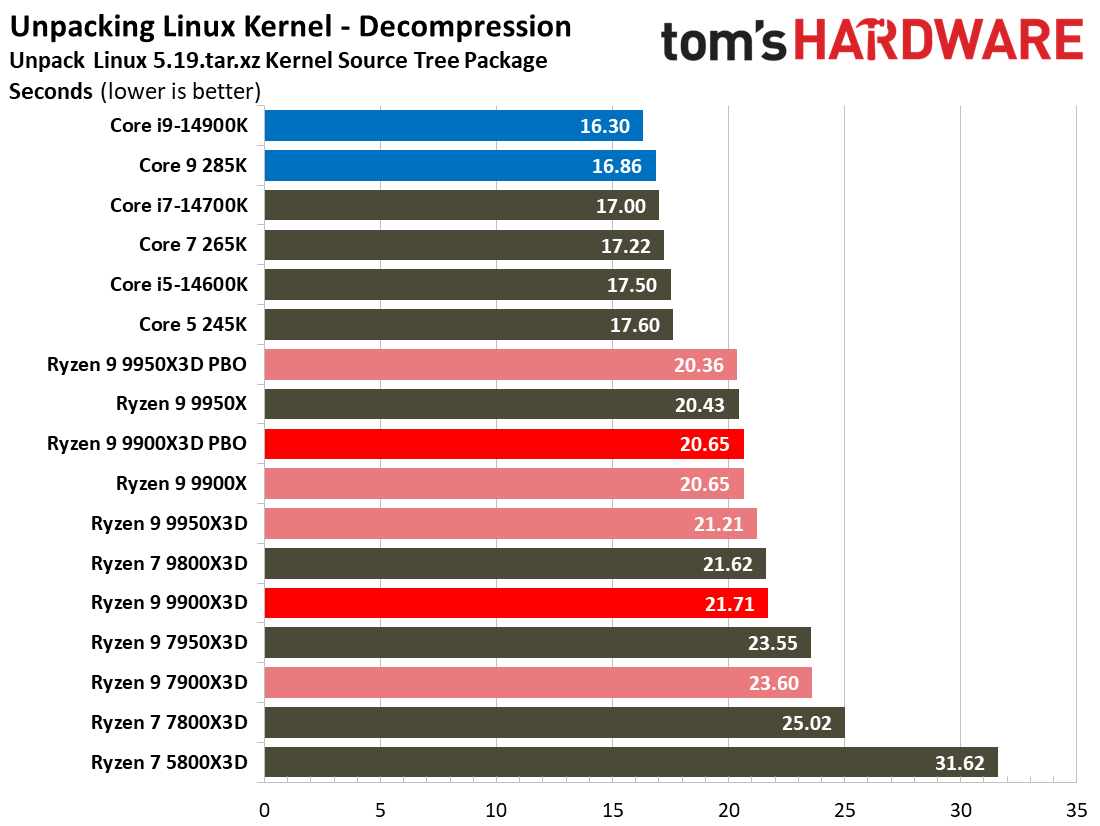
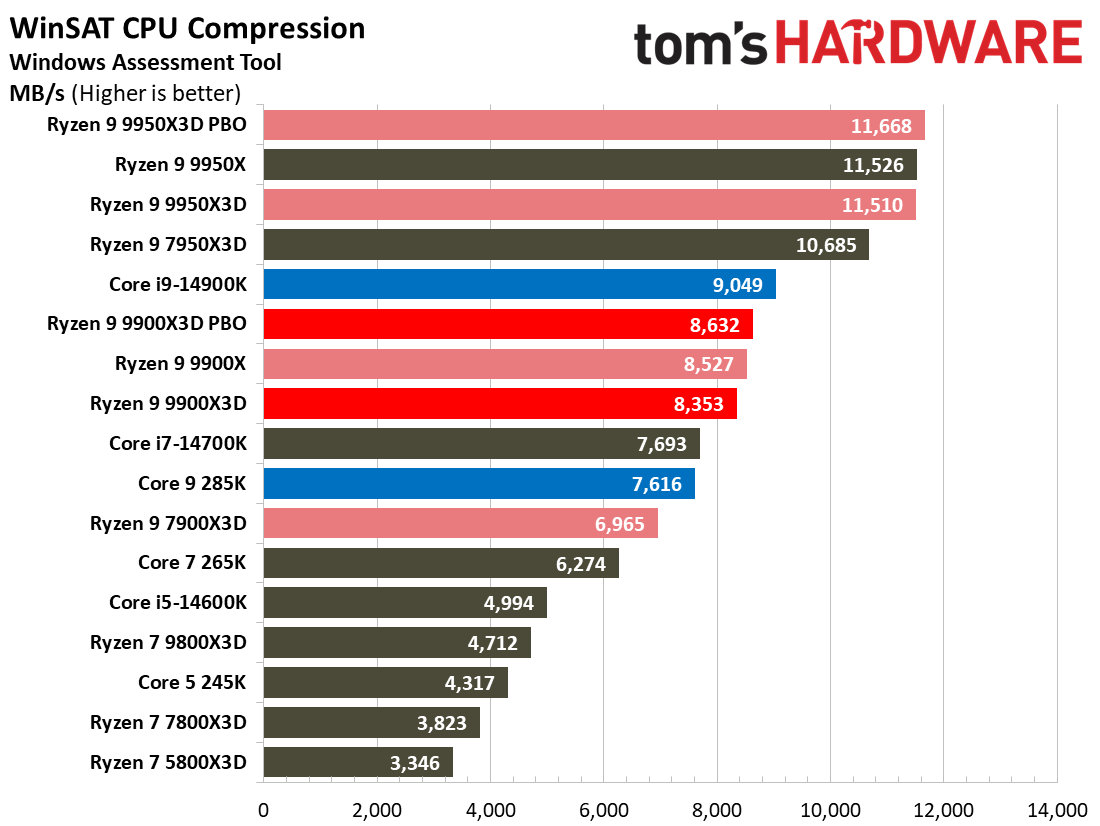

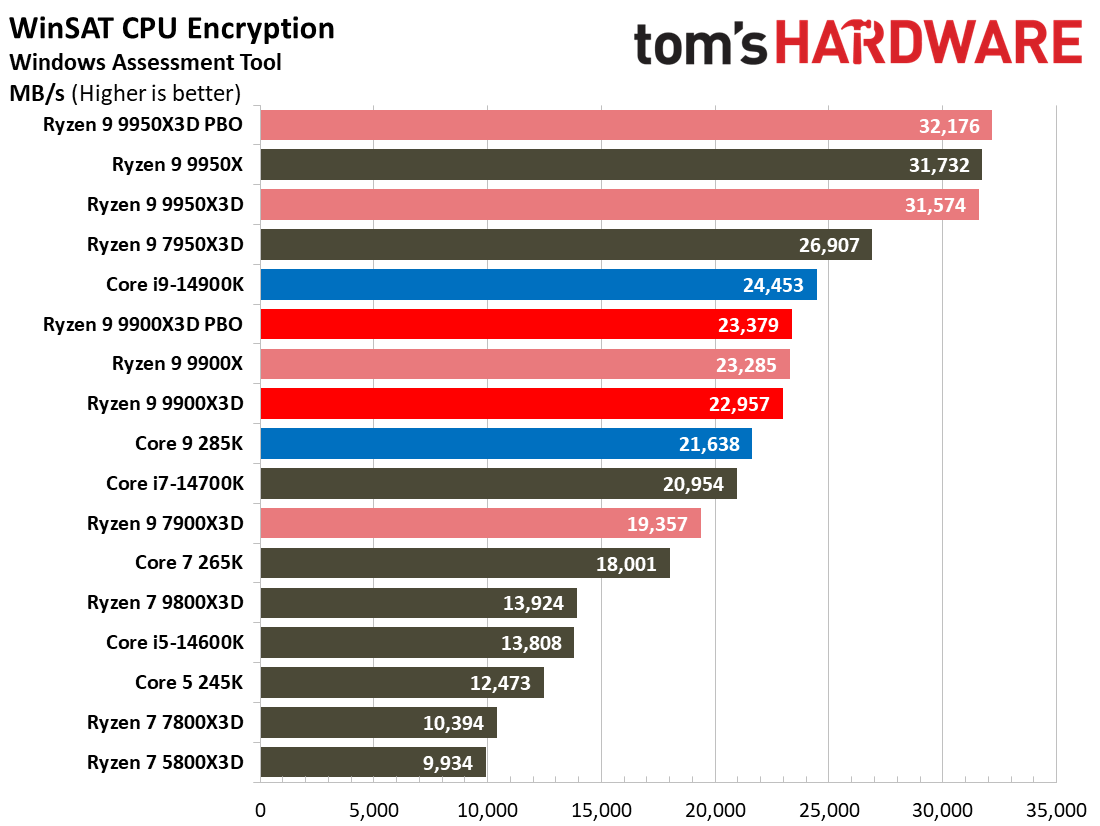
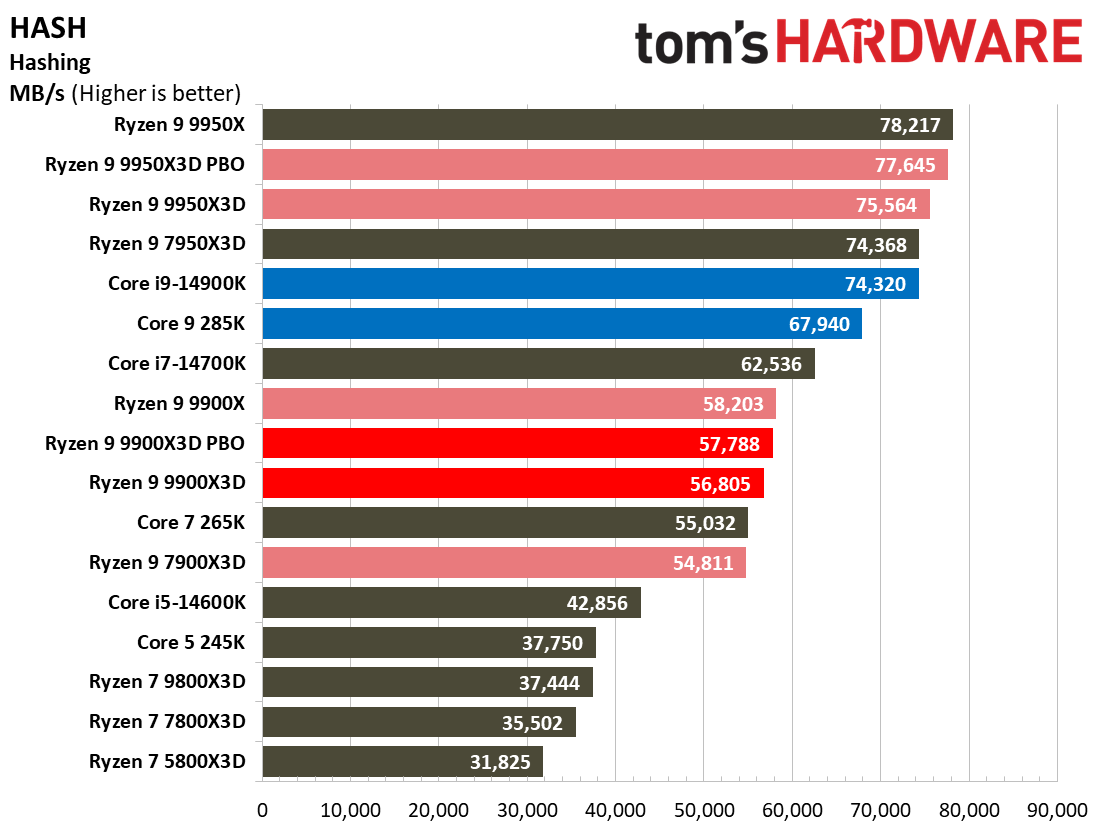

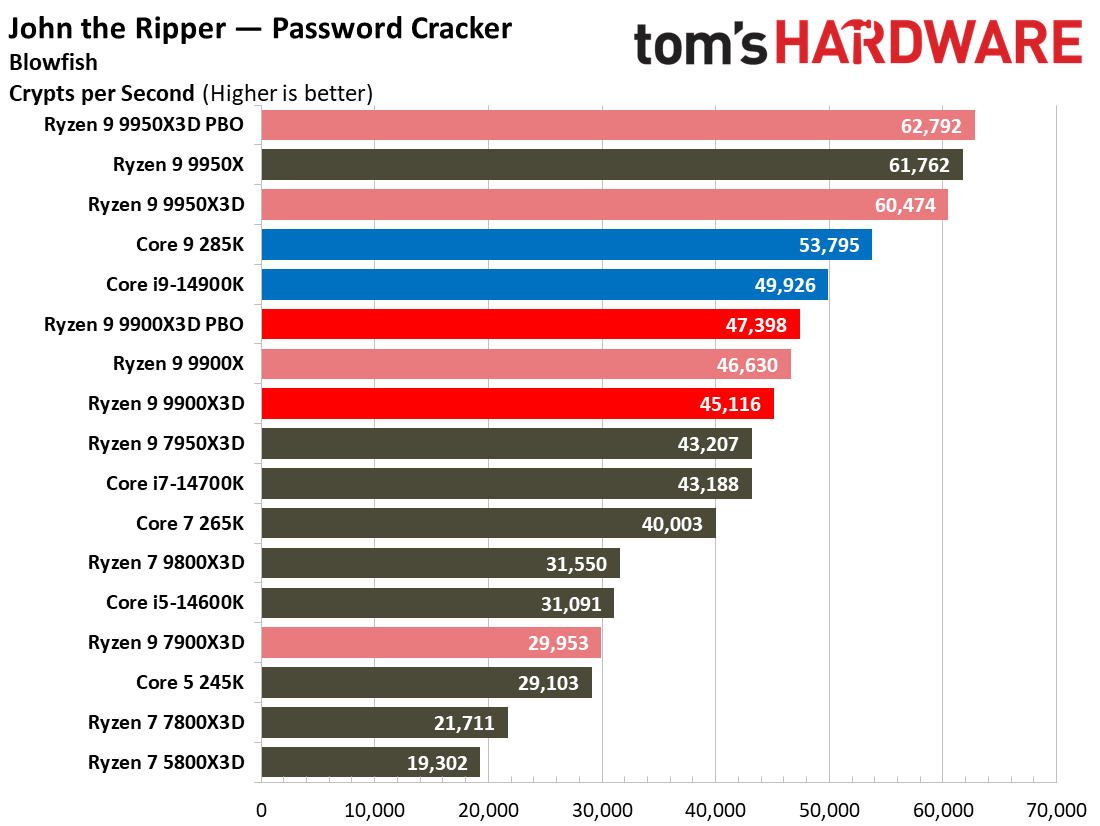
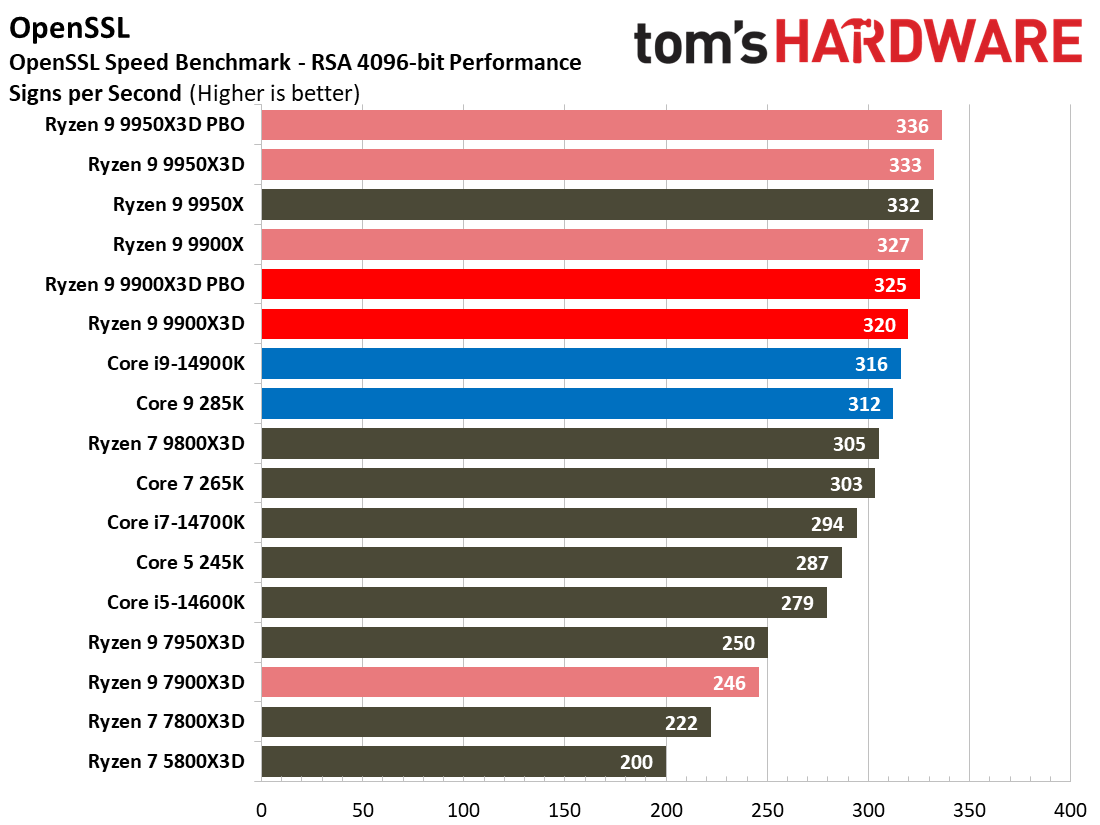
We've added several more compression, decompression, and encryption benchmarks to better capture the performance deltas in different algorithms. The Intel chips generally take the lead, but that isn't always the case. Some workloads, like Google's Brotli compression engine, favor AMD's chips.
AI Workloads, Geekbench 6
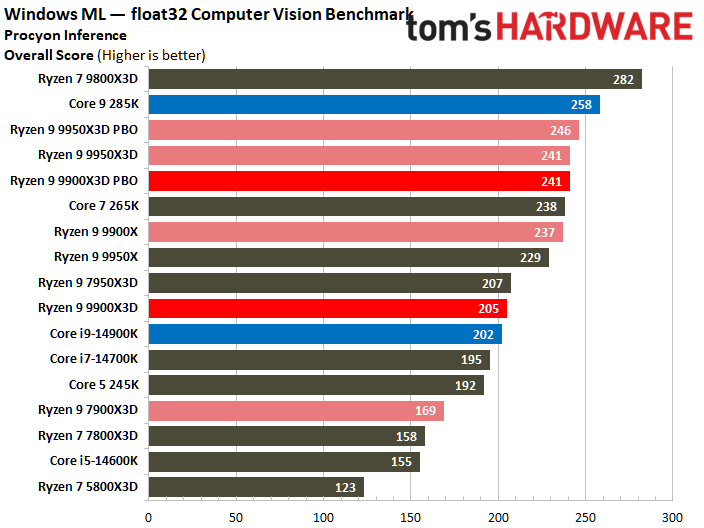
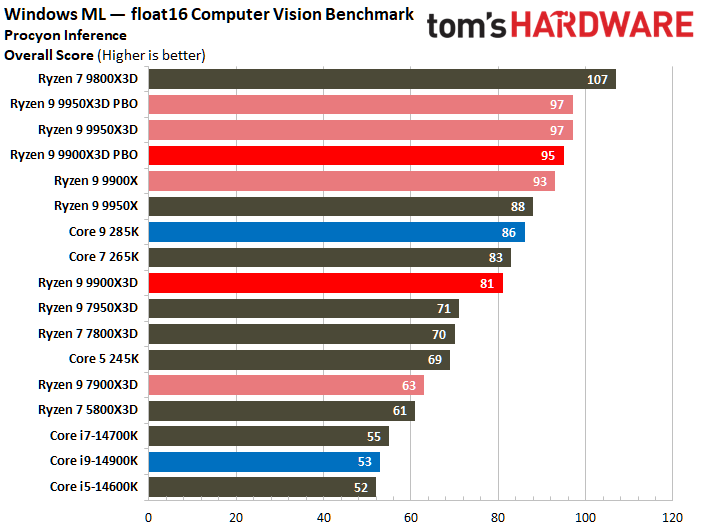
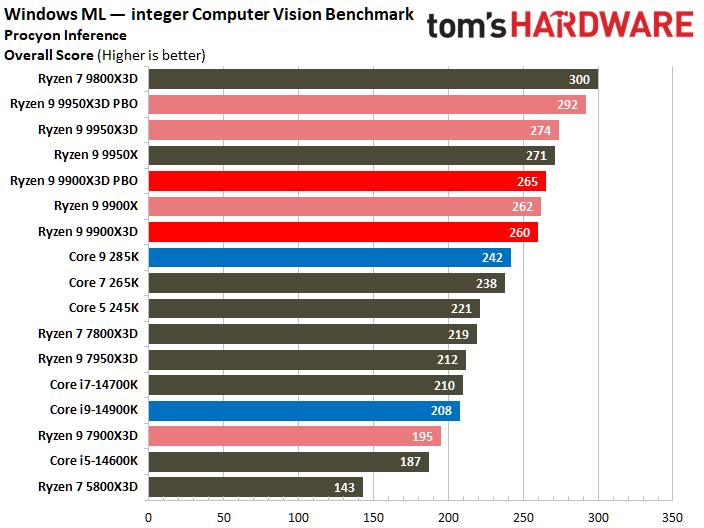
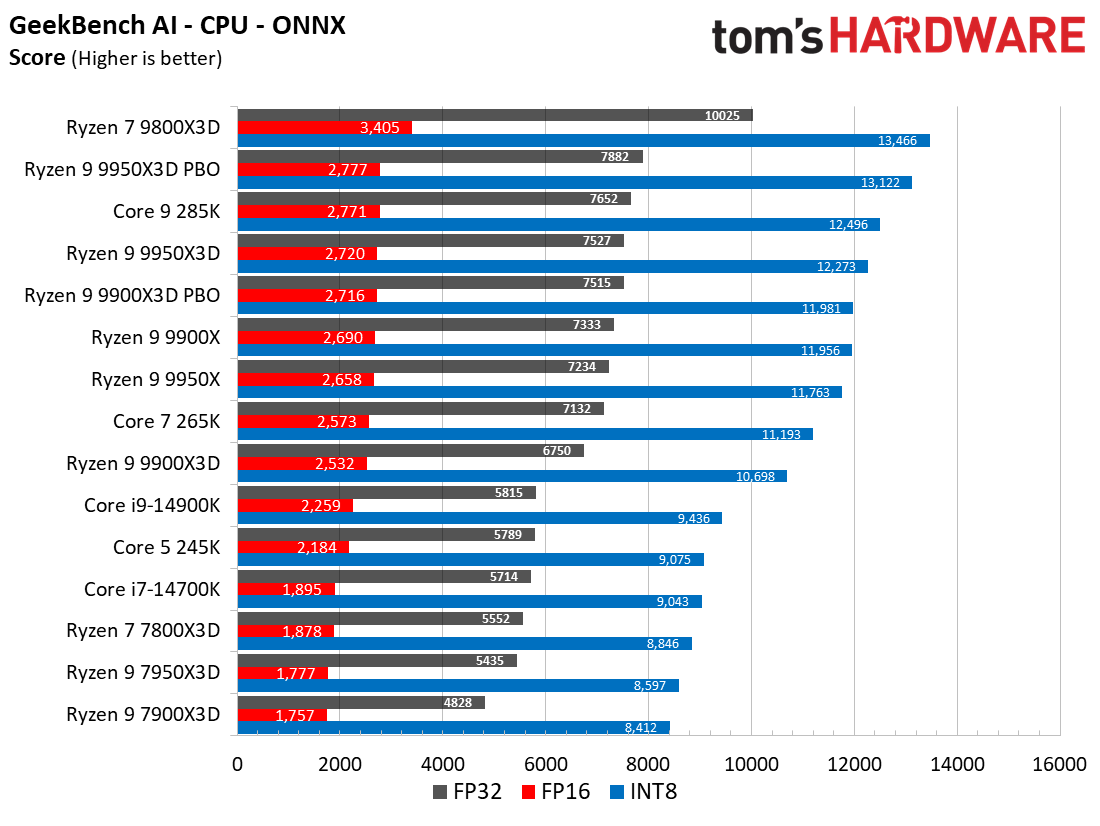

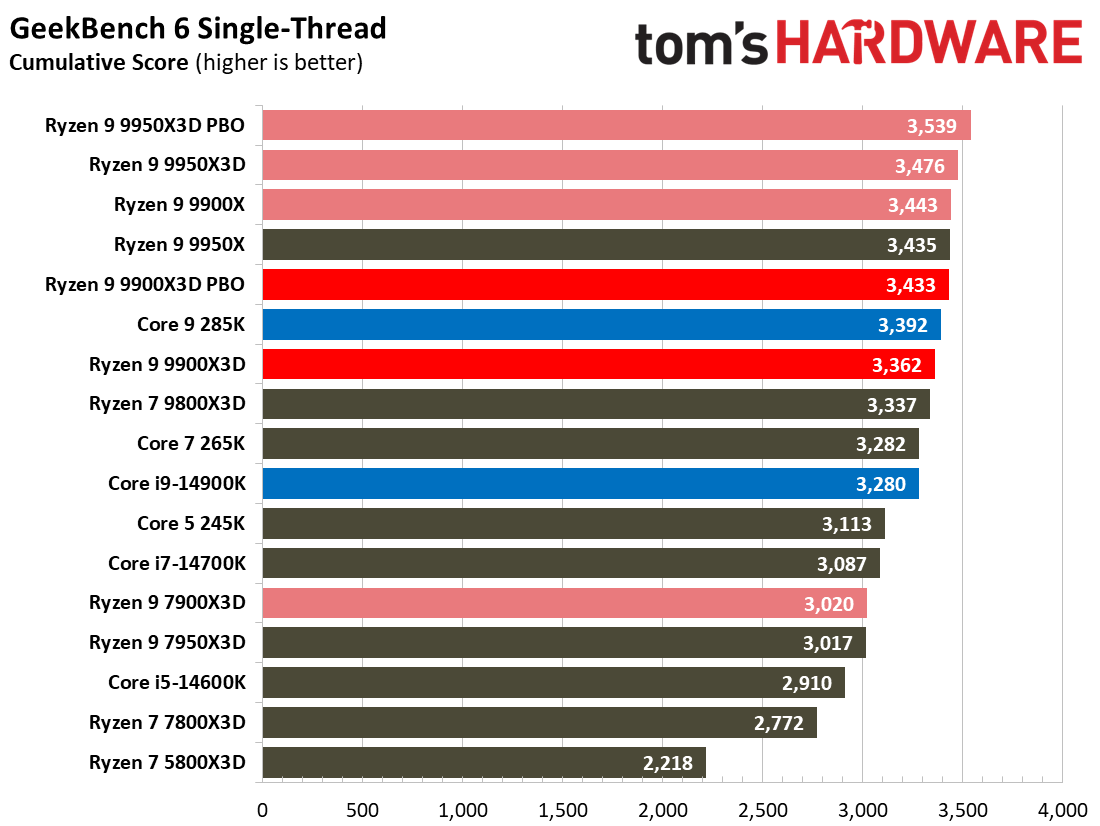
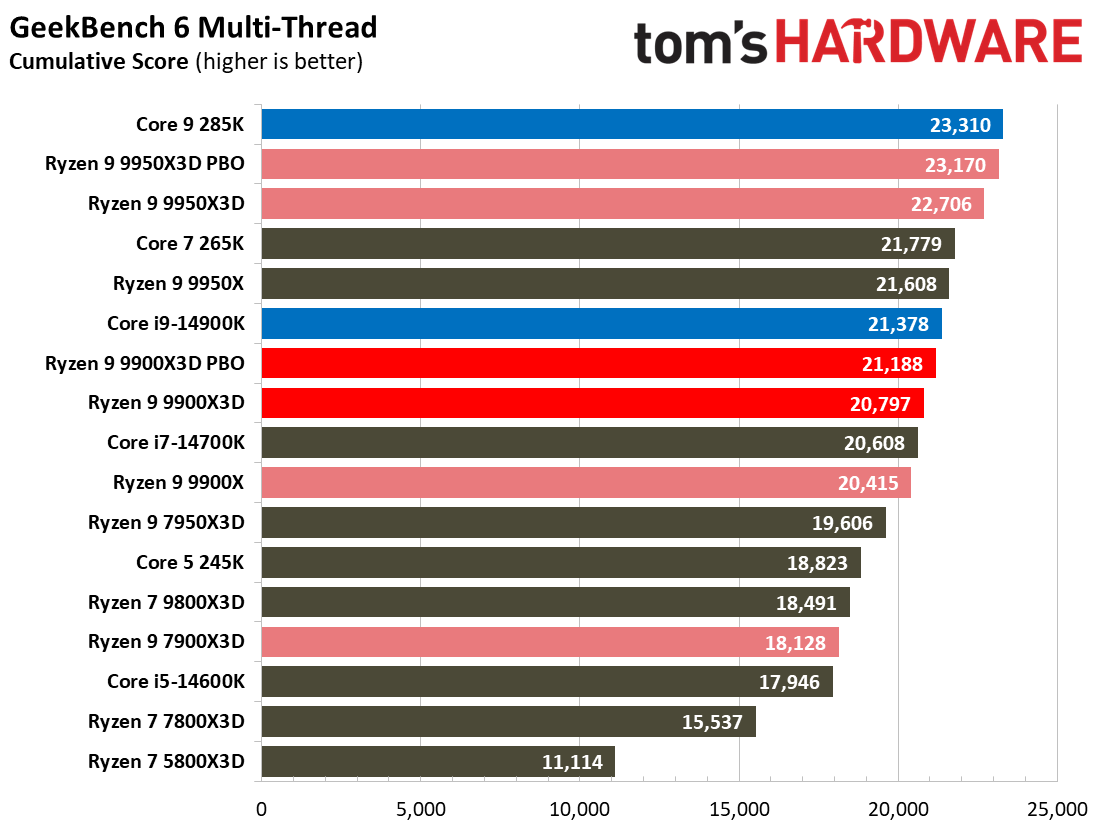
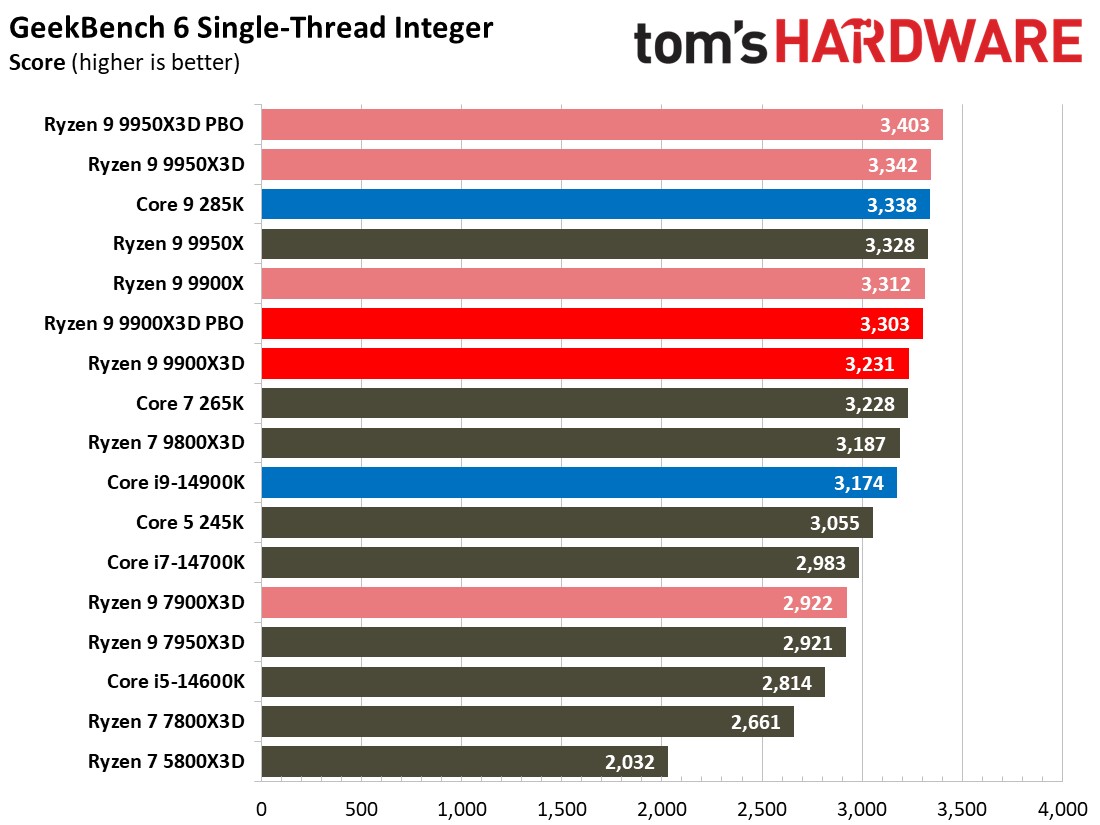
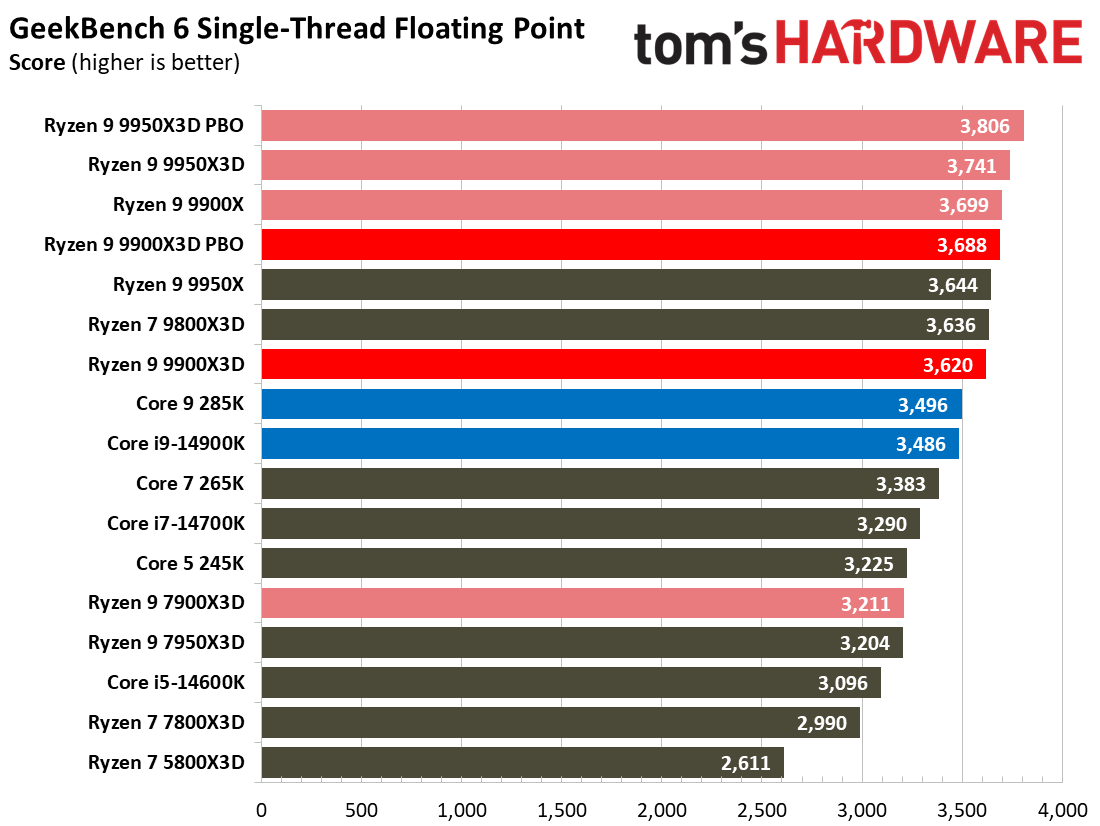
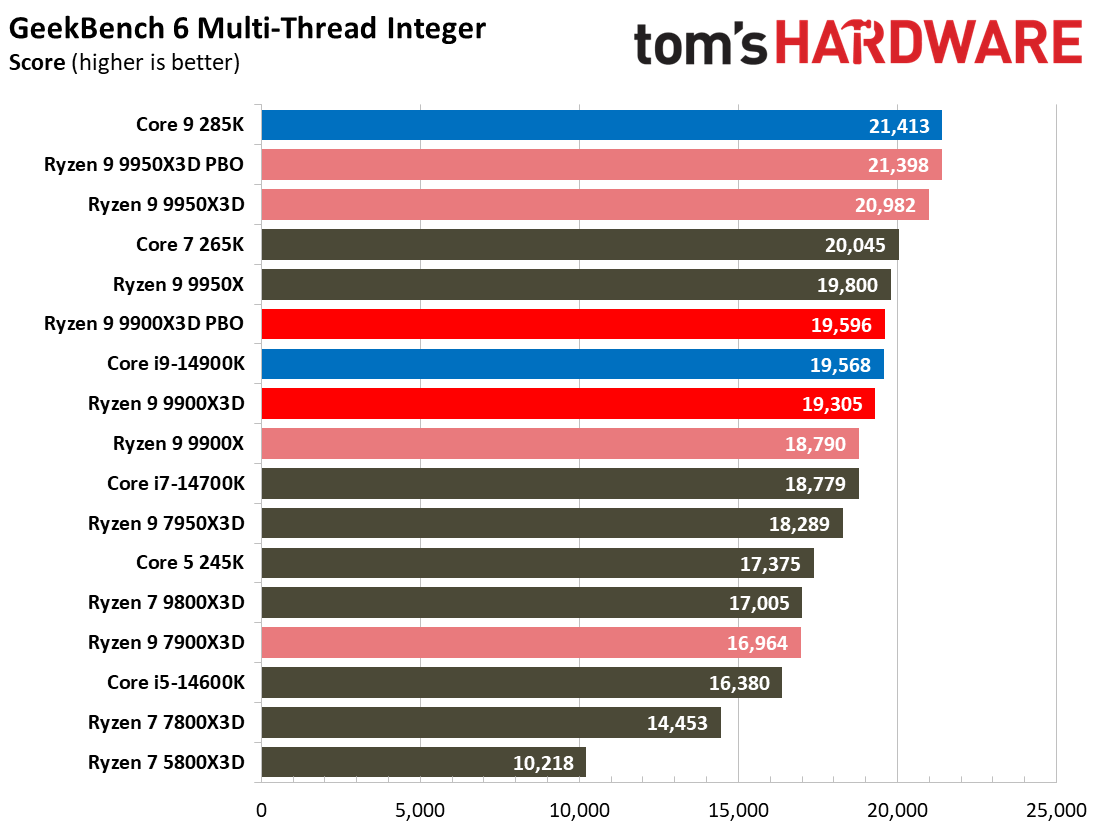
The Core Ultra 9 285K easily leads in the Procyon Computer Vision Benchmark with the larger float32 data type. However, the AMD processors are more competitive with float16 and ultimately take the lead in the integer benchmark.
The GeekBench AI results in the slide deck above show performance with the workload running on the CPU cores via OpenVino and ONNX. Only two CPUs in this group have in-built NPUs — the Core Ultra 9 285K and Ultra 7 265K — making them the only processors capable of running the workload on a dedicated NPU. Given that the NPU is focused on low-power inference tasks, the results are impressive relative to the performance when the workload executes on the CPU cores.
Java, PHP Workloads
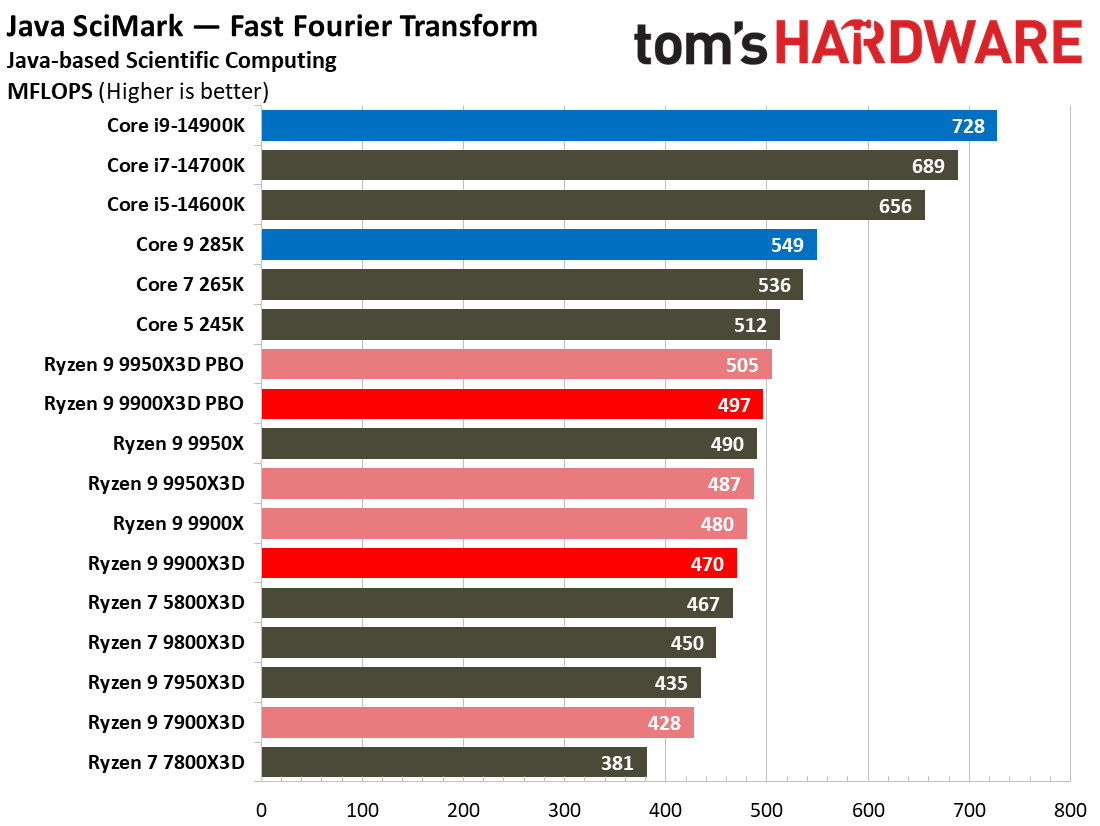

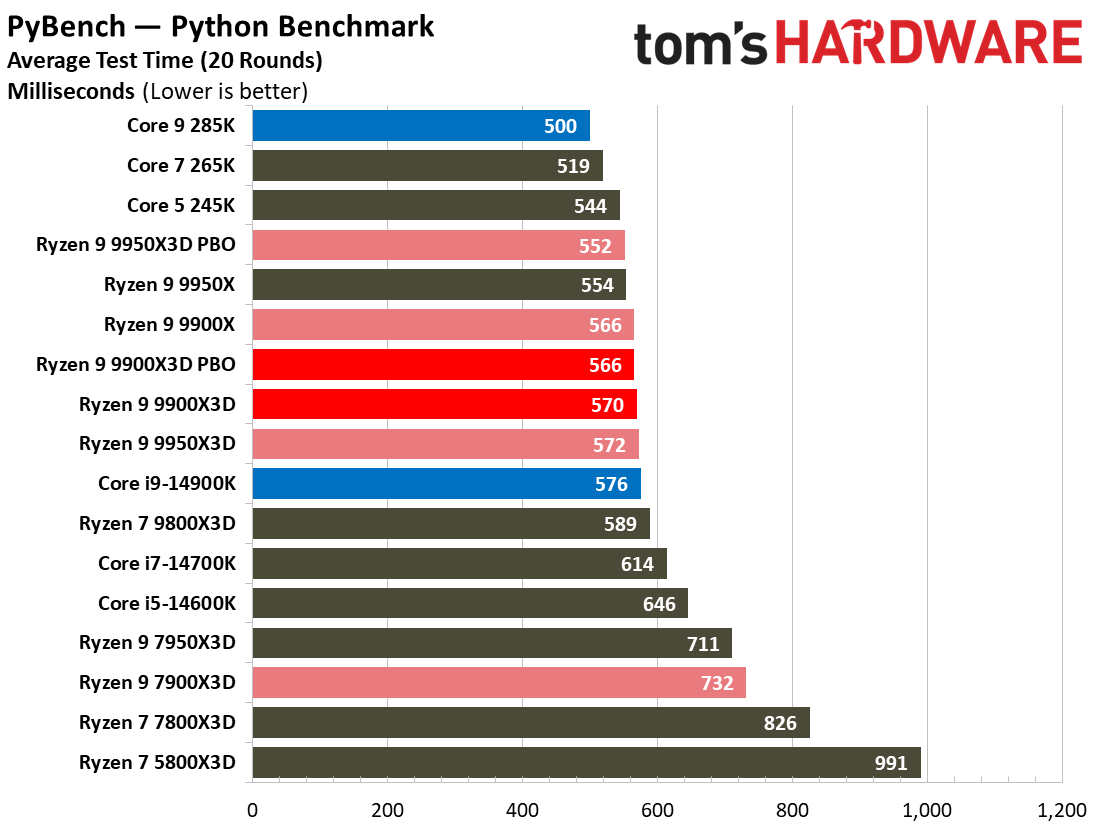
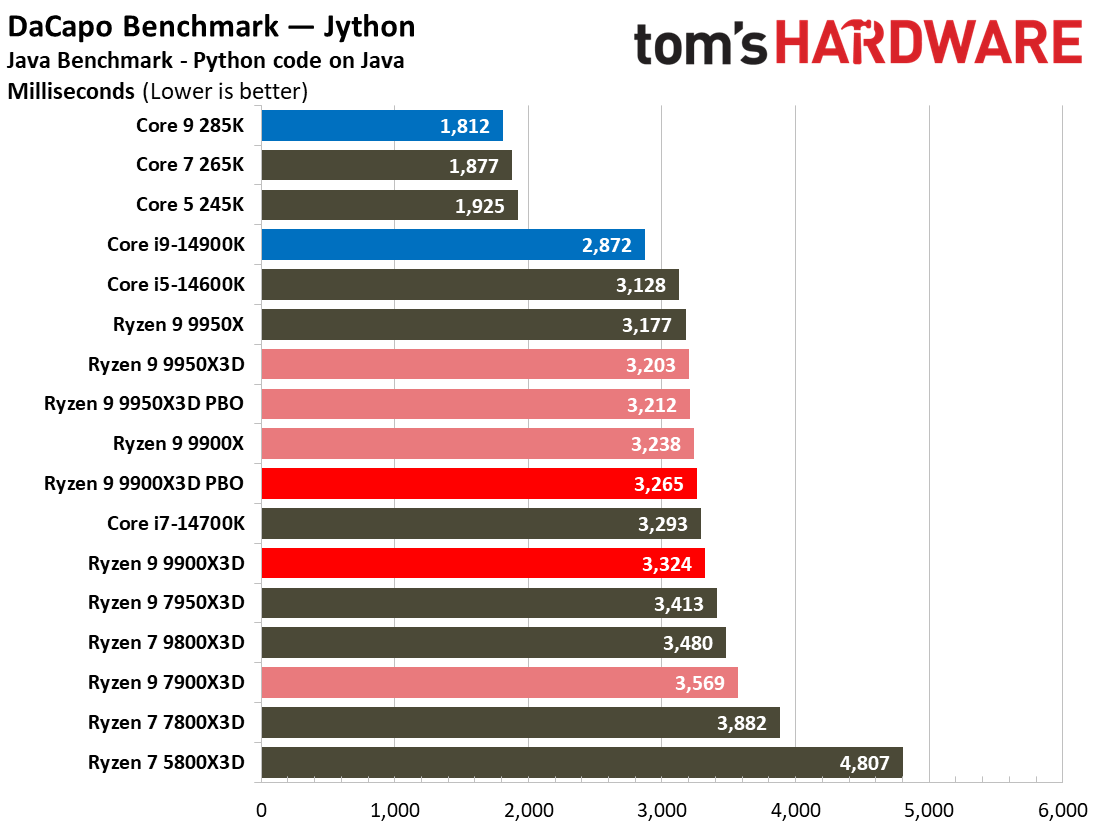
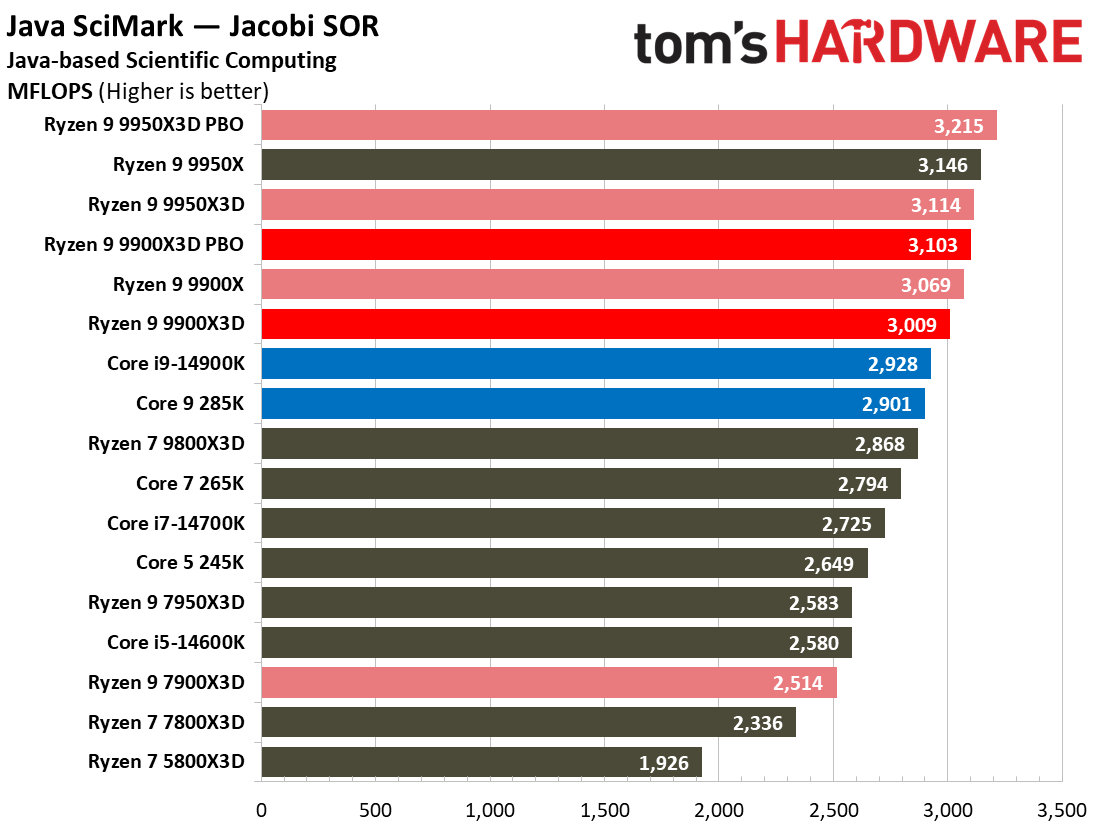
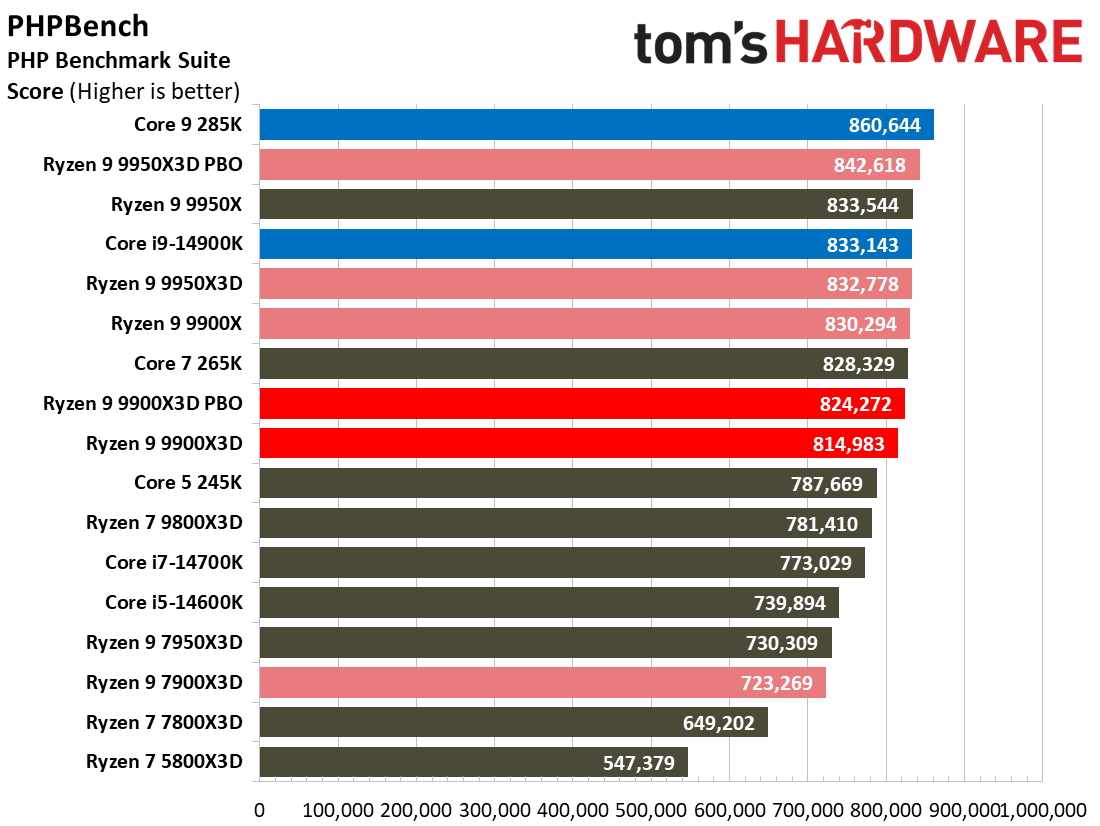
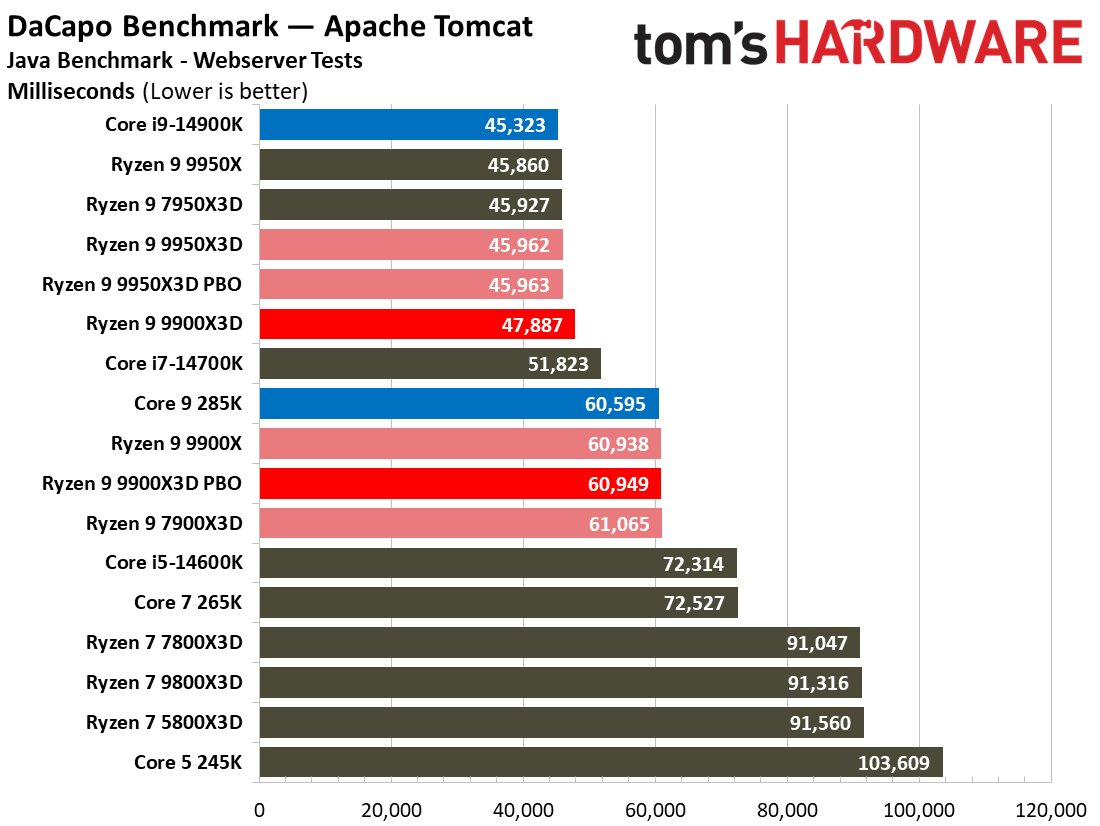
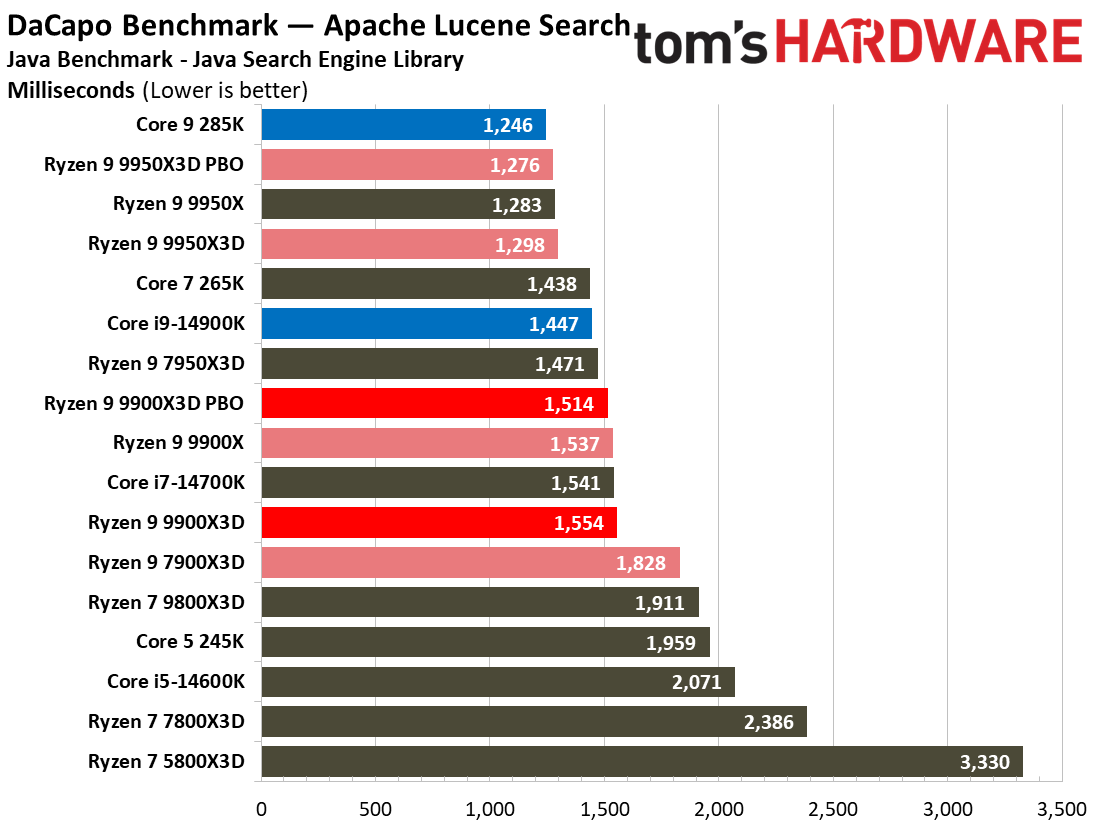
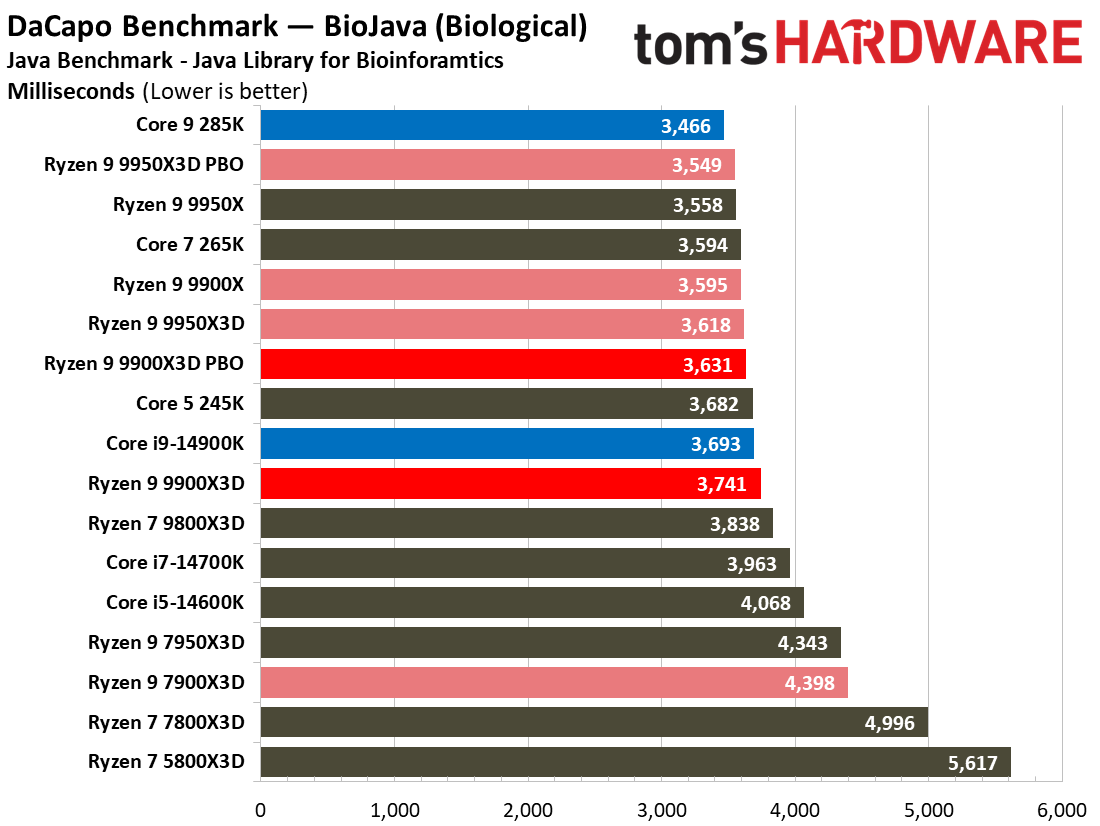
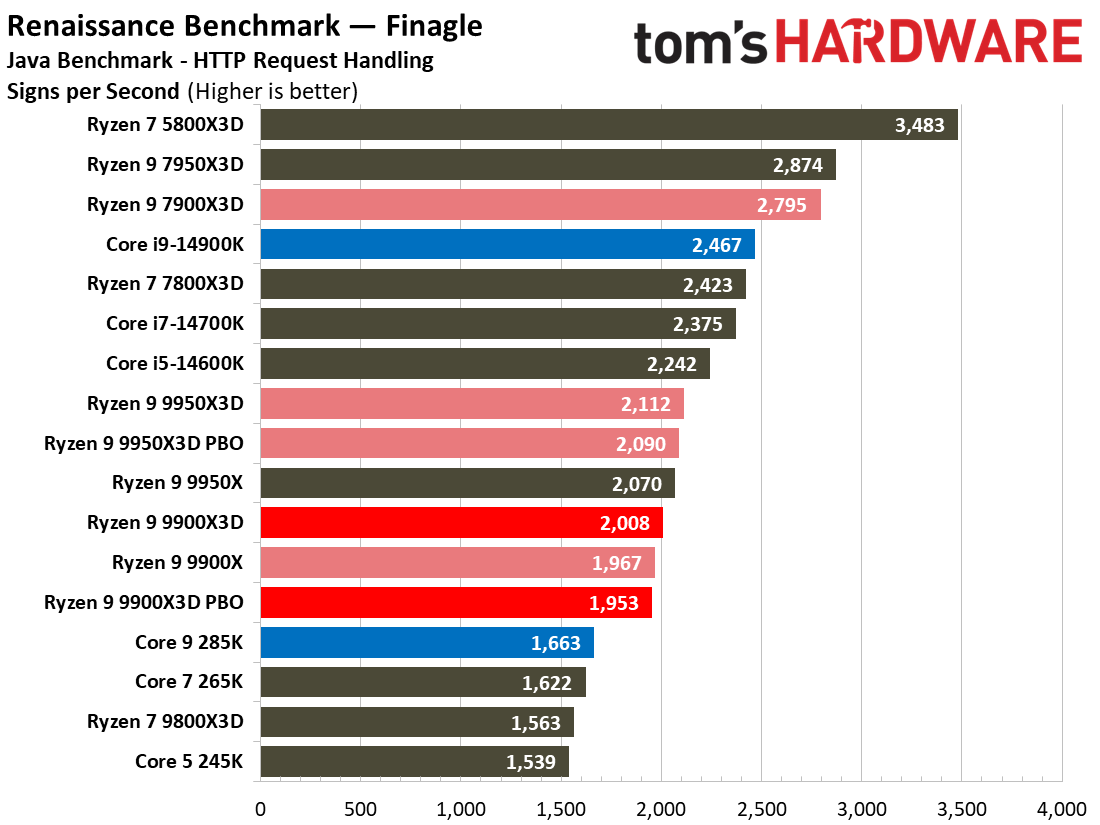
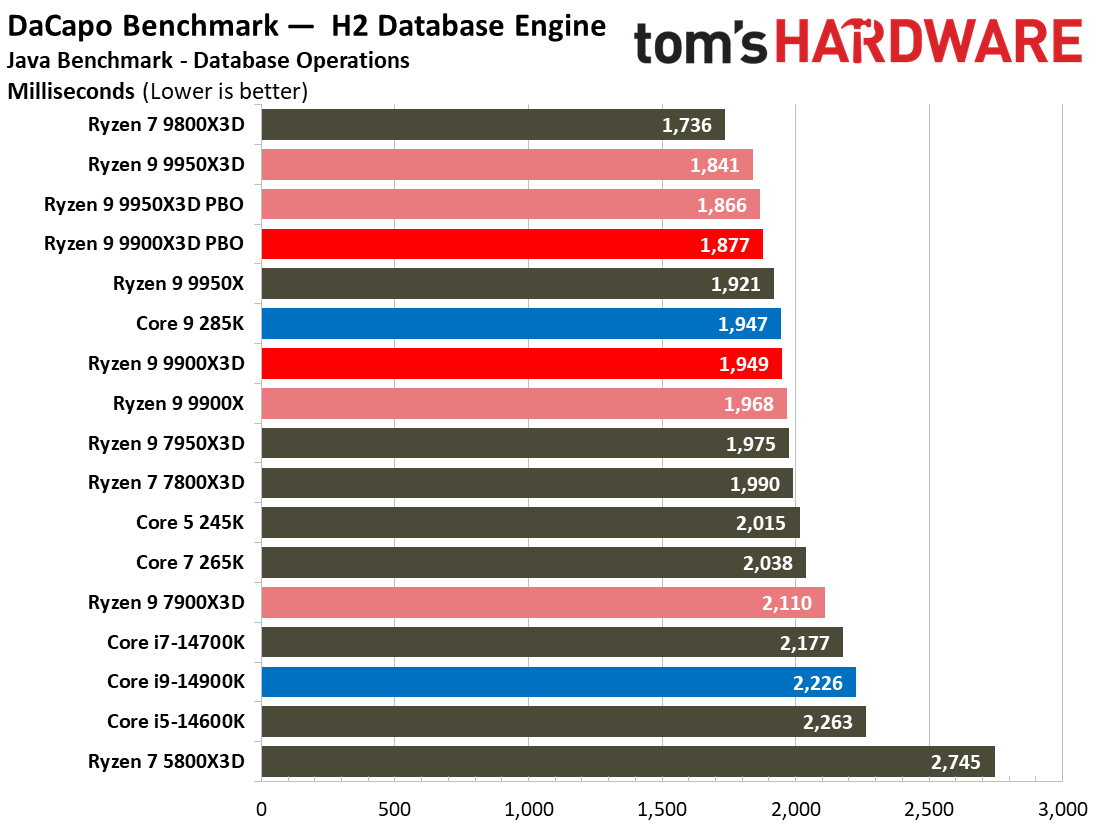
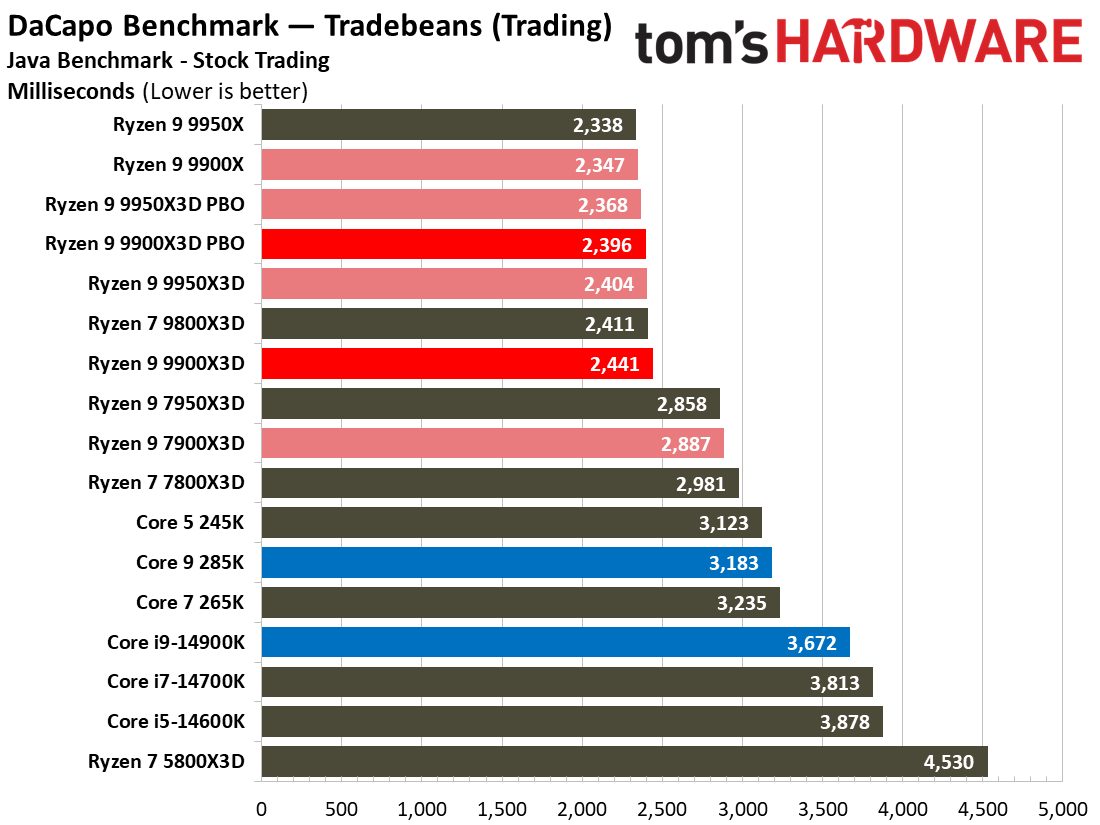
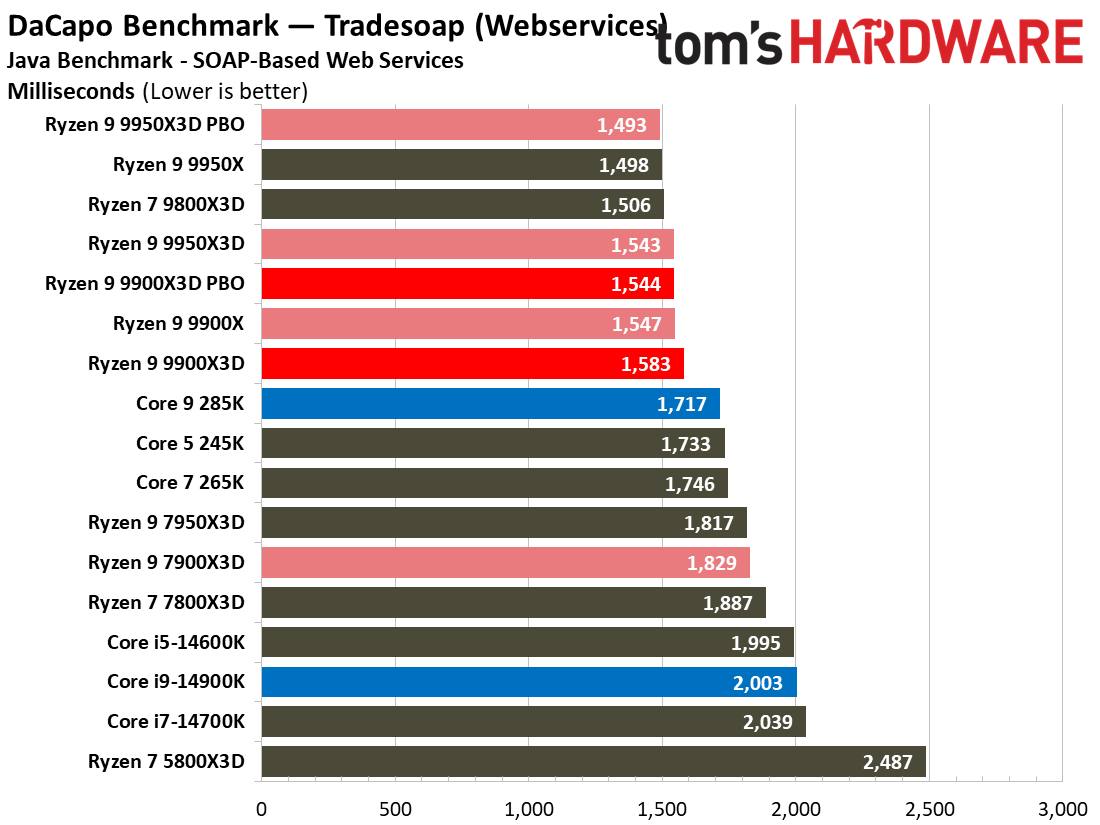
- MORE: Best CPU for gaming
- MORE: CPU Benchmark Hierarchy
- MORE: Intel vs AMD
- MORE: How to Overclock a CPU
Current page: AMD Ryzen 9 9900X3D Productivity Benchmarks
Prev Page AMD Ryzen 9 9900X3D Gaming Benchmarks Next Page Ryzen 9 9900X3D SPECworkstation 4 Benchmarks
Paul Alcorn is the Managing Editor: News and Emerging Tech for Tom's Hardware US. He also writes news and reviews on CPUs, storage, and enterprise hardware.
-
m3city High power usage in iddle, really? One could draw some conclusions based on graphs provided, but definitely not that.Reply -
Neilbob Really not sure why AMD are bothering with the #900 X3D variants. Neither the price or the performance fit, in either direction. Those 6 core chips with the extra cache would be far better diverted to a cheaper #600 X3D if there are enough defective dies to bother, that is.Reply
If it was another 50-75 of your chosen currency cheaper, then it might be more interesting. -
logainofhades I agree that they should just sell these dies as a 9600x3d, and skip the 9900x3d altogether.Reply -
Heat_Fan89 From reading and hearing several reviews (Gamers Nexus), i'm surprised that the 9950X3D and 9900X3D did not demolish the lesser and older 9800X3D. In fact Steve Burke from GN, said the 9950X3D was on par with the 9900X3D and 9800X3D. I decided for my gaming build to go with the 9800X3D, not because of price but the 9800 was the choice for a gaming rig. I recently snagged a new 9800X3D on sale from Amazon for $443.Reply -
JarredWaltonGPU Reply
Why not? Are you missing these charts?m3city said:High power usage in idle, really? One could draw some conclusions based on graphs provided, but definitely not that.
https://cdn.mos.cms.futurecdn.net/Wpec6VRKFNm8Yz2XX46WN3.pnghttps://cdn.mos.cms.futurecdn.net/MZ7DJqYn2gNn4vTHK9aWJ3.png
In idle and light workloads, AMD's CPUs are sitting about 14~17 watts higher than the Core Ultra 9 285K. Is that a terrible thing that should prevent people from buying it? No, but it is a weakness of AMD's design right now. It's something AMD should look into addressing with future designs. Because even though it's only 15W or so (that's two 60W LED bulb equivalents), it should be possible to get that power use down.
Imagine a phone or mobile device that used almost 3X more power at idle than the competition. That would be a major concern. And in light workloads like YouTube, if it had to use twice as much power, that would also be bad.
Some people seem to think the pros and cons are us screaming "THESE ARE AMAZING ASPECTS" and "THESE ARE TEH WORST ASPECTS" but they're really just a high-level summary of some key points — things that are going well, things that could be improved (without the shouting).
I'm not sure why anyone would be surprised that, in gaming, the 8-core X3D and the 8-core X3D plus 8-core standard CCDs perform better in games than a 6-core X3D plus 6-core standard configuration. The whole point of the X3D is to shift cache-sensitive workloads to that CCD, away from the other CCD that lacks the extra cache.Heat_Fan89 said:From reading and hearing several reviews (Gamers Nexus), i'm surprised that the 9950X3D and 9900X3D did not demolish the lesser and older 9800X3D. In fact Steve Burke from GN, said the 9950X3D was on par with the 9900X3D and 9800X3D. I decided for my gaming build to go with the 9800X3D, not because of price but the 9800 was the choice for a gaming rig. I recently snagged a new 9800X3D on sale from Amazon for $443.
It's a whitelist software solution (meaning, AMD explicitly lists which games should effectively disable the non-X3D CCD), and not everything benefits. But as we've seen plenty of times in the past, the dual-CCD (and quad-/hex-/octal-CCD Threadripper) solutions add latency to memory and cache transactions and that reduces gaming performance.
In fact, that's precisely the problem Intel has with Arrow Lake: higher memory latency means lower gaming performance. -
usertests Reply
Higher margin on the chip, perhaps? Although the street price is already below MSRP.Neilbob said:Really not sure why AMD are bothering with the #900 X3D variants. Neither the price or the performance fit, in either direction. Those 6 core chips with the extra cache would be far better diverted to a cheaper #600 X3D if there are enough defective dies to bother, that is.
This should be the last hurrah for the awkward AMD 12-cores. Zen 6 will move to 12-core chiplets. The equivalent chip in that lineup might have 16, 18, or 20 cores, a minimum of 8 cores in each CCX. The 3D cache whitelisting problem could persist, but the single-CCD 9800X3D successor will have 12 cores and walk all over the 9900X3D in every scenario. -
Neilbob Reply
Oh, I definitely understand the reason for it, but I like to delude myself in to thinking that AMD would do something 'nice' for us dinky liddle consumers. I know; I may as well wish for world peace, with a mysterious multi-million inheritance thrown in.usertests said:Higher margin on the chip, perhaps? Although the street price is already below MSRP.
Then again, I can't see how a 9600X3D wouldn't sell like hot cakes at 300, or even a bit more. -
usertests Reply
The other reason they are wary of doing a wide, early release of 6-core X3D is because it clearly undercuts the 8-core X3D for the many games that are fine running on 6 fast cores.Neilbob said:Oh, I definitely understand the reason for it, but I like to delude myself in to thinking that AMD would do something 'nice' for us dinky liddle consumers. I know; I may as well wish for world peace, with a mysterious multi-million inheritance thrown in.
Then again, I can't see how a 9600X3D wouldn't sell like hot cakes at 300, or even a bit more.
They could probably get away with charging $350 for a 9600X3D, but if it costs about the same to make as $480+ 9800X3D due to high yields, a chunk of money is left on the table. So it will probably get introduced much later in this generation when enough defective chips are accumulated, following the pattern. -
Albert.Thomas "We measured the Core Ultra 9 285K at 20W under these conditions, but the Ryzen 9 9900X3D consumed 37W. While we can see that the 9900X3D has improved compared to the previous-gen Ryzen 7000X3D models, this is still a significantly higher amount of active idle power draw than the Intel chips."Reply
What about medium-light conditions Paul?
I've been able to pull a (relatively) insane amount of power with the 9950X3D just by spinning my mouse around really quickly.
With the disclaimer that I haven't tested this in detail, it appears that AMD's flagship X3D CPU is much less efficient below 100W, but is more efficient above 100W. -
Notton What AMD really needs is an 8+4, not a 6+6Reply
Although, judging by the amount of binned 4-cores they sell, it seems the yields are so good they have almost none.
